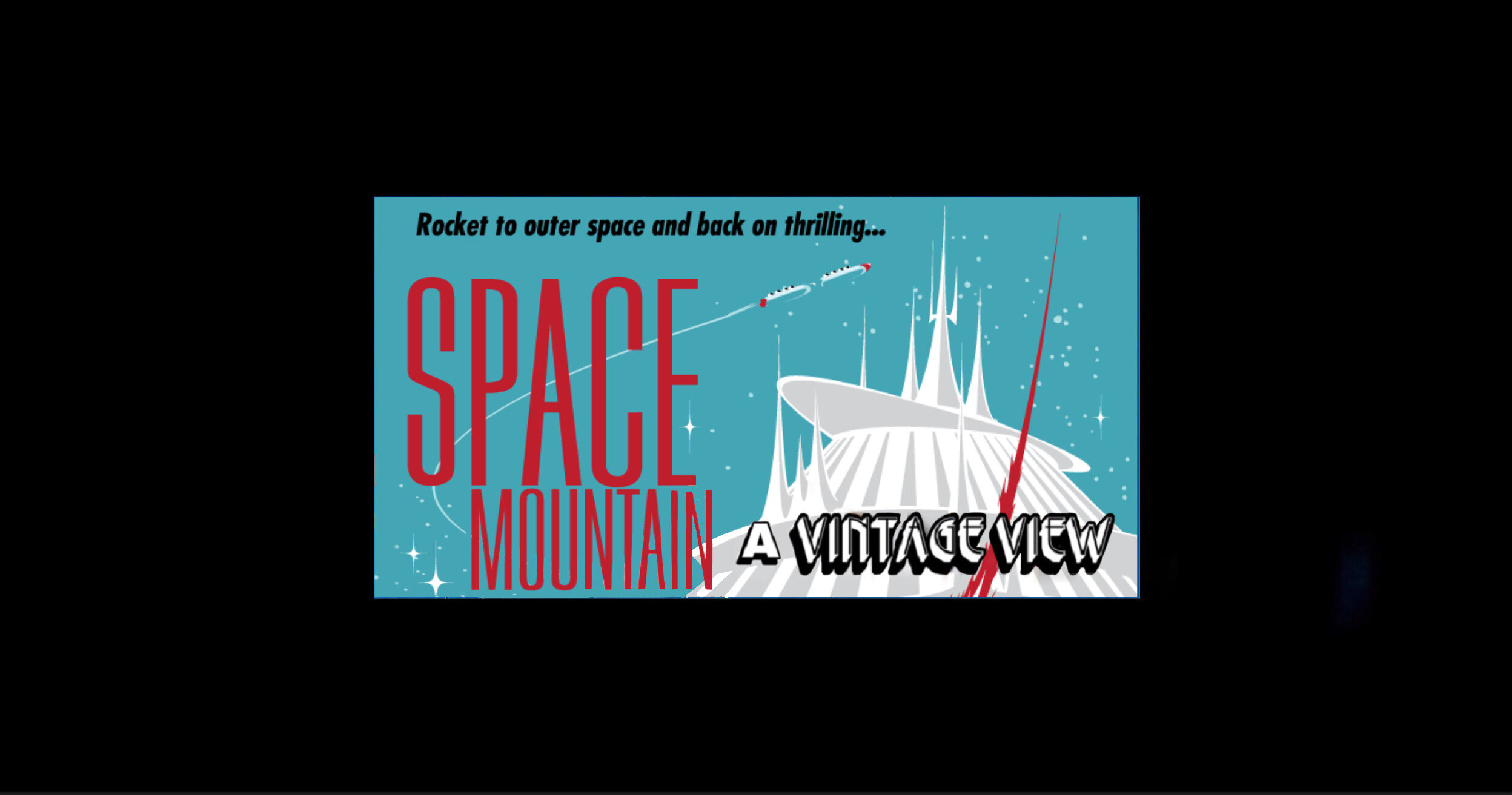SPACE MOUNTAIN
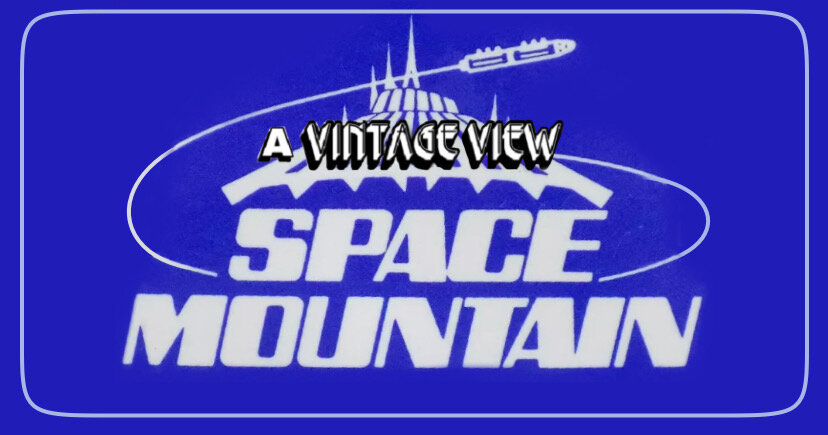
Construction : June of 1975 - 1977
Opening : May 4*, 1977
Dedication : May 27, 1977
*Disneyland Rides & Attractions and Attendance Report, Fiscal Year 1981.
One can easily slip into the jargon of “ride” but at Disneyland there are attractions and every attraction is a living experience for the guest. Disneyland ride-through attractions or adventures have officially been defined as an “individual show, ride, or exhibit designed to produce an entertaining Guest experience. Disney attractions stir the imagination, enliven the senses, and provide the participants with positive, innovative entertainment, which is the essence of the DISNEYLAND Show.”
There is also a “story behind the story” of every attraction. It is important to review the story of the attraction, tell the story, explain it, and create interest. This is the story of Space Mountain.
When Disneyland was being conceived, Walt intended that his Park have no roller coasters. However, Walt Disney also said : “Disneyland will never be completed. It will continue to grow, always adding new things to provide its visitors with exceptional and entertaining attractions.” In Walt’s eyes, Disneyland was “like a piece of clay,” because if there was something he didn’t like, he wasn’t stuck with it. He could reshape and revamp it. After years of personally reshaping and revamping, Walt divulged: “I’m not the perfectionist anymore. It’s my staff - they’re the ones always insisting on doing something better and better.”
The success of the Matterhorn Bobsleds a few years prior (in 1959), had proved the viability of thrill rides within Walt Disney’s Magic Kingdom! While some early research and development was conducted through Arrow Development, Space Mountain would become one of the Park’s first roller coaster-type attractions to be developed through WED Enterprises. In 1964, Walt assigned WED Enterprises artist “Captain” John Hench (an old sketch artist from the Hyperion Avenue Studios era of 1939; a background artist) with the task of researching and creating initial concepts and sketches for future indoor roller coaster attraction at Disneyland. This potential adventure would be included in the New Tomorrowland expansion project of the mid-1960s.
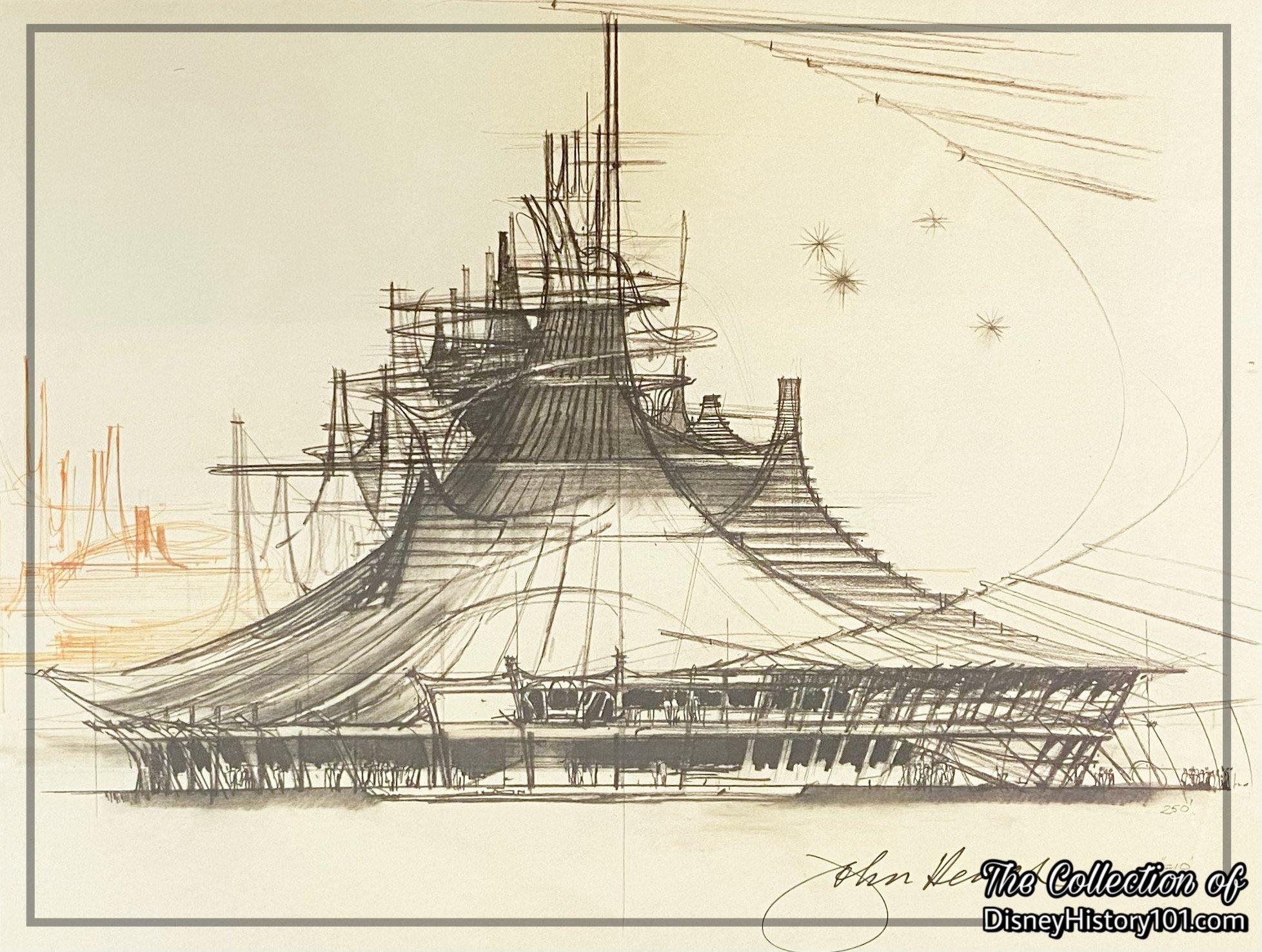
“Draw Concept” - “Tomorrowland Space Adventure” concept in charcoal & colored pencil by John Hench print, The Disney Gallery, c. 1997.
Walt Disney’s Imagineers knew their audience. Even while Tomorrowland featured the Flying Saucers attraction, early 1960s maps began to depict another space-themed attraction - a “Spaceport & Rocket Flight Future Attraction” (also referred to as “Space Voyage.” Some of the earliest visions of the Show Complex Building (with its towering white spires) were created by the Legendary John Hench, who made “the first little sketches on the thing.” Even such early renderings proved that the building was designed to have ”draw concept” - designed in a manner in which it would generate interest and beckon the observer. In the words of John Hench, “It's all very obvious: careful communication, watching what you say, and being explicit and having something to say in the first place.”
According to Marty Sklar “I like to think that I interpreted and reinforced Walt's creative approaches because it was really Walt Disney who set this whole thing up. I've worked hard to be the champion of Walt's philosophy and values over the years… John Hench was the king of design, but even being as smart as he was, he wasnt able to communicate easily down the line, so there was a role for me in helping to achieve what the great designers had developed.” [“Ripley’s Pioneers: Legends of the Amusement Park Industry Volume One” by Tim O’Brien]
“Disneyland is unique in that some of the world's foremost creative artists and architects control all design at Disneyland.“ Walt Disney Productions artist Herbert Ryman was influential to some exterior elements, while some interior settings were sketched by WED Enterprises Employee George McGinnis. Notable WED Enterprises, Inc. engineers and artists like Bill Watkins and Roger Broggie Sr. would also be involved in the development of the space adventure - “Space Voyage”!
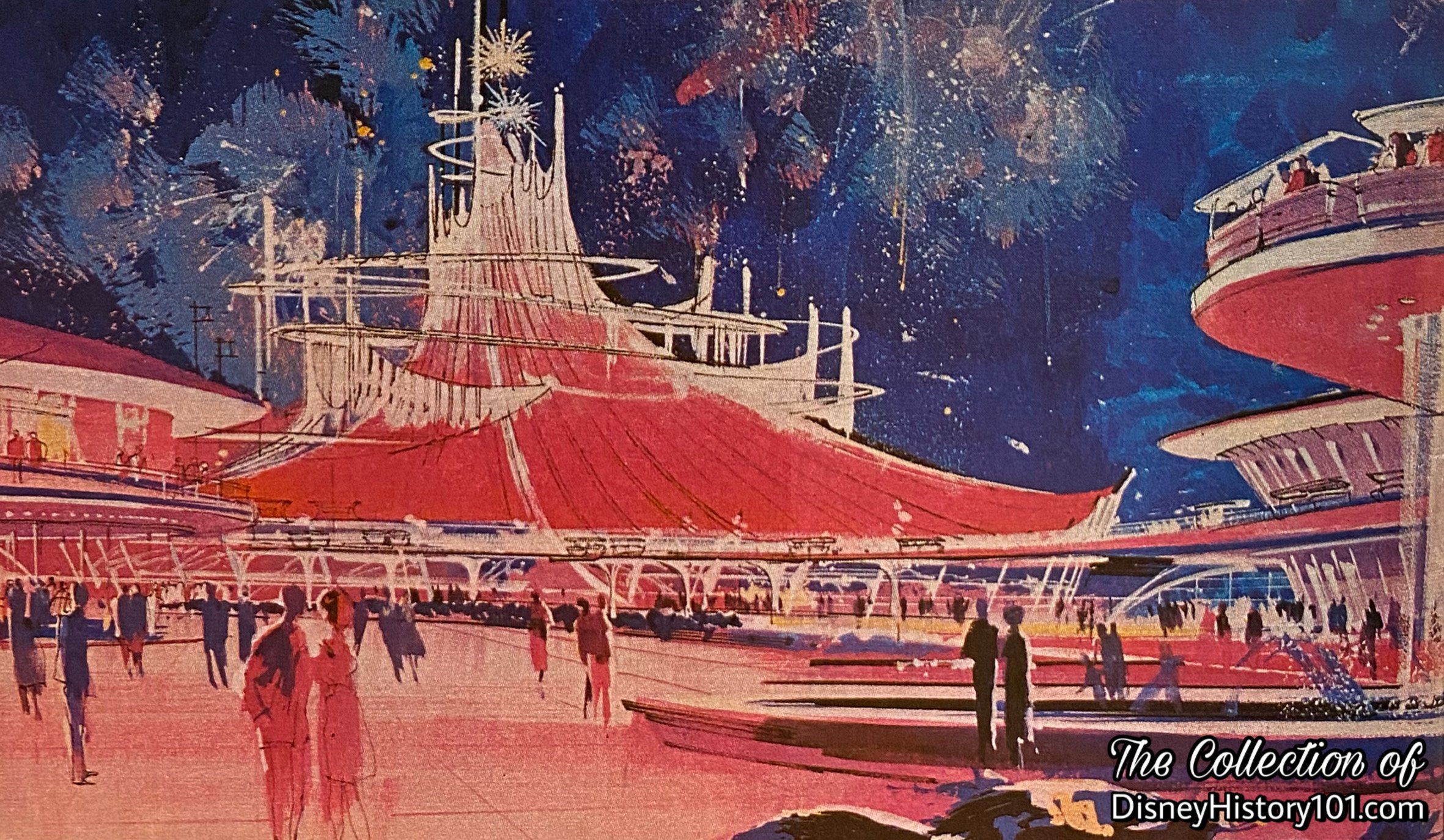
“In the Disneyland Future” - Tomorrowland Space Adventure in Summer ‘67: Disneyland U.S.A.
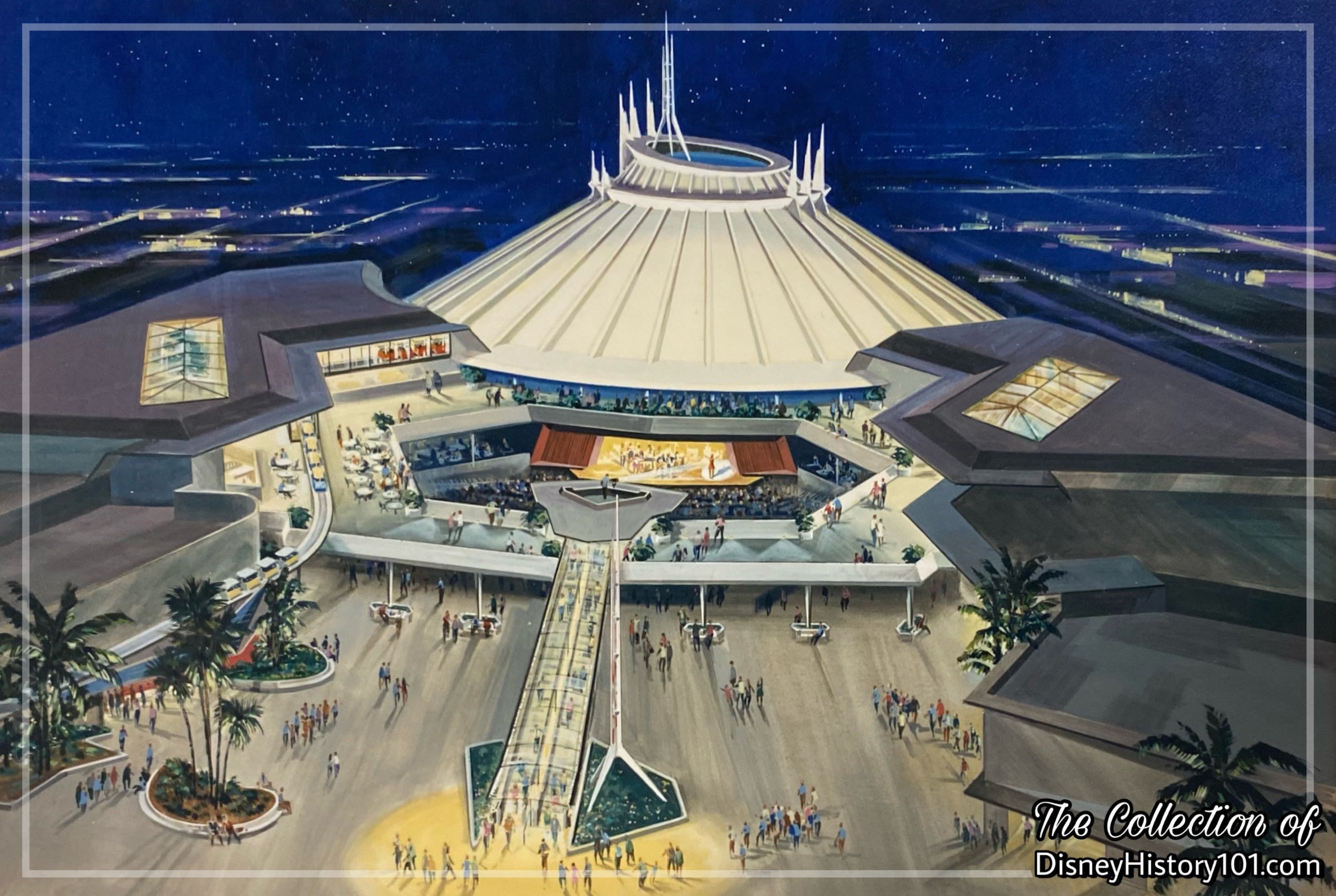
A Space Mountain concept.
According to LINE Magazine, “John remembers his first meeting with Walt about the project in late 1964. ‘Walt didn’t call it Space Mountain at that time but he felt we needed an attraction in Tomorrowland that would present the future through space travel. Walt had a prophetic ability and knowledge of how to bring different experiences together in a perfect blend…and he knew Space Mountain would be attraction that would serve to enrich the guest’s experience one step further.’” Space Mountain was likely one of several attractions that Walt had in mind when mentioning he had ”plans afoot - some on the drawing board or in model form, others only in the ‘dreaming’ stage…to be added through the year 1980.” [“Walt Tells Problems Studied for New Disneylands,” by Ted Thackery Jr., published Thursday, February 11, 1965, for the Herald Examiner of Los Angeles, California.]
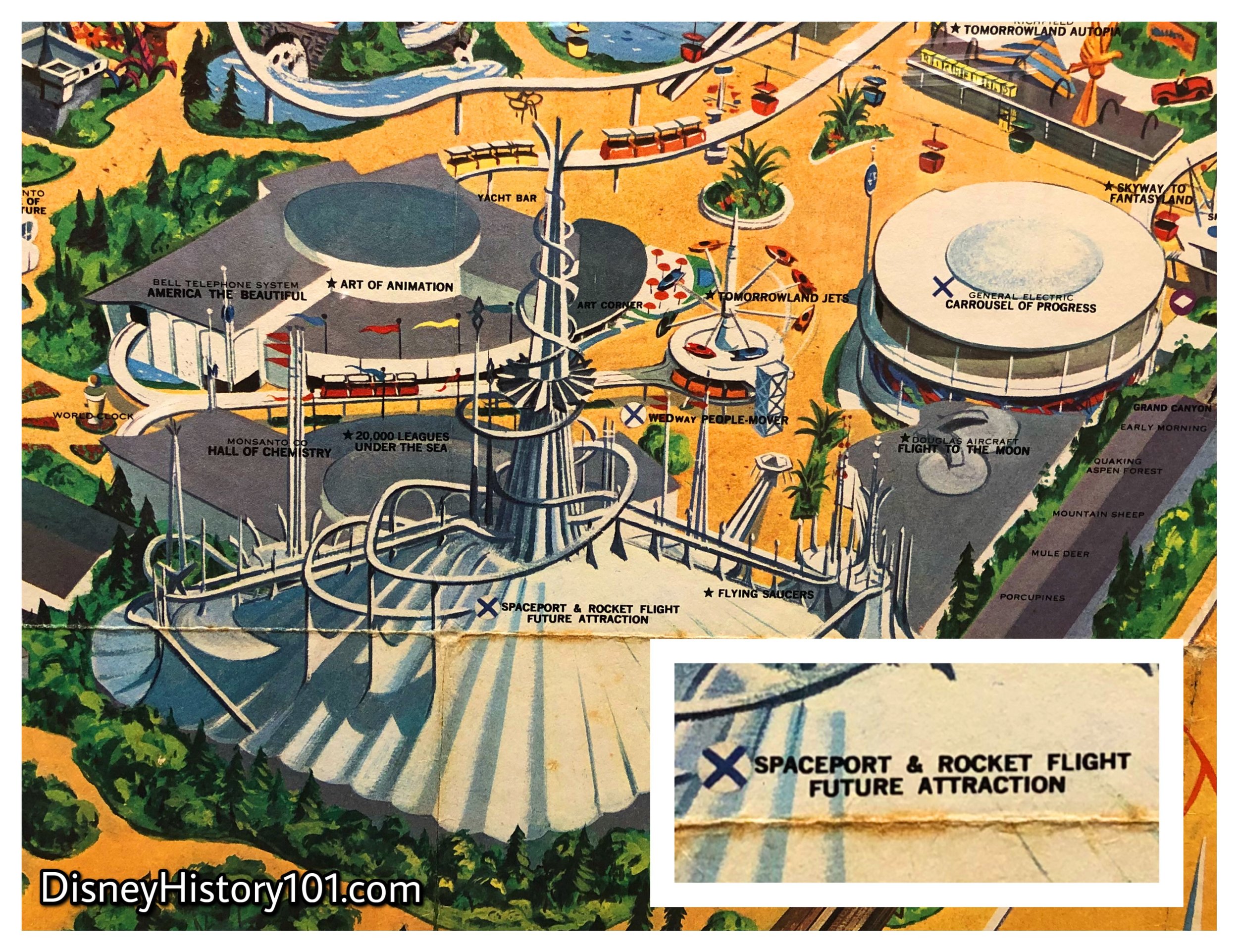
“Walt Disney’s Guide to Disneyland” Map Excerpt, c.1972
Early concepts featured four “tracks” (some of which wove inside and outside of the Show Building), complete with “soaring spires” (borrowing some style from Herb Ryman’s c.1964 “suggestions” for the New Tomorrowland). About the years 1965 to 1966, the job of “Space Ride R & D” (No. 034-53-22) was opened at WED Enterprises, Inc. Project 034-53-22 was described as Research & Design of a “Matterhorn-type ride with a structure housing four separate loading areas and ride tracks.”
According to “Progressland at Disneyland: a proposal for the General Electric Company from Walt Disney Productions” ©1965: “The word for 1967 is Tomorrowland -a New Tomorrowland. When the present Tomorrowland was designed, in the early 1950's, Early Bird, Gemini and Apollo were space age terms of the distant future. Even the household word ‘astronaut’ was still to be coined. Times-and-tomorrows have changed. So recently Walt Disney and his creative staff have taken a new look at the Tomorrowland area. To research ideas. Walt and his team visited Houston, Huntsville and Cape Kennedy, discussing the latest Space Age wonders with astronauts and scientists, including Dr. Wernher Von Braun. The result: a decision to close the entire Tomorrowland section of Disneyland in the Fall of 1966 for complete redevelopment - the re-building and enlarging of an entire area of Disneyland to provide for dramatic and exciting new attractions and exhibits. In New Tomorrowland, a towering structure will serve as spaceport and theme center. Inside, guests will experience the sensation of racing through distant space.“
Internal materials published in 1966 mentioned: “With four maior new attractions nearing completion for summer, 1966, openings at Disneyland, Walt and his staff af WED are looking toward 1967 - 1968.“ By May 25, 1966, an allowance of $150,000 was allocated toward the cost. By October 1, 1966, an actual cost of $119,000 with a write off of $119,000 was pending approval.
According to John Hench (who led the project), even back in 1965, plans called for a two-level building with guests entering from the second level. “Walt had originally thought of having the lifts on the outside”, John recalls, “but we could control the light much better with an enclosed structure.” Testifying to this is image of this design can be seen in the pages of “A World of Smiles” (the Tencennial Tour Guide scrapbook). Soon, the “Walt Disney Productions Annual Report to Shareholders and Employees Fiscal Year Ended October 2, 1965” announced: “In New Tomorrowland, a towering structure will serve as a spaceport and theme center. Inside, guests will board four-passenger ‘rocket ships’ to experience the sensation of racing through distant space. Spiraling upwards as high as an 18-story building, the ‘Tomorrowland Mountain’ will be the highest point in the Magic Kingdom, a magnet visible for miles.”
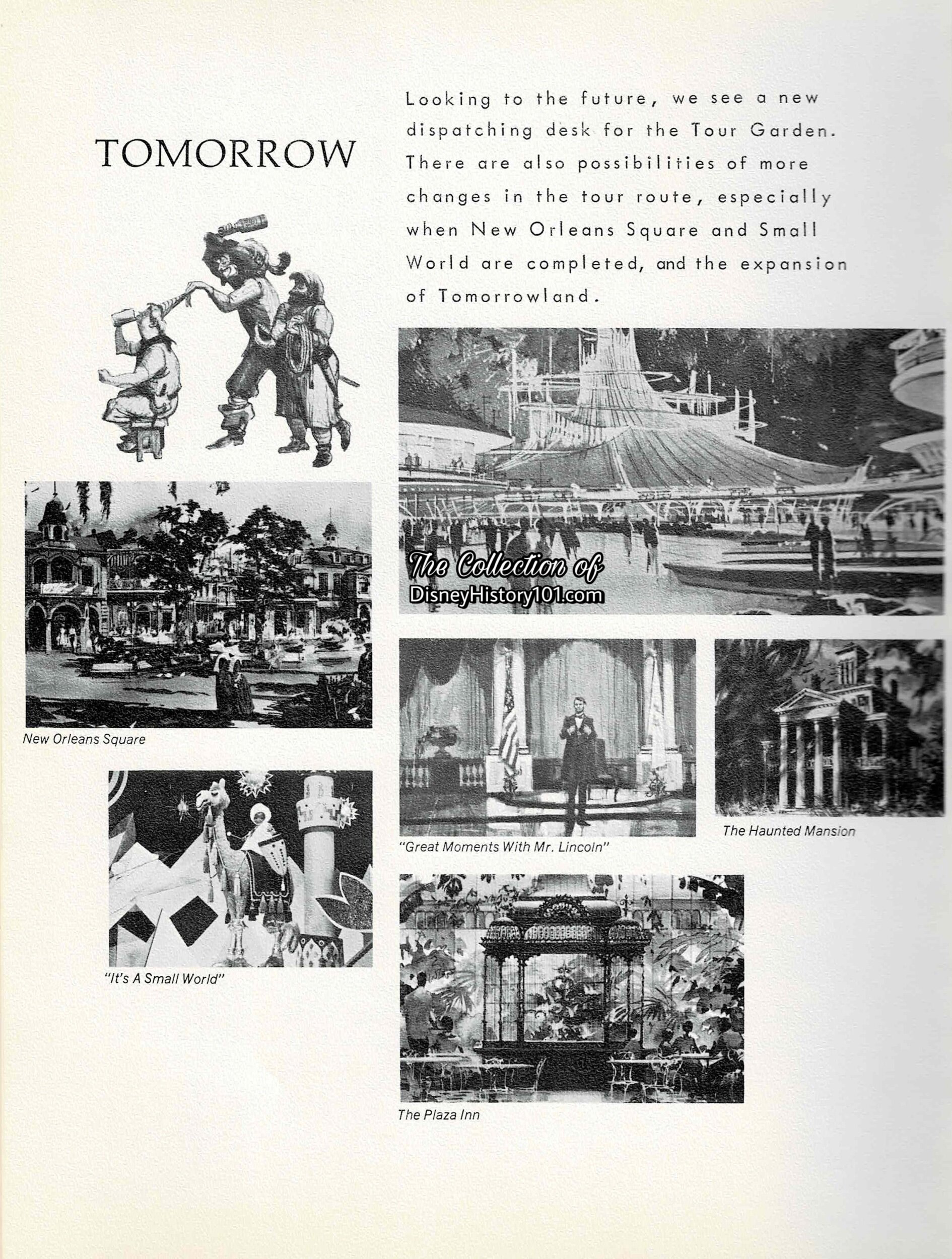
"A World of Smiles - Dedicated to the Summer Tour Guides 1965" Excerpt Prepared Guides for Potential Future Attractions and Guided Tour "Stops." Note a certain unnamed Tomorrowland show building.
“A ‘Hold’ on Space Mountain, and a ‘Gap’ in Development” - It’s a fact, that the “Space Mountain” name was first attached to the project during 1966. During this time, Herb Ryman produced mode concepts of the spire-topped show building and WED Enterprises, Inc. engineers were utilizing “far-ahead” computers to conduct stress and design analysis (including those of the curves and turns of the track). The layout revolved around utilizing gravity and kinetic energy to keep the cars moving forward. Some of these viable project Concepts (as seen above), were supported by a well-developed business case and built expectation. However, it seemed that there was not the necessary space to house this attraction, as Walt was “running out of building room inside the 20-feet Hugh earthen berm surrounding Disneyland.”
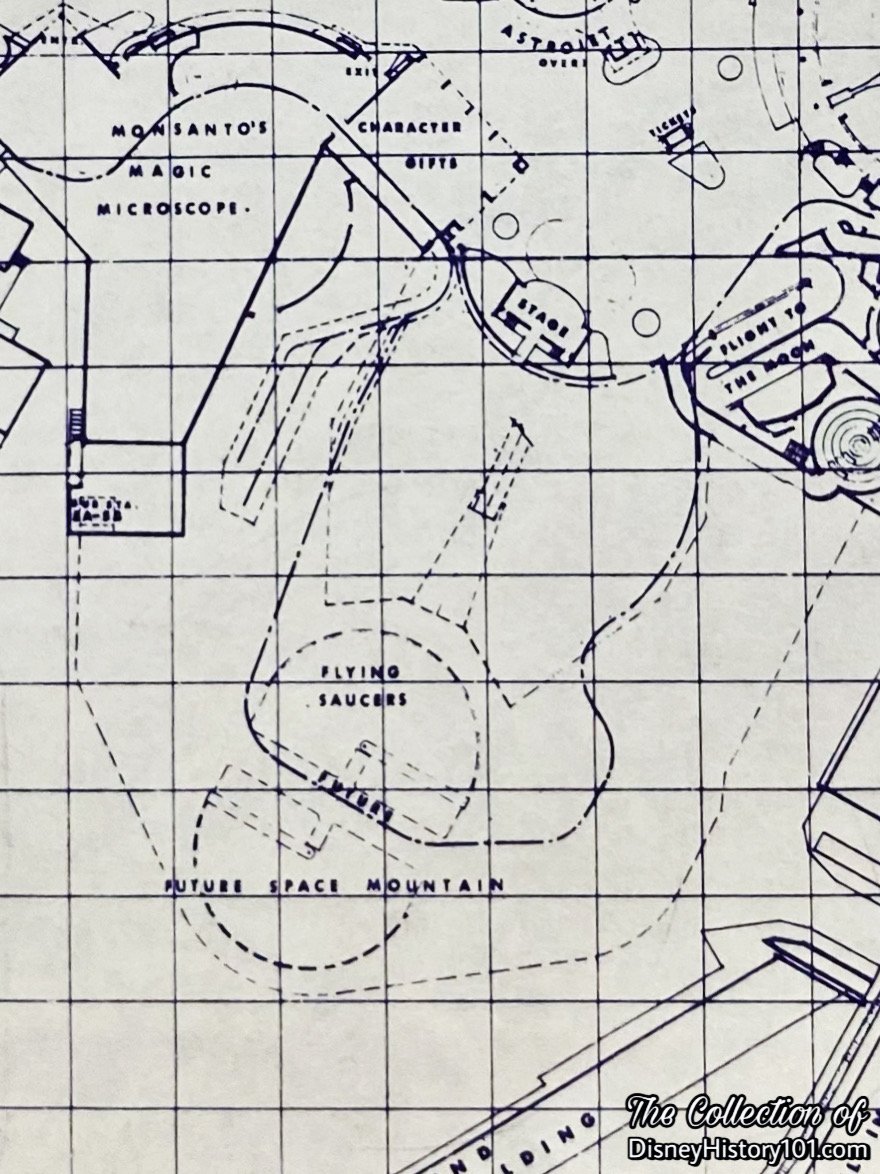
Flying Saucers & “Future Space Mountain” detailed on a Disneyland Plot Plan, c.1966.
Then there was the matter of the computer technology to control the safety “Block (brake) System.” The Automatic Block System was a series of consecutive blocks governed by block signals that were actuated by a train, engine or by certain conditions affecting the use of a block. The system was used on the Disneyland Railroad but was seemingly limited for application toward Space Mountain. So after Walt’s passing (in December of 1966), any plans for this particular future Disneyland attraction were put on hold while Walt Disney’s Magic Kingdom was brought to reality.
A WED philosophy is that there is no bad idea. “We say that because if you get in a meeting and somebody comes up with something and someone turns to him and says, ‘That's a stupid idea!’ you'll probably never get another idea from that person. So, we try to create an open environment where people can say anything. Quite often, something that sounds dumb at the time will turn out to be just the little spark that sets everything off Somebody will come in later and say, You know, I thought what so and so said was dumb, but I’ve been thinking about it and I think there's a little gem here.’ Its amazing how many times that happens…‘ Marty said that he's been around so long and has discussed so many ideas that he has seen many resurface after many years. ‘When that happens, I know from experience that a lot of them won't work, but I don't say, 'Well, you know what? We tried that 20 years ago and it won't work; because so much changes. If we went back through our archives, we'd probably find a lot of things that we could do today that we couldn't do at the time because the technology wasn't there.’“ [“Ripley’s Legends - pioneers of the Amusement Park Industry” by Tim O’Brien, Volume One]
Walt once said: “Since my outlook and attitudes are ingrained throughout our organization, all our people have this curiosity; it keeps us moving forward, exploring, experimenting, and opening new doors.” So began the blending of creative and technological innovation with the essence of great Disney storytelling. Soon, one of the Magic Kingdom’s planned adventures included the “Space Voyage” - the first incarnation of Space Mountain! Four years later (and by the early 1970s), true-life space-age computer technology had advanced enough to control the proposed safety “Block System” enabling multiple cars to safely run along the rails simultaneously. In fact, the block system was controlled with the help of two Data General Nova 2/10 computers. Sensors (electronic elements in the track) monitored the speed and spacing of vehicles.
So, the plans (employing research, development, and conceptual artwork of John, George, and Herb) were “dusted off” by the WED Creative Development Division members. New concept art was created by artists like Walt Disney Imagineer Clem Hall (c.1974). New software from NASA was utilized to design the support structure and required specs of the attraction. Though the original four “track” concept was reduced to two “tracks” and the attraction would be fully-enclosed in the Show Building (design by WED Enterprises Imagineering Project Engineers Glenn Durflinger, Bud Stacy and Randy Carter), the attraction would make use of the old c. 1966 working title.
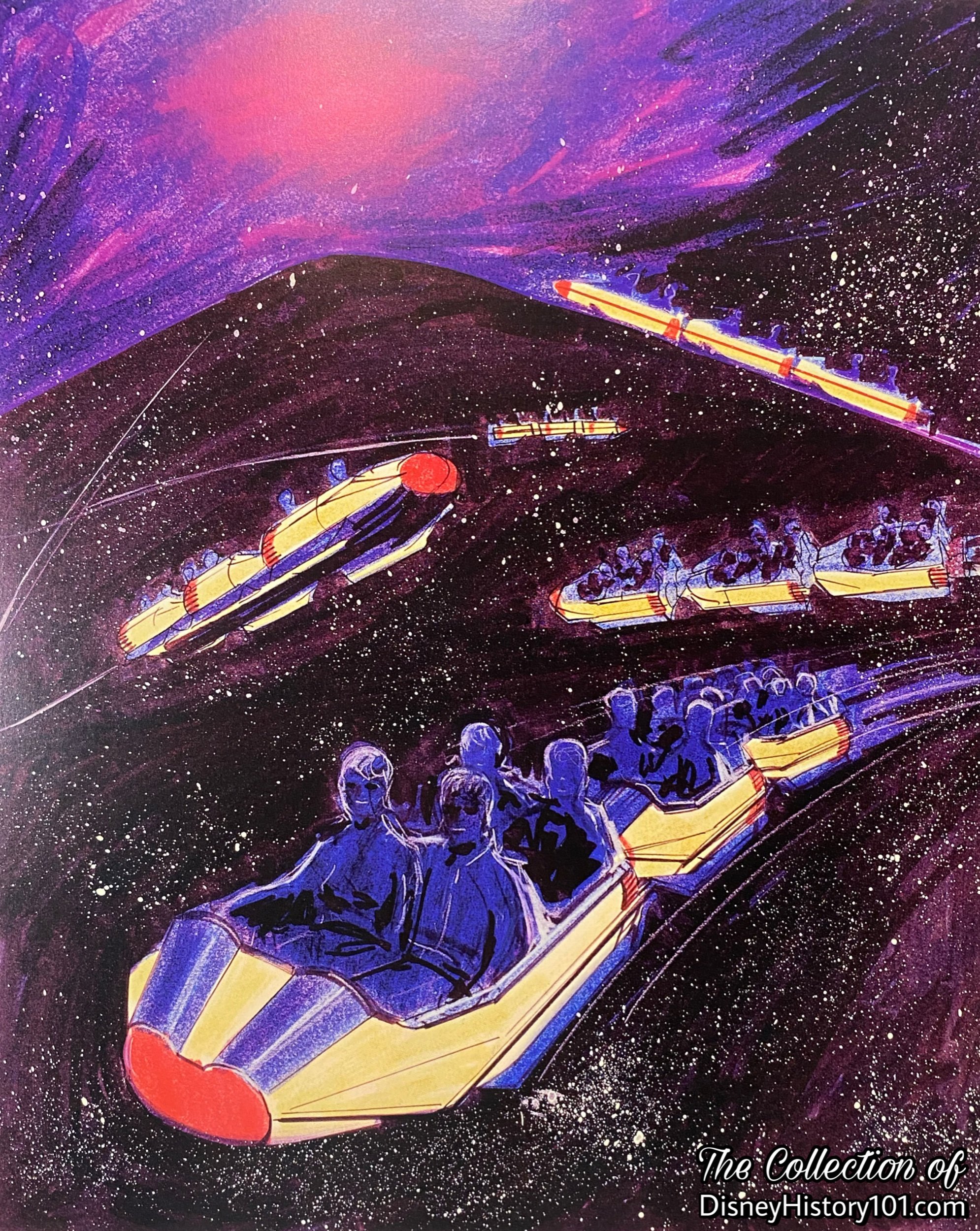
A c.1975 Space Mountain concept of those tandem vehicles by George McGinnis (released through The Disney Gallery); ©️The Walt Disney Company.
True life astronauts Gordon Cooper (of the Mercury 9 & Gemini 5), James Irwin (of the Apollo 15), and Scott Carpenter (of the Mercury 7) helped open Space Mountain at Walt Disney’s Magic Kingdom, on January 15th, 1975. Space Mountain was a grand success.
Meanwhile, Disneyland had managed to “maintain its levels of attendance in the face of rapidly expanding competition for California's leisure dollar, and despite the fact that the Park has not opened a major new area since Bear Country in early 1972.” As approximately 60% of the Park's attendance came from within the state of California, “new attractions remained a vital factor in stimulating repeat visits and assuring the Park's continued future growth. Therefore, in 1975, the Company committed itself to a major new capital development program for Disneyland.” By September of 1975, construction crews received the “All Clear” (under the supervision of Maintenance Lead Bud Poole) to begin work on the second incarnation of Space Mountain, and Disneyland's second “mountain.” Construction commenced during September of 1975.
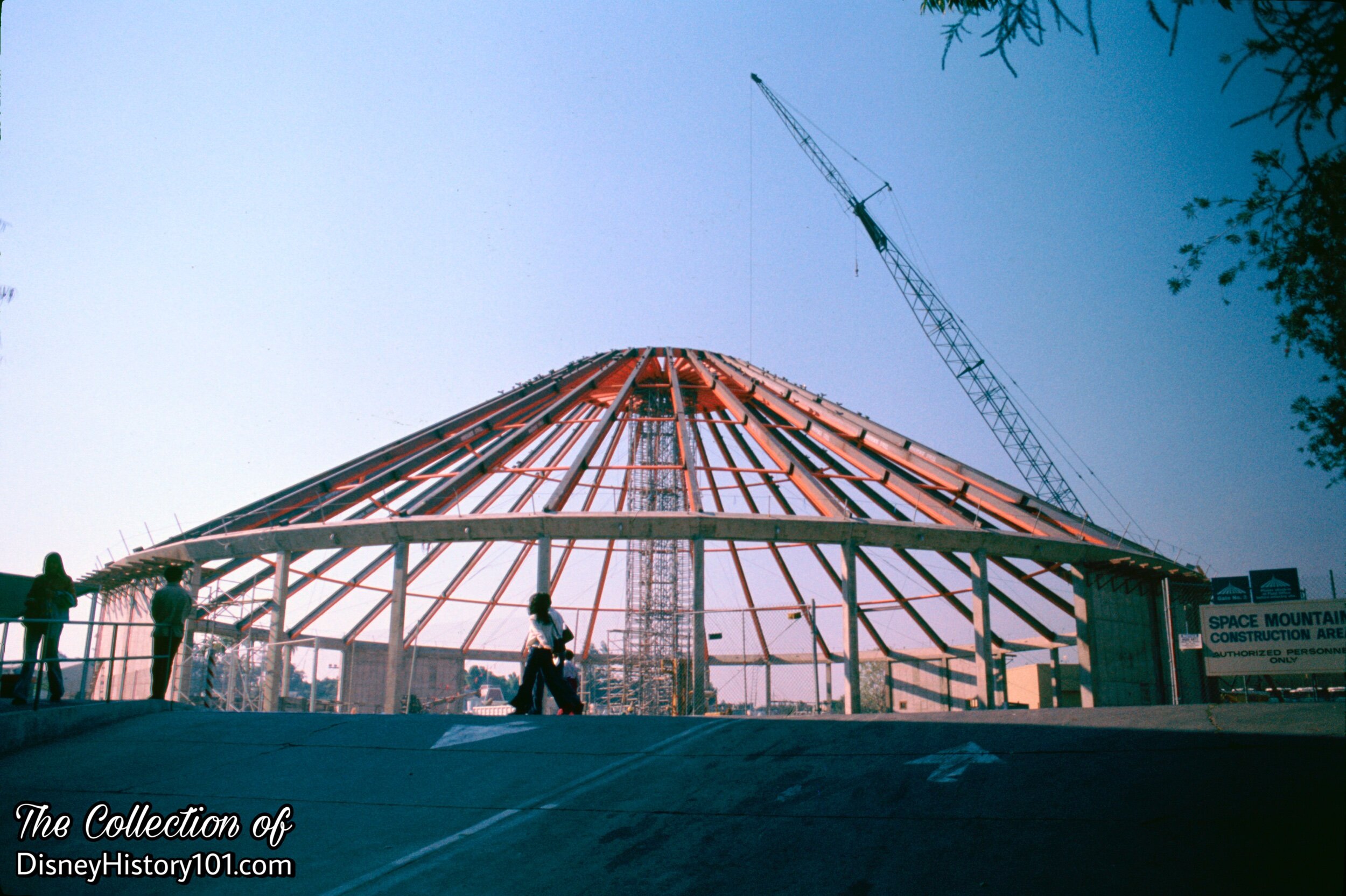
Space Mountain Construction, (December, 1975)
The steel frame of the Space Mountain show building is 200 feet in diameter, holding more than 1 million cubic feet of space. It is hard to see from this “Vintage View”, that the base of the structure is set 17 feet below grade (or, ground level). A considerable portion of Space Mountain was placed below the ground level in order to reduce the height visually in relation to the smaller Sleeping Beauty Castle. From ground-level, the structure would measure 75 feet tall not including the spires. If Imagineers did not scale down and sink part of Space Mountain deep into the earth it would have become a Visual Intrusion and a contradiction, dwarfing Sleeping Beauty Castle and all of Main Street.
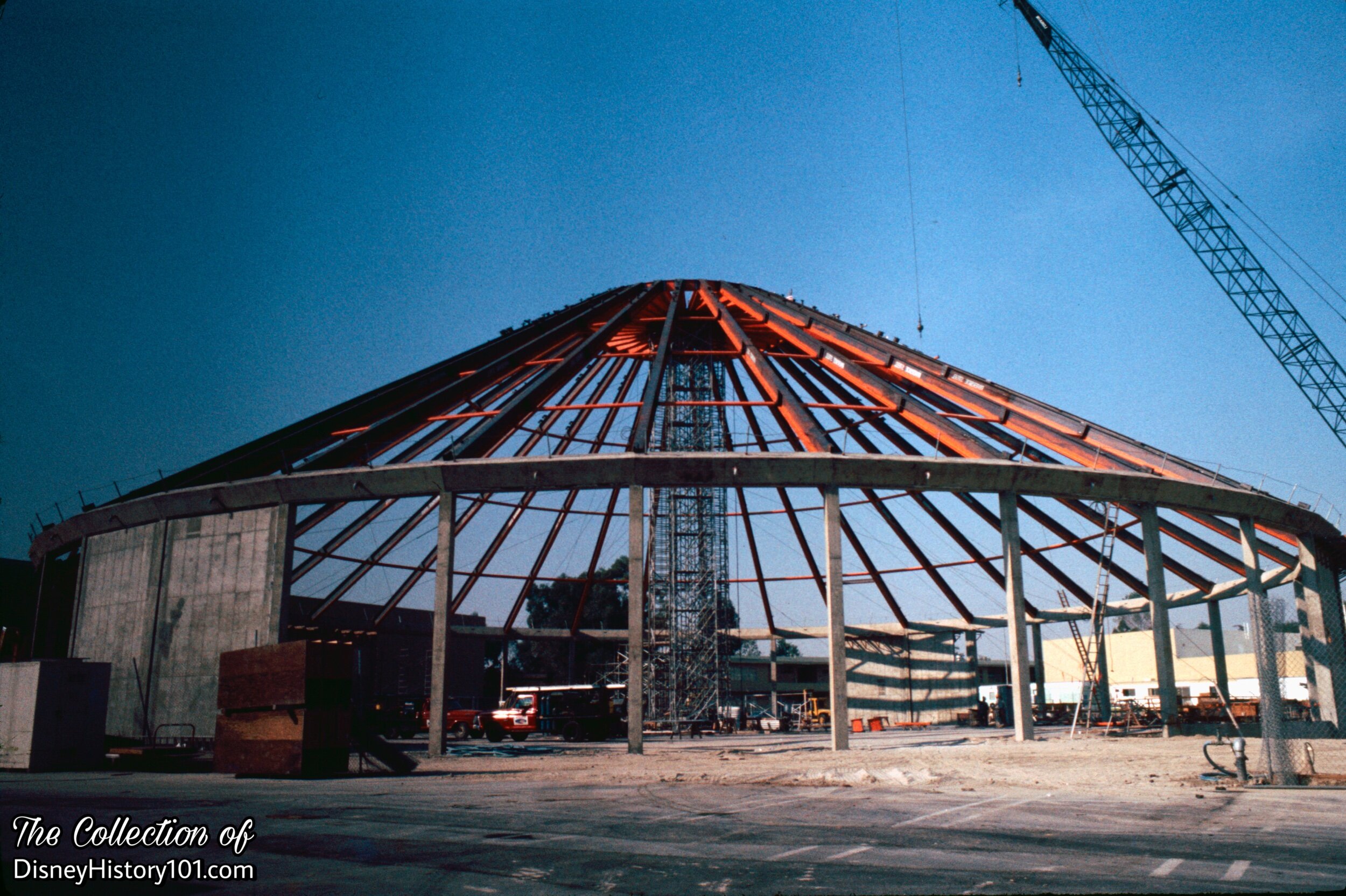
Space Mountain Construction, (1975)
There are a total of thirty-six steel support beams atop forty-five concrete pilings.
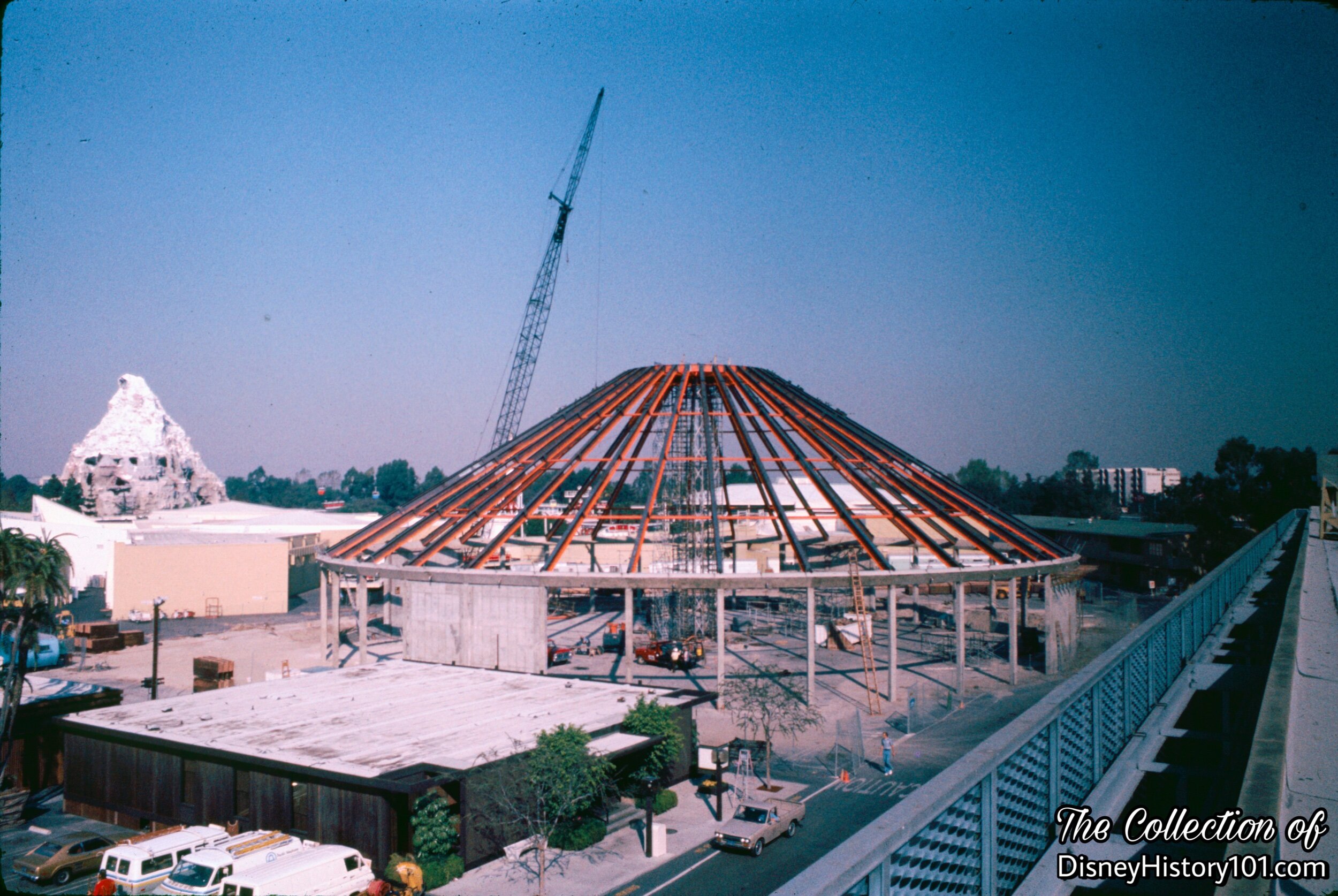
Space Mountain Construction, (December, 1975)
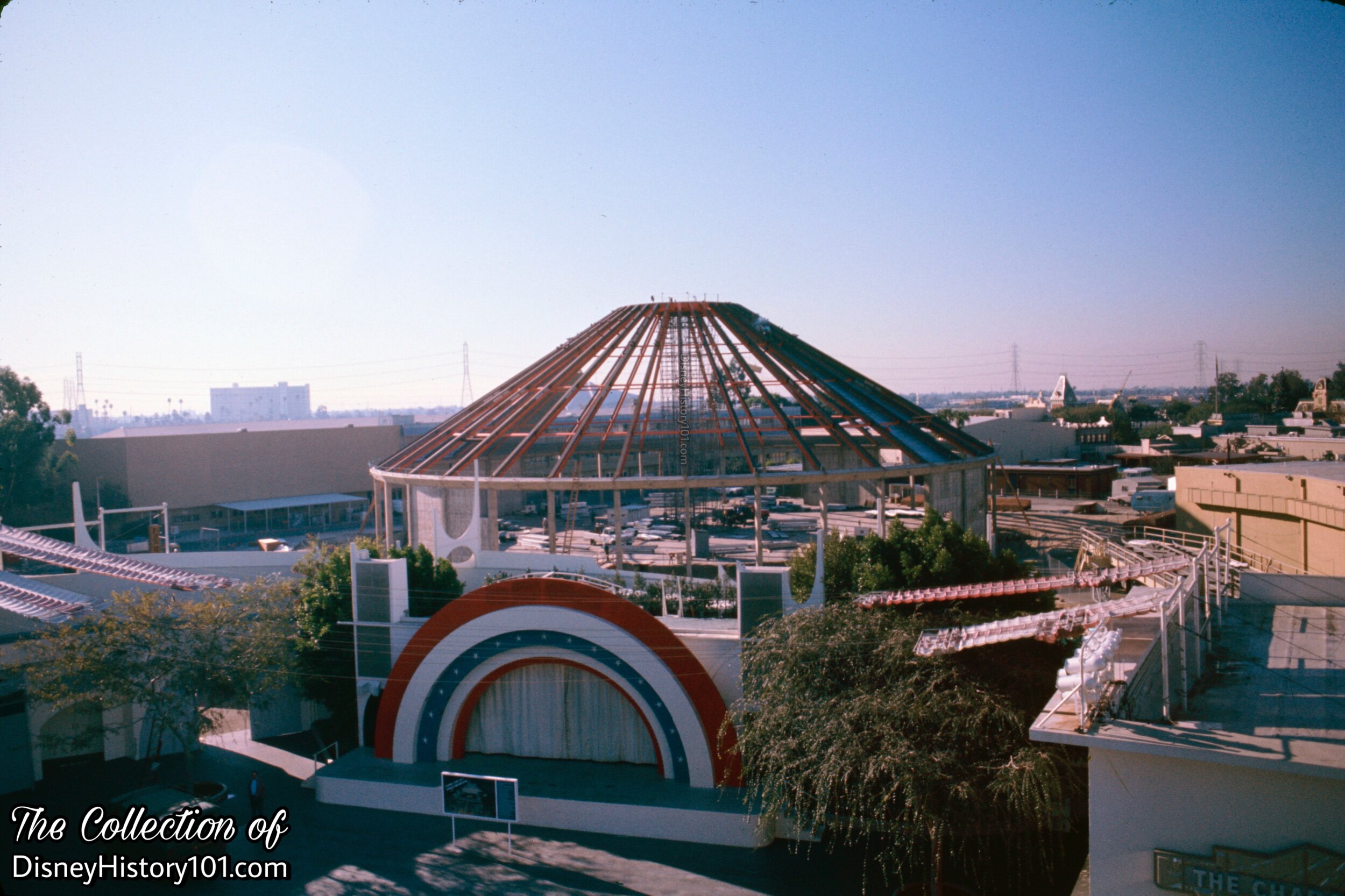
Space Mountain Construction, (January, 1976)
Before the 1,100 seat Space Stage was installed in front of the Space Mountain Complex, this was the look of its facade and the Tomorrowland Stage.
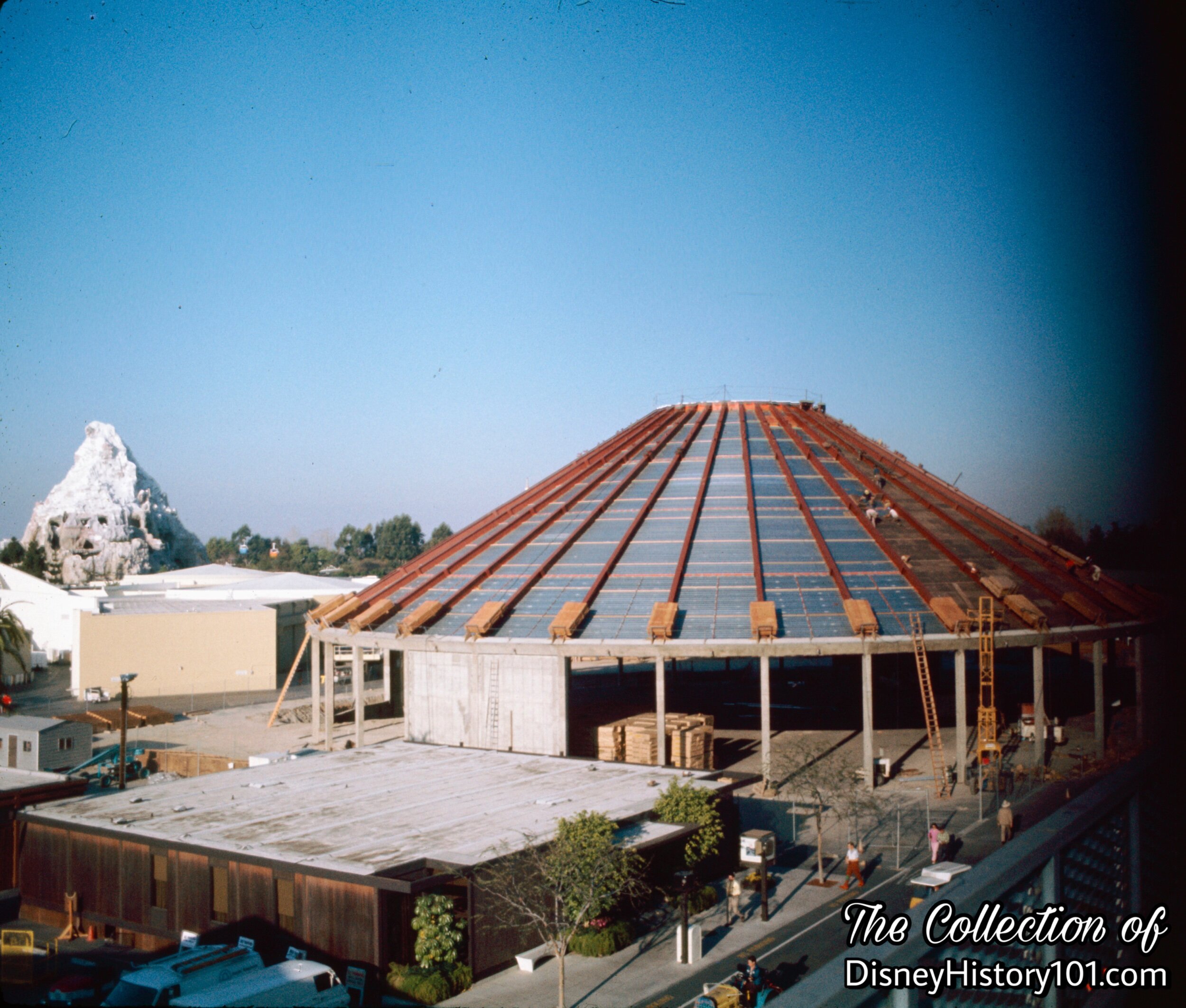
Space Mountain Construction, (January, 1976)
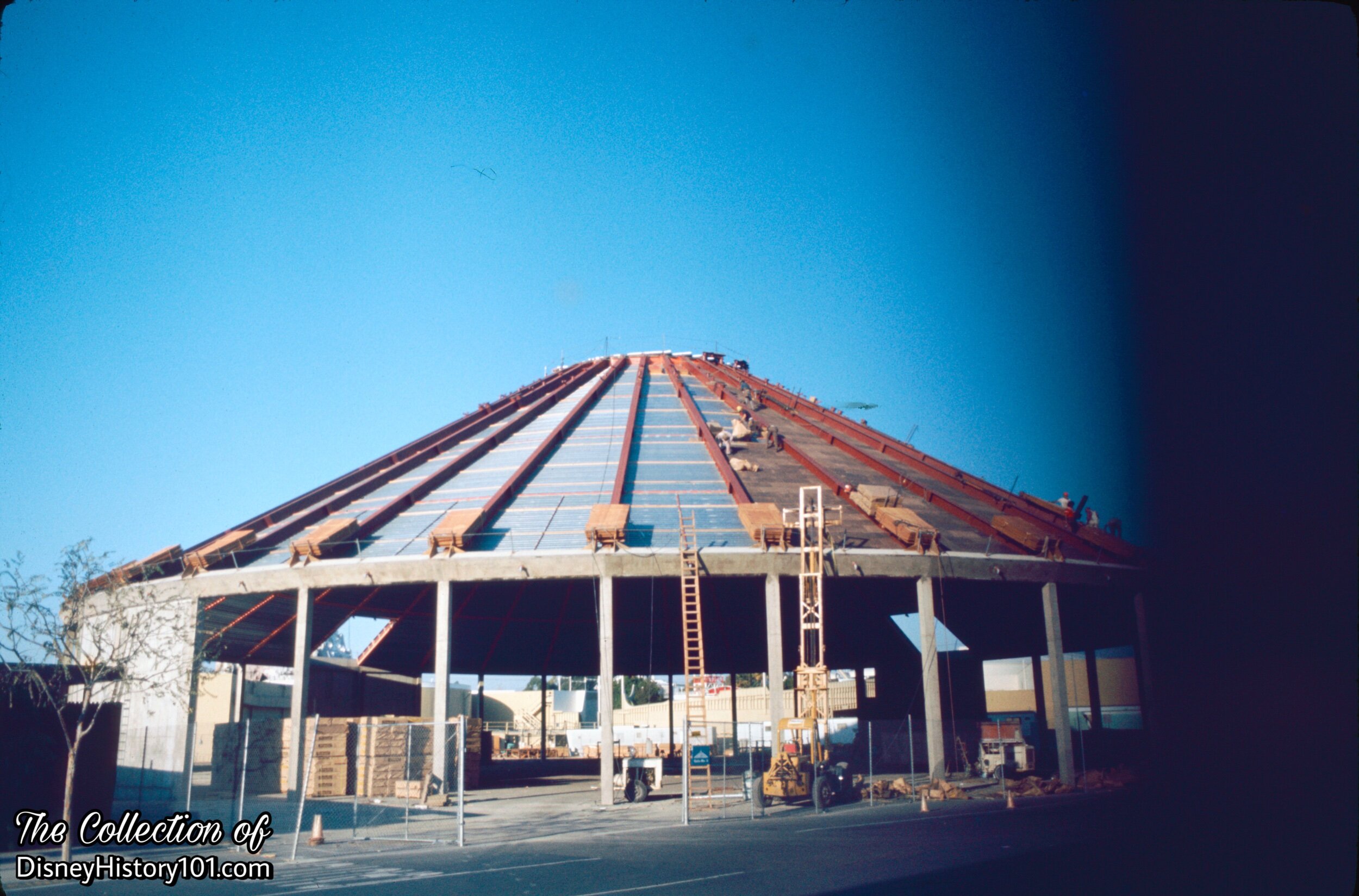
Space Mountain Construction, (January, 1976)
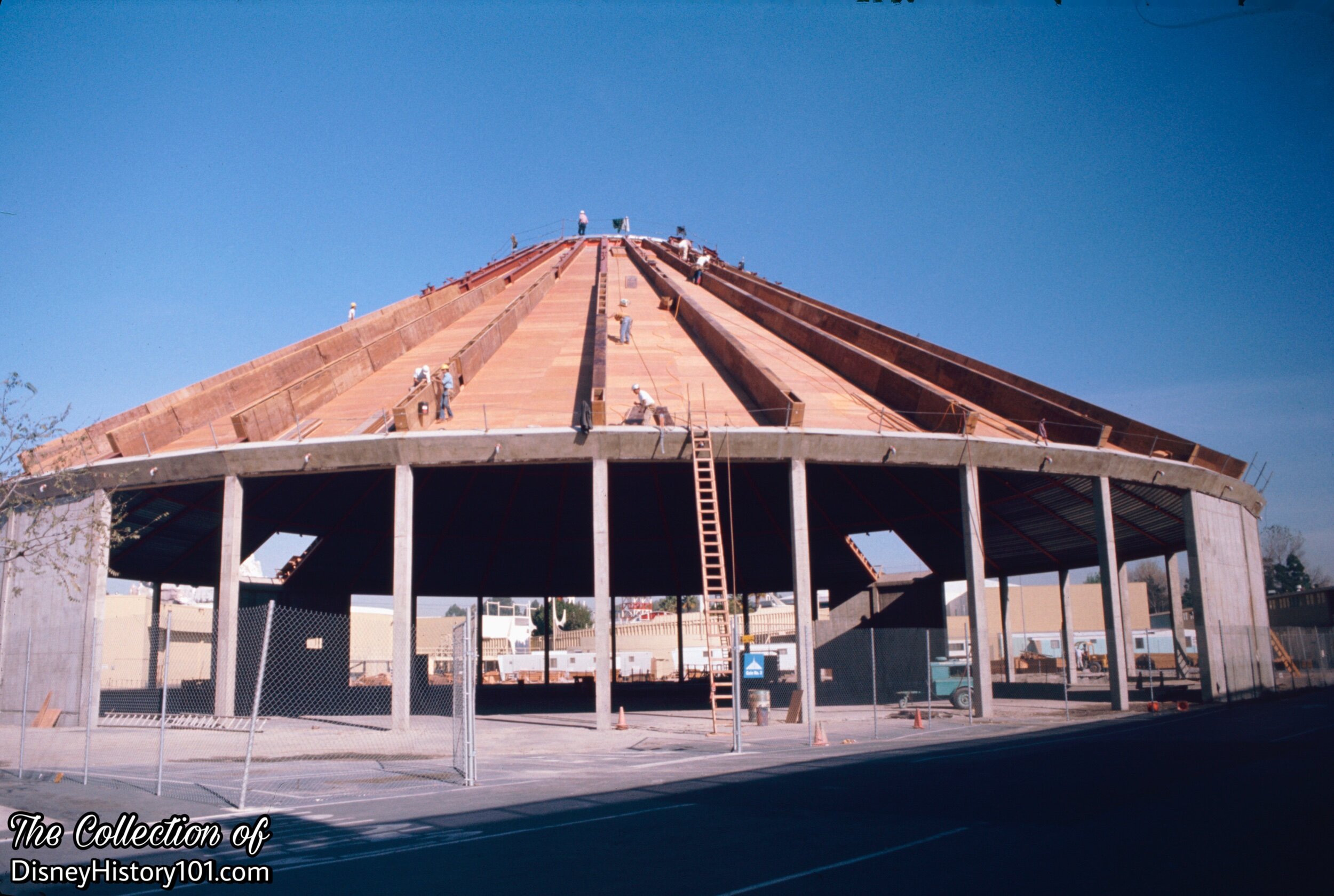
Space Mountain Construction, (February, 1976)
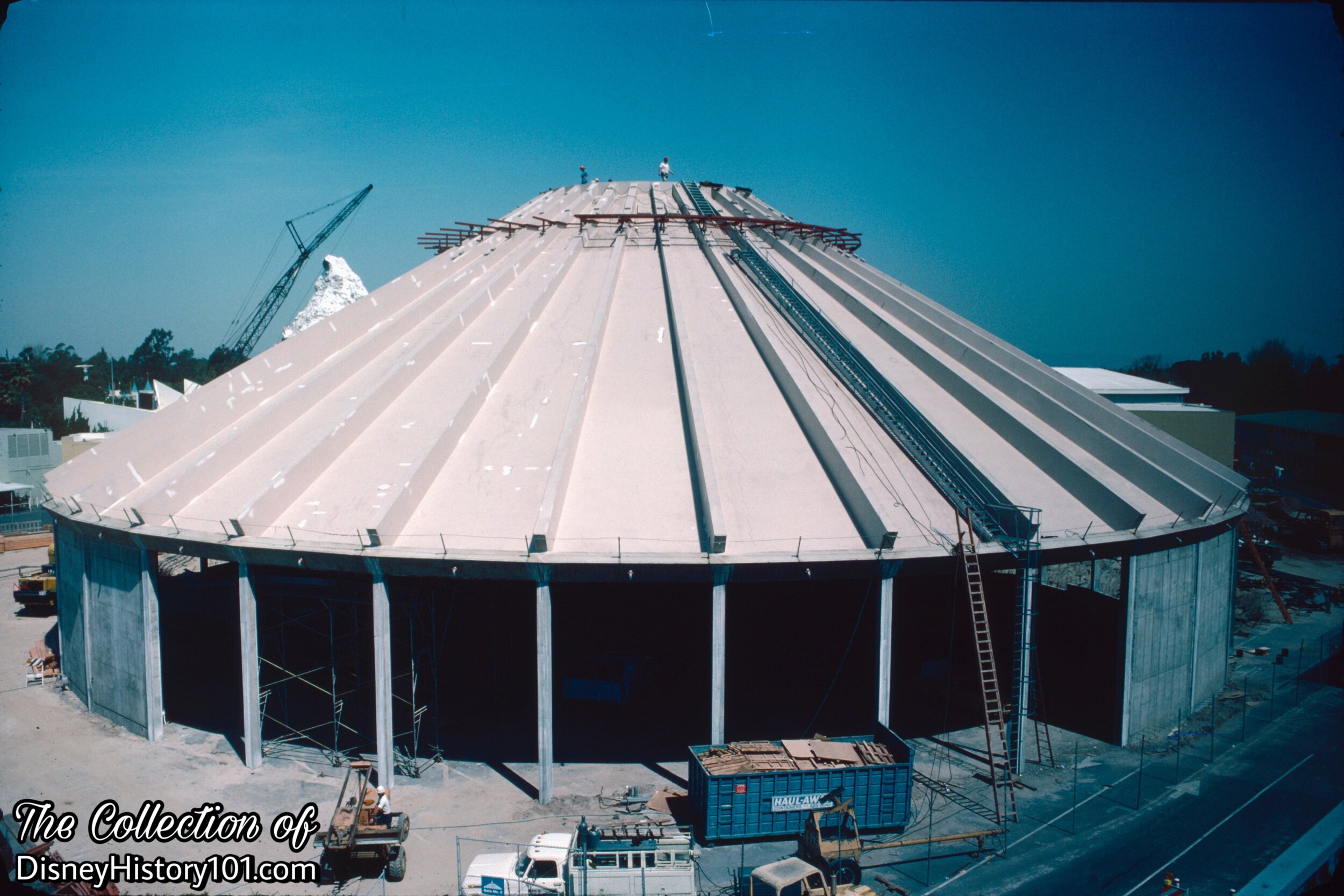
Space Mountain Construction, (April, 1976)
The show building was 75 feet tall (without the external spires).
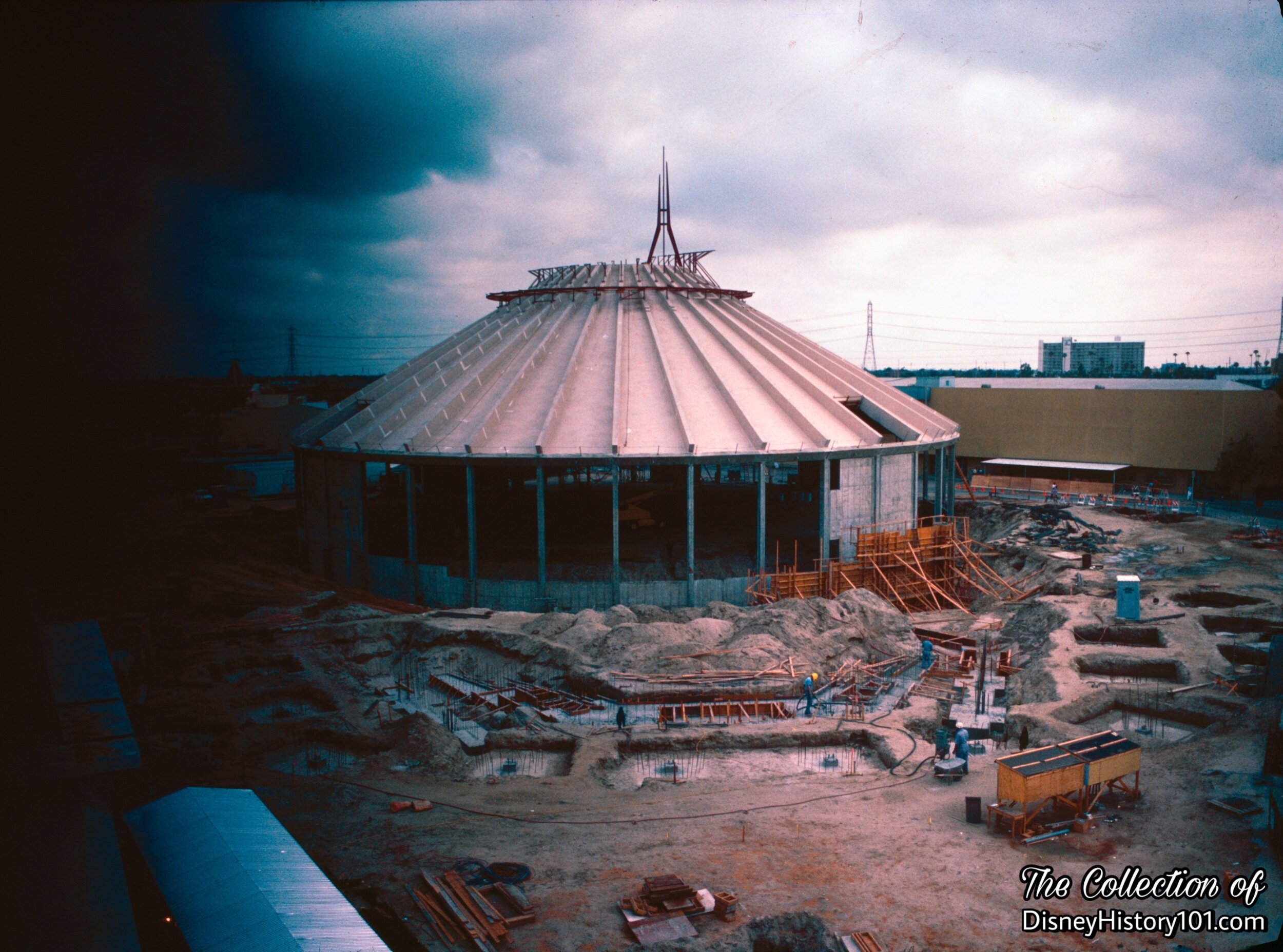
Space Mountain Construction, (April, 1976)
But it was 117 feet from the ground to the top of the tallest spire point.

Space Mountain Construction, (c.April, 1976)
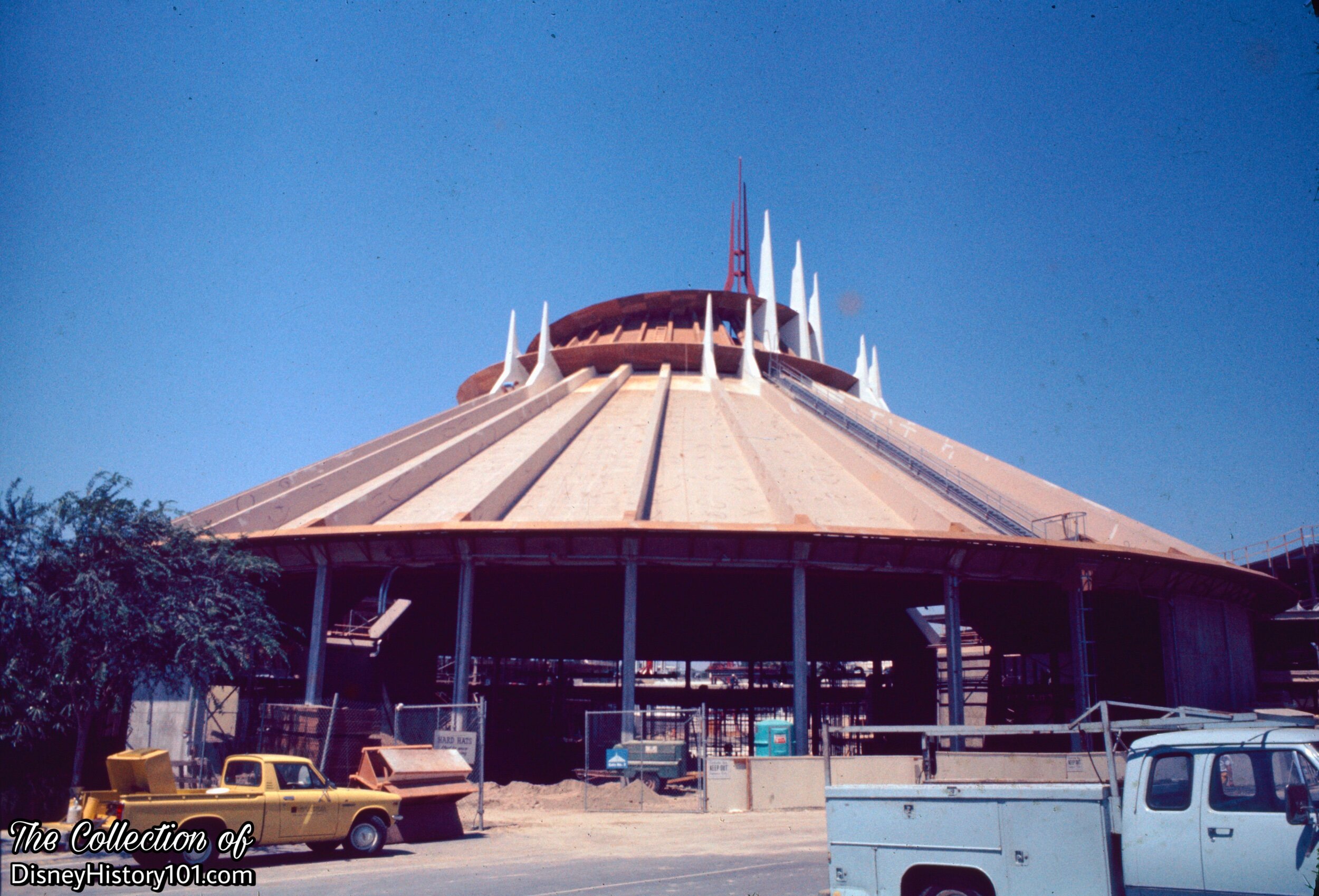
Space Mountain Construction, (1976)
The show building would measure 117 feet from ground-level to the top of the tallest spire.
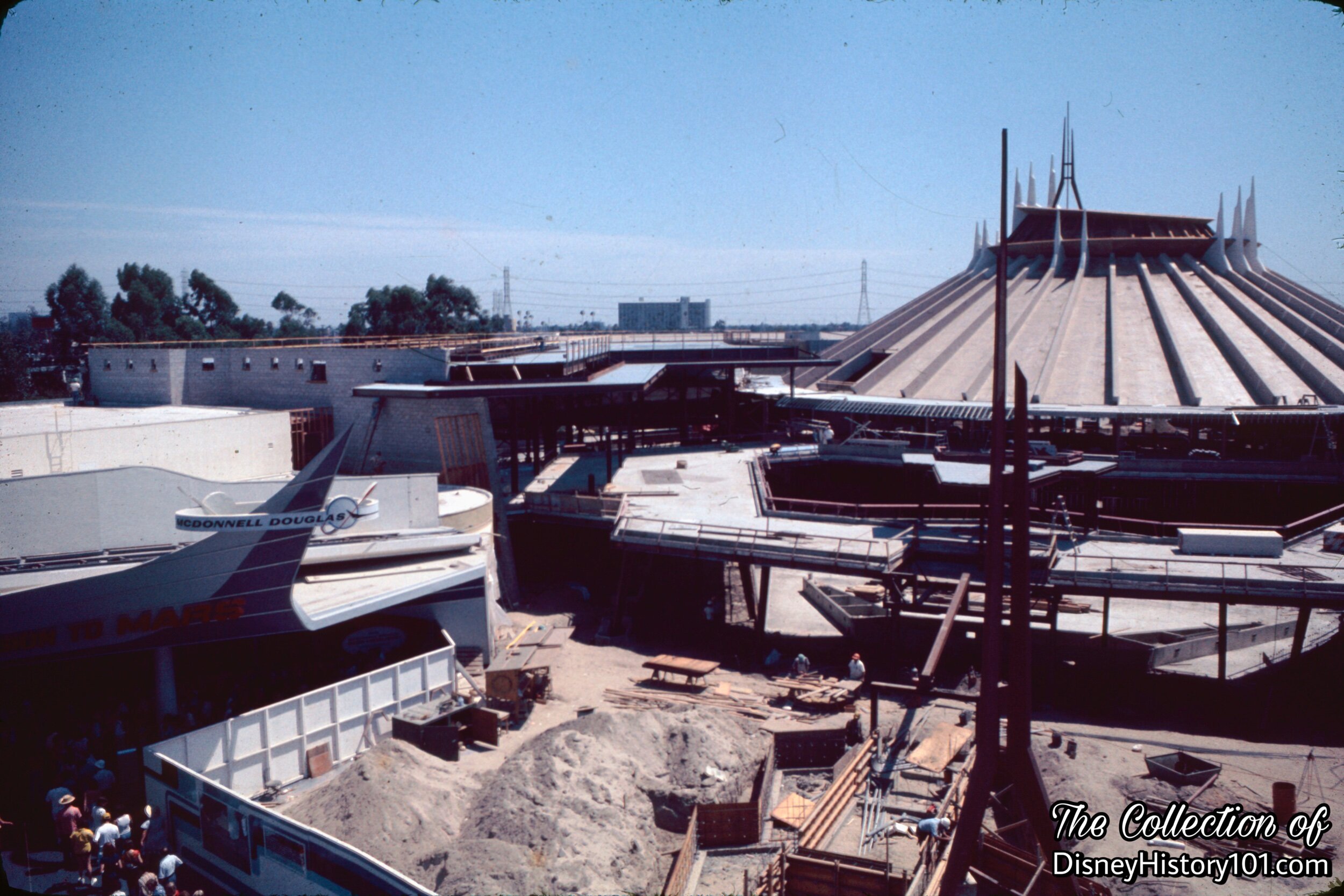
Space Mountain Complex Construction, (August, 1976)
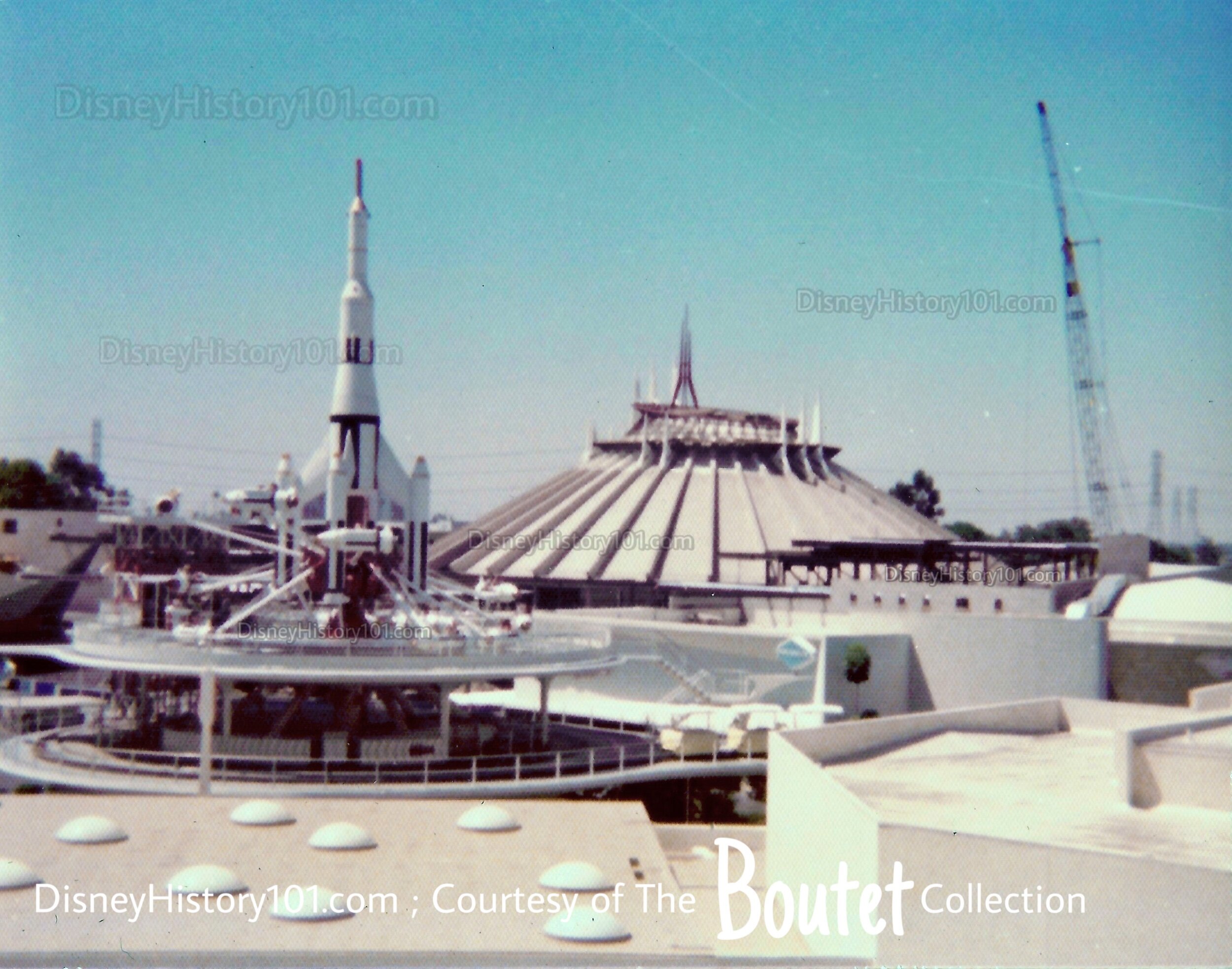
Space Mountain Complex Construction and Crane
While the tubular steel track layout of the Matterhorn Bobsleds was installed before much of the wood frame and stucco was applied, the Space Mountain show building exterior was enclosed before the steel track was laid. The length of the competed ride track was 3,035 feet, (not including the spur track, and storage track, which brought the approximate total to 3,450 feet). Soon, one Program Logic Controller (PLC) system and a Nova system (“for message generation” and alerting operators and engineers to any conditions of units) was installed. These were similar to those first installed at Walt Disney’s Magic Kingdom in Florida.
Plans for the majestic Space Mountain Show Building were still being approved by February of 1975. But as soon as construction began, LINE magazine often published the “Space Mountain Update”, to educate Cast Members on the progress of the attraction.
For instance :
•Saturday, March 5, 1977 : 2400 pounds of sand was cycled through the Mountain to evaluate structural aspects of the attraction.
•By March 10, 1977 Disneyland LINE reported : “The Spaceport Load/Unload Area construction is progressing rapidly an assembly has started on the Intergalactic Probe. All attraction control equipment has been delivered and installed, and initial ride control testing will begin [during the remairing days - March, 10th-12th] this week. All catwalks along the track have been installed. Installment of the five speed ramps is currently in progress. Regrading of the area in front of Mission to Mars was started this week. Regrading is necessary for a smooth thematic transition into the new Space Mountain complex.”
Air-conditioning controls dust, and a practical mechanical application of the technology was essential in the attraction where projection equipment and film was used.
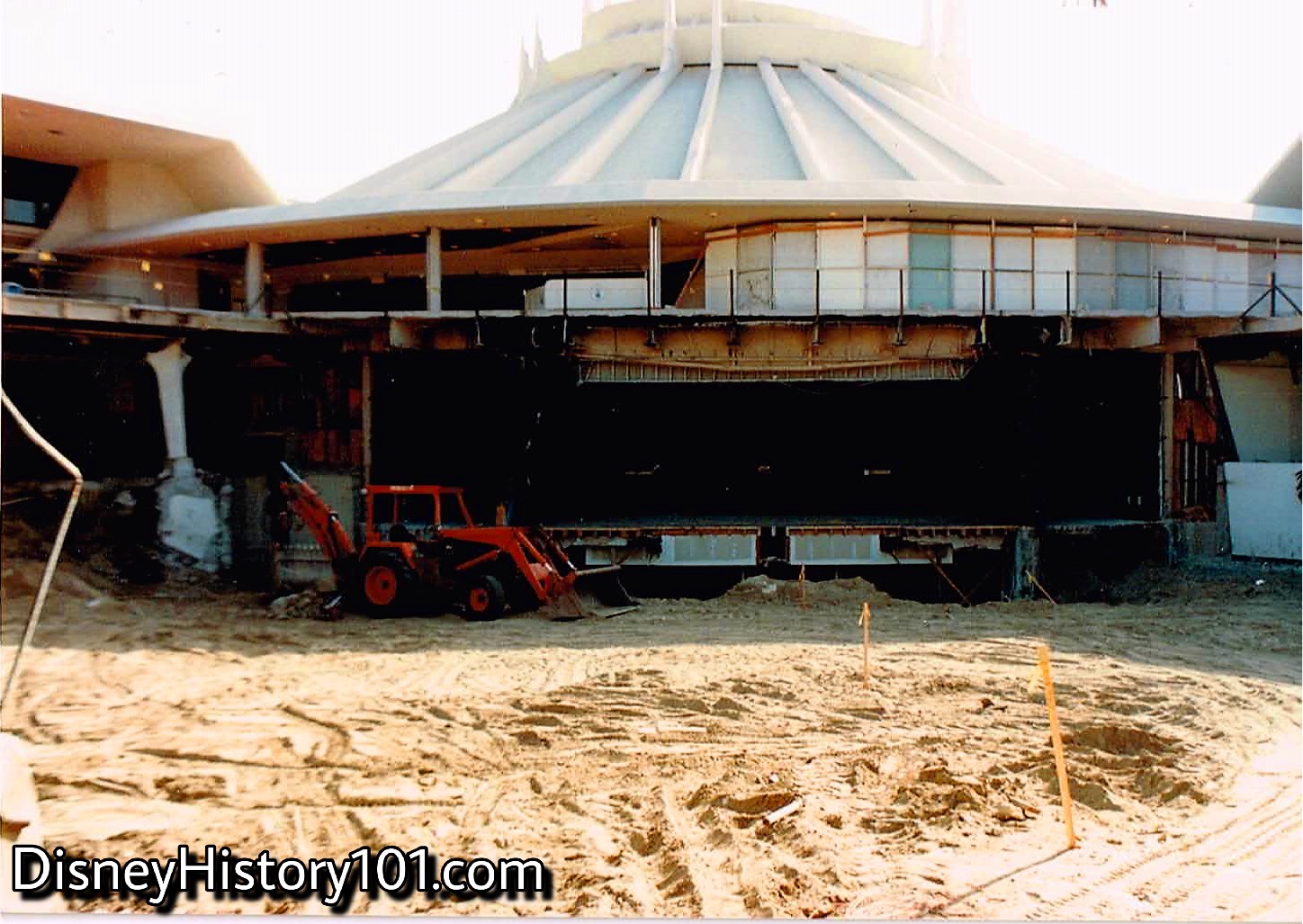
Space Mountain Complex Construction
The lower areas of the Space Mountain Complex will house a modern arcade, a merchandising shop, a fast food facility, and a large amphitheater for live entertainment.
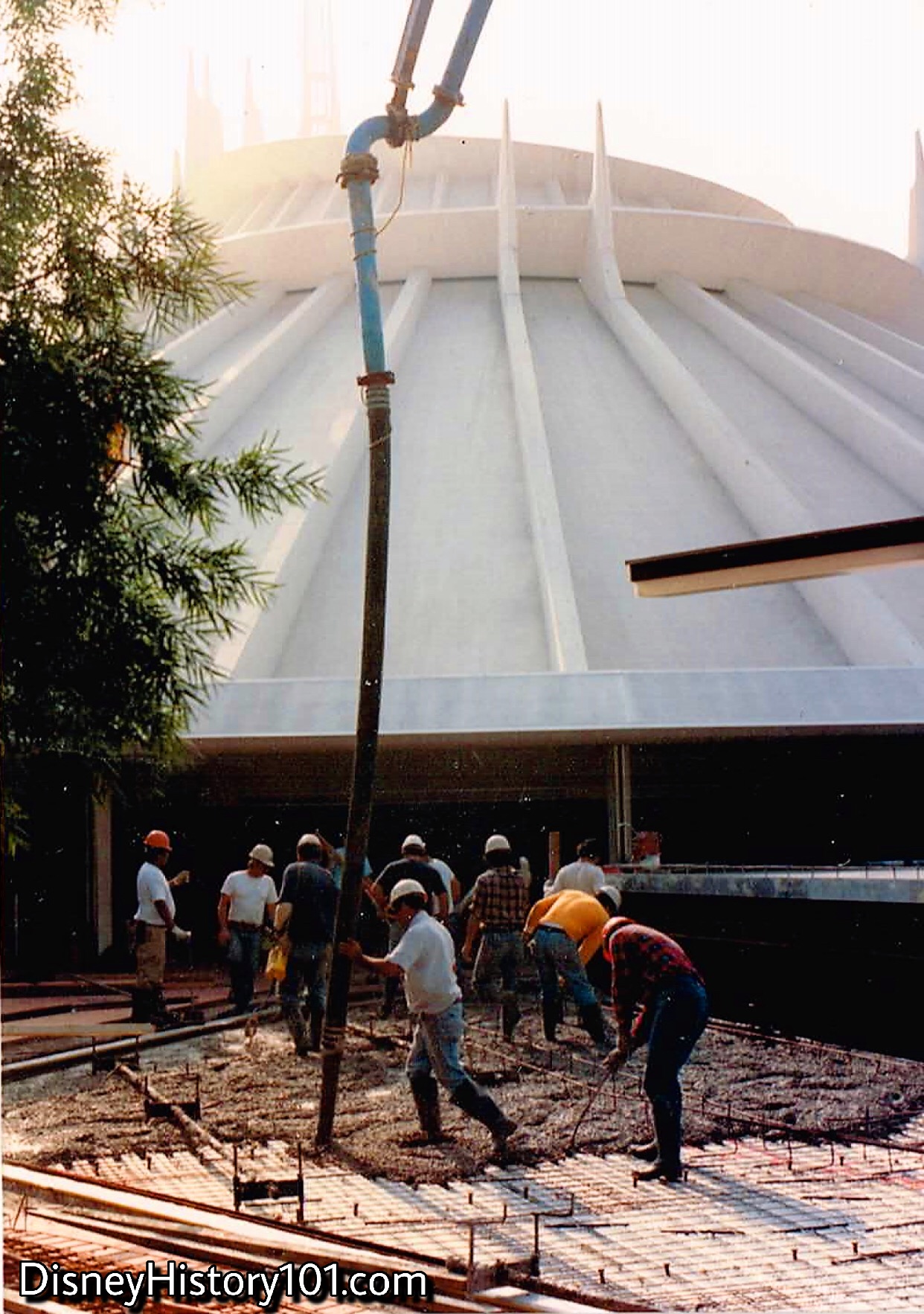
Space Mountain Complex Construction
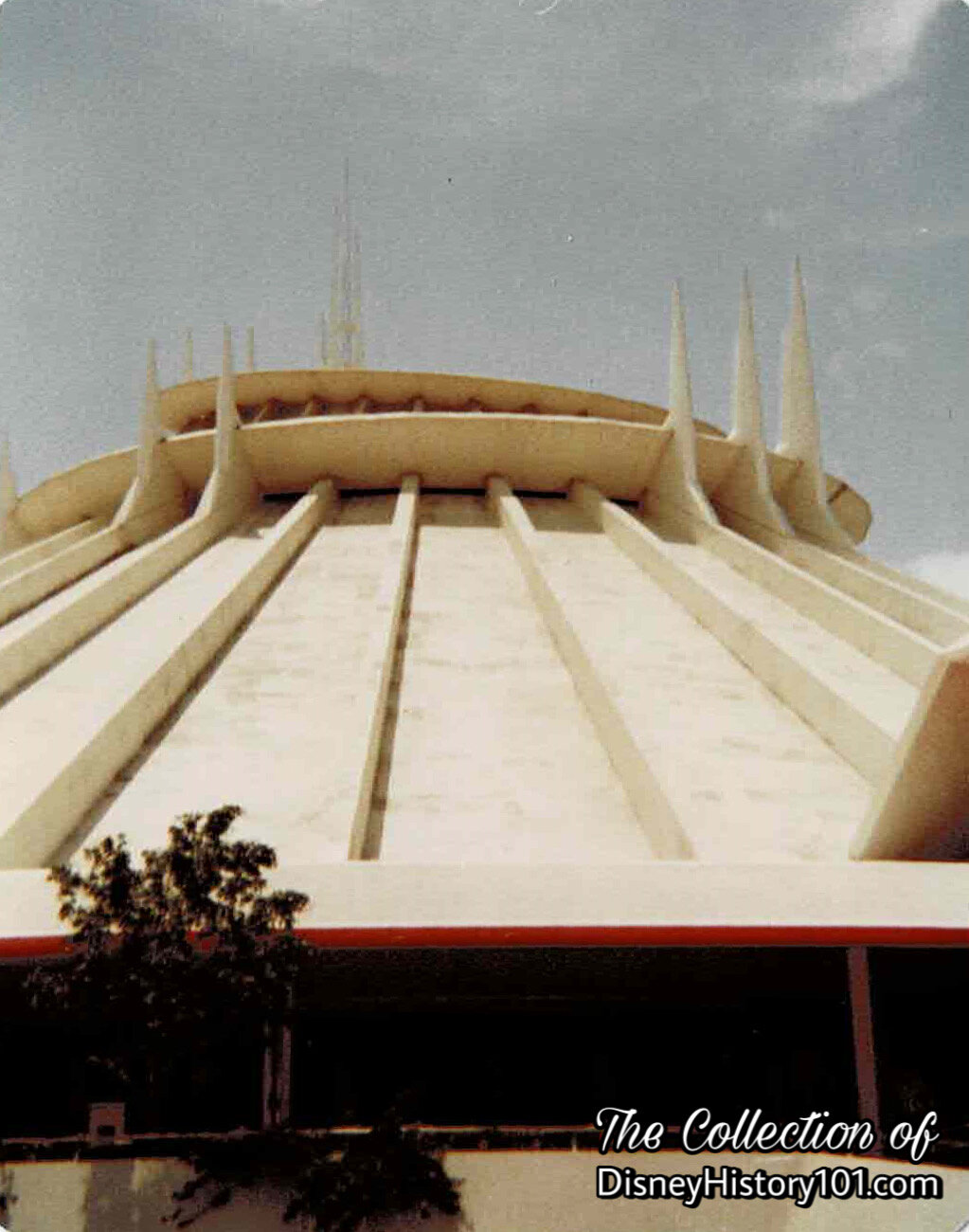
Space Mountain Complex Construction
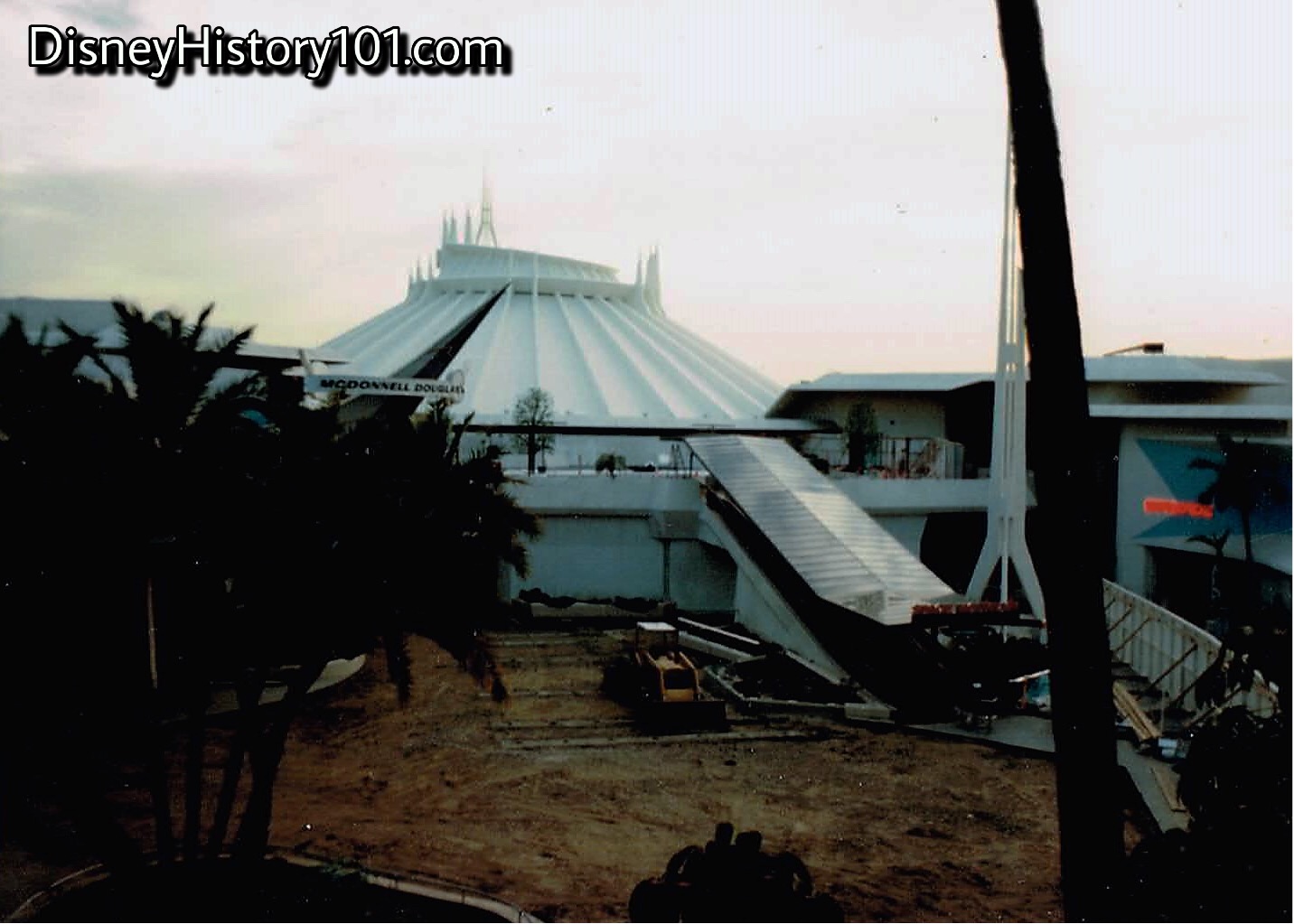
Space Mountain Complex Construction
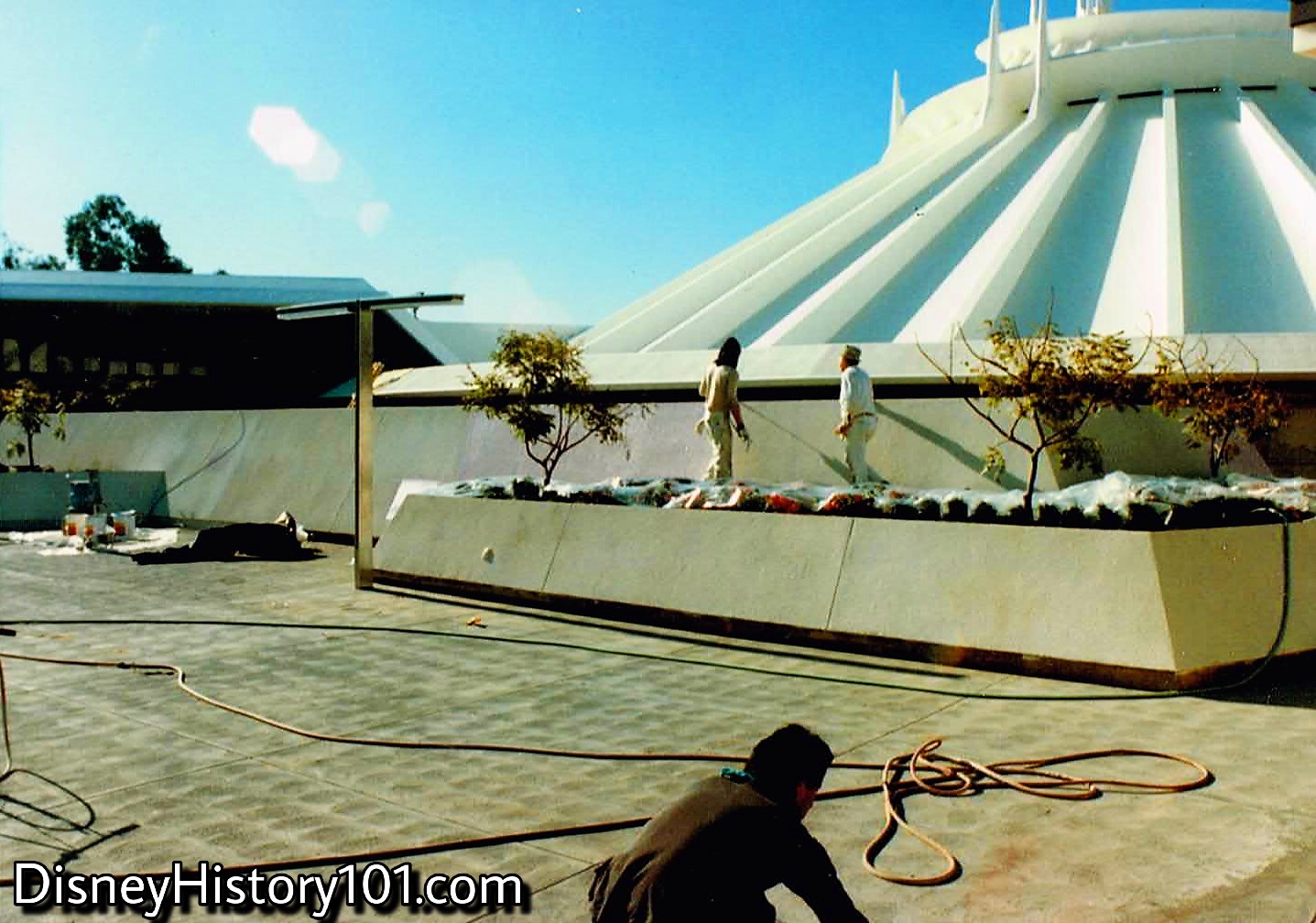
Space Mountain Complex Construction
This is where Guests will wait in an orderly fashion (queue) to board Space Mountain.
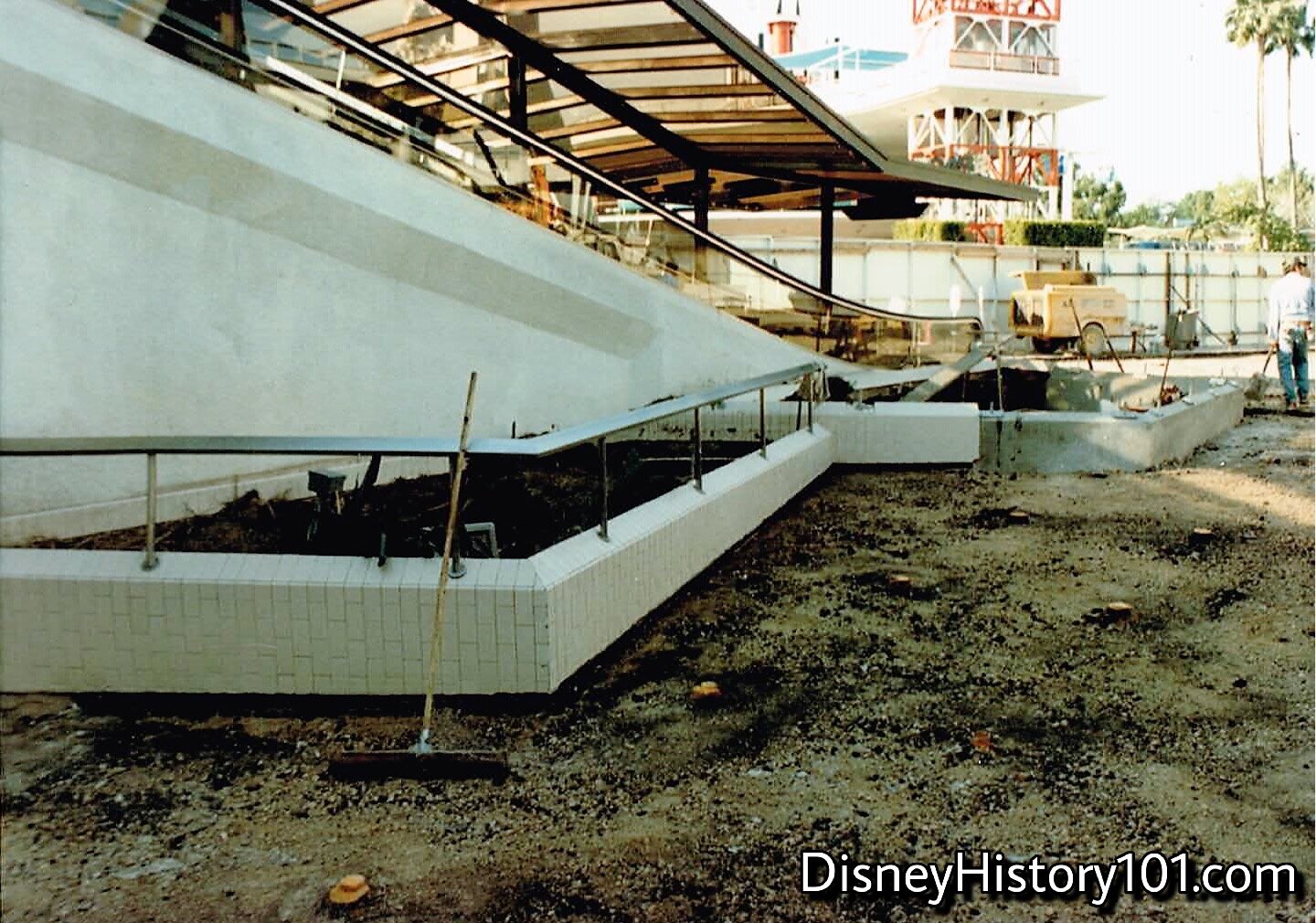
Space Mountain Goodyear Speed Ramp Construction
Disneyland “queue lines” were designed as part of the attraction to make the Guests' time in line as comfortable as possible.
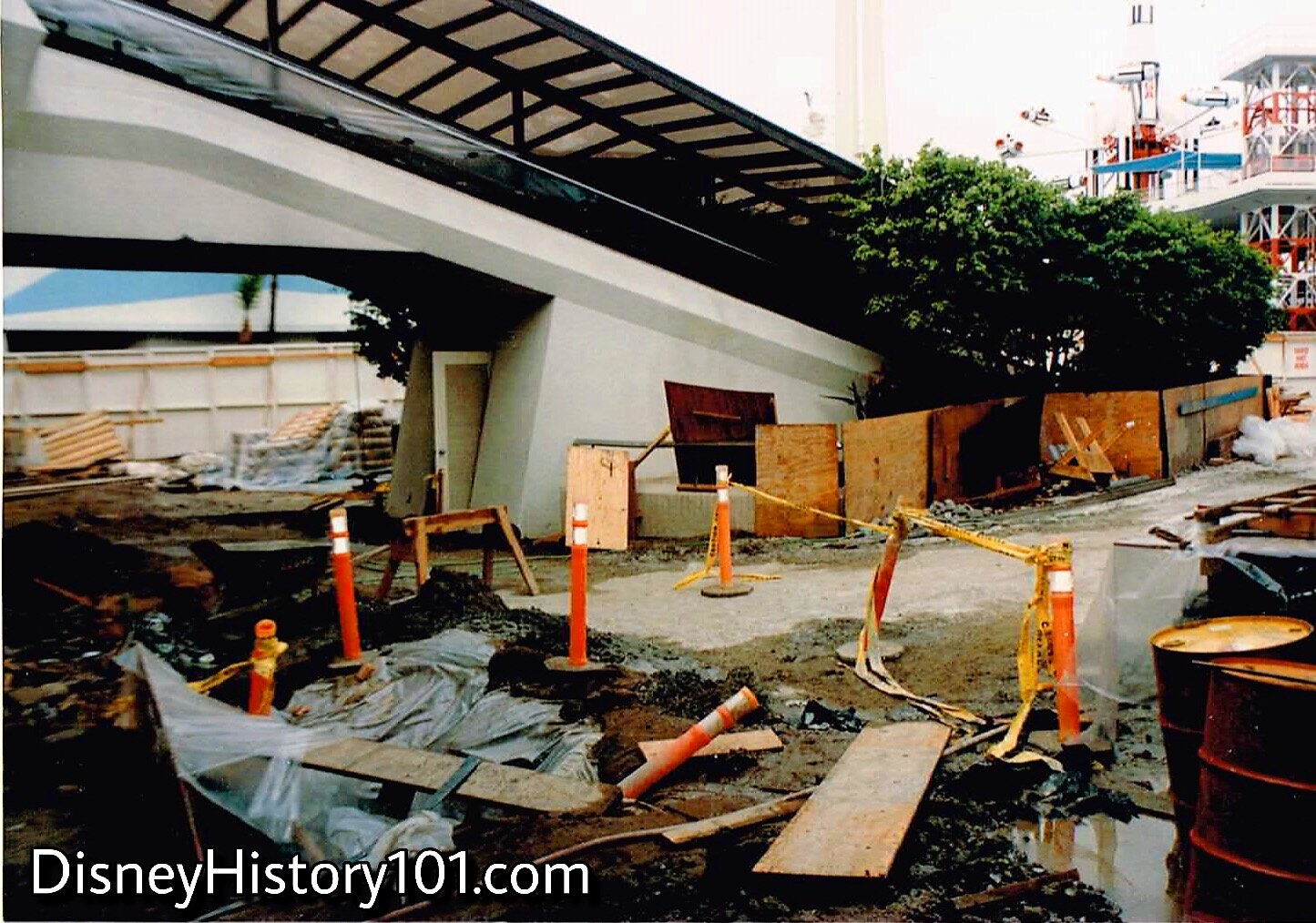
Space Mountain Goodyear Speed Ramp Construction
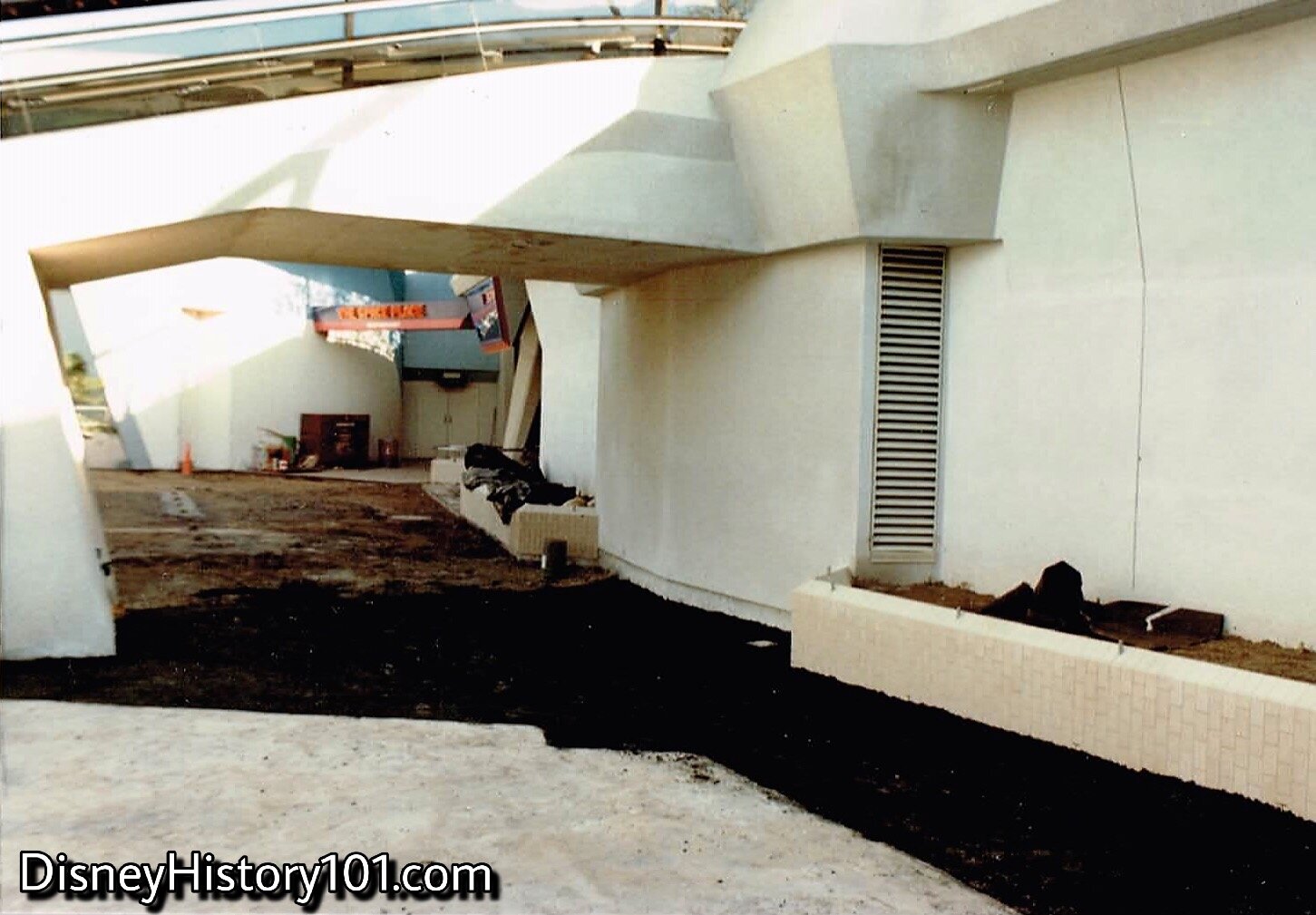
Space Mountain Goodyear Speed Ramp Construction
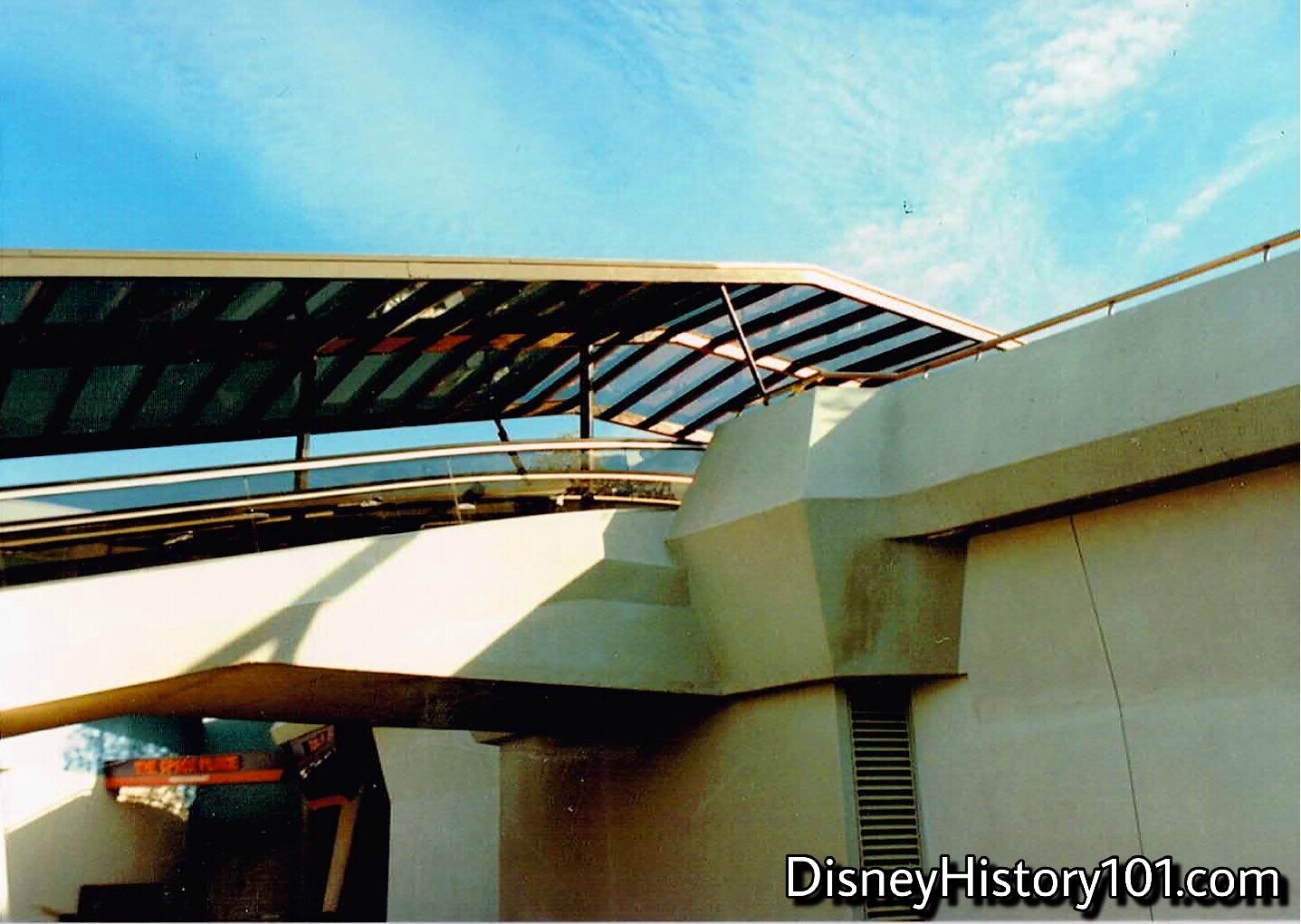
Space Mountain Goodyear Speed Ramp Construction
Two moving sidewalks (similar to the Stephens-Adamson Speedramp at the Tomorrowland Monorail Station) were installed in front of Space Mountain. These Speedramps would help guests to the upper concourse (and ride entrance).
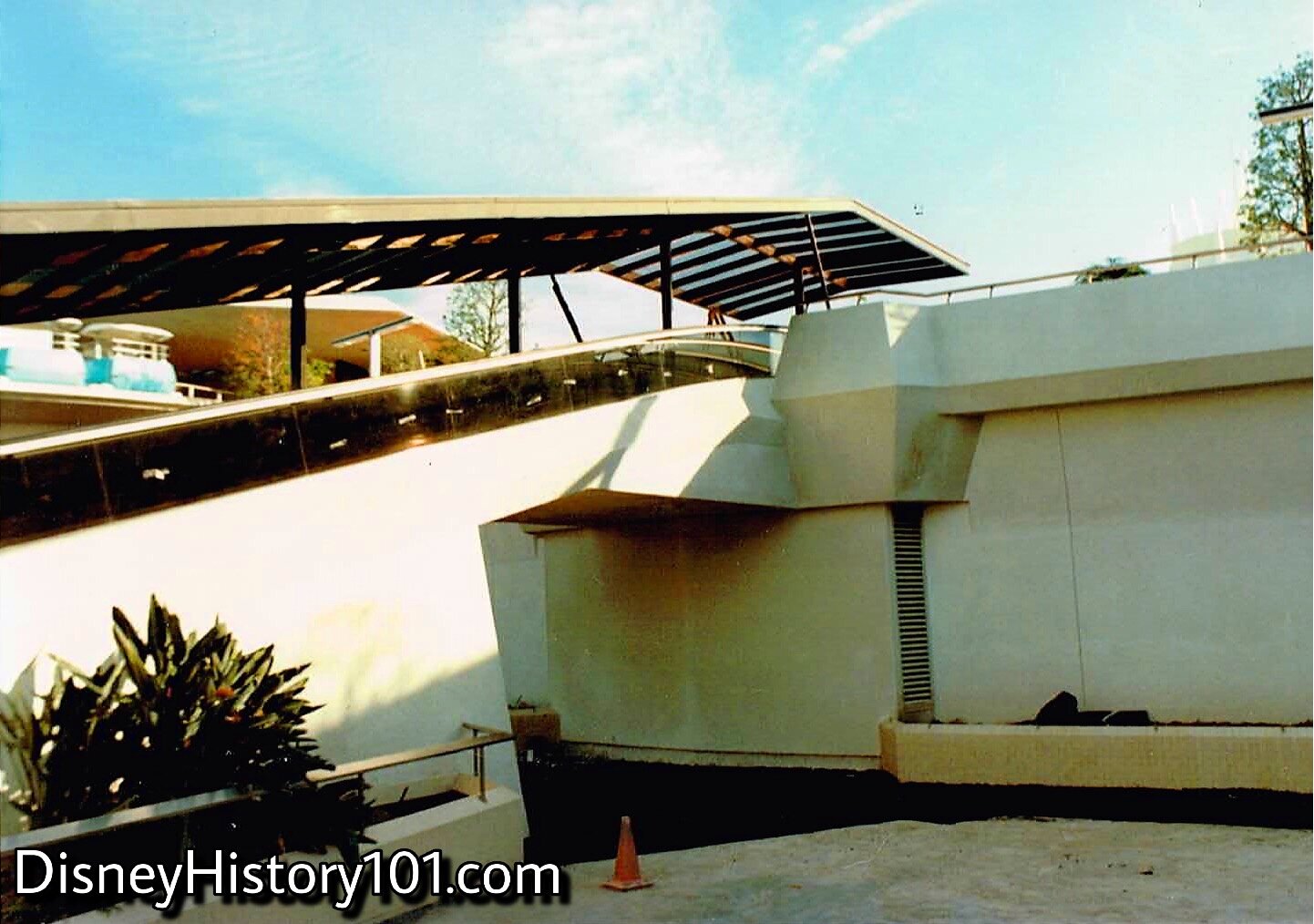
Space Mountain Goodyear Speed Ramp Construction
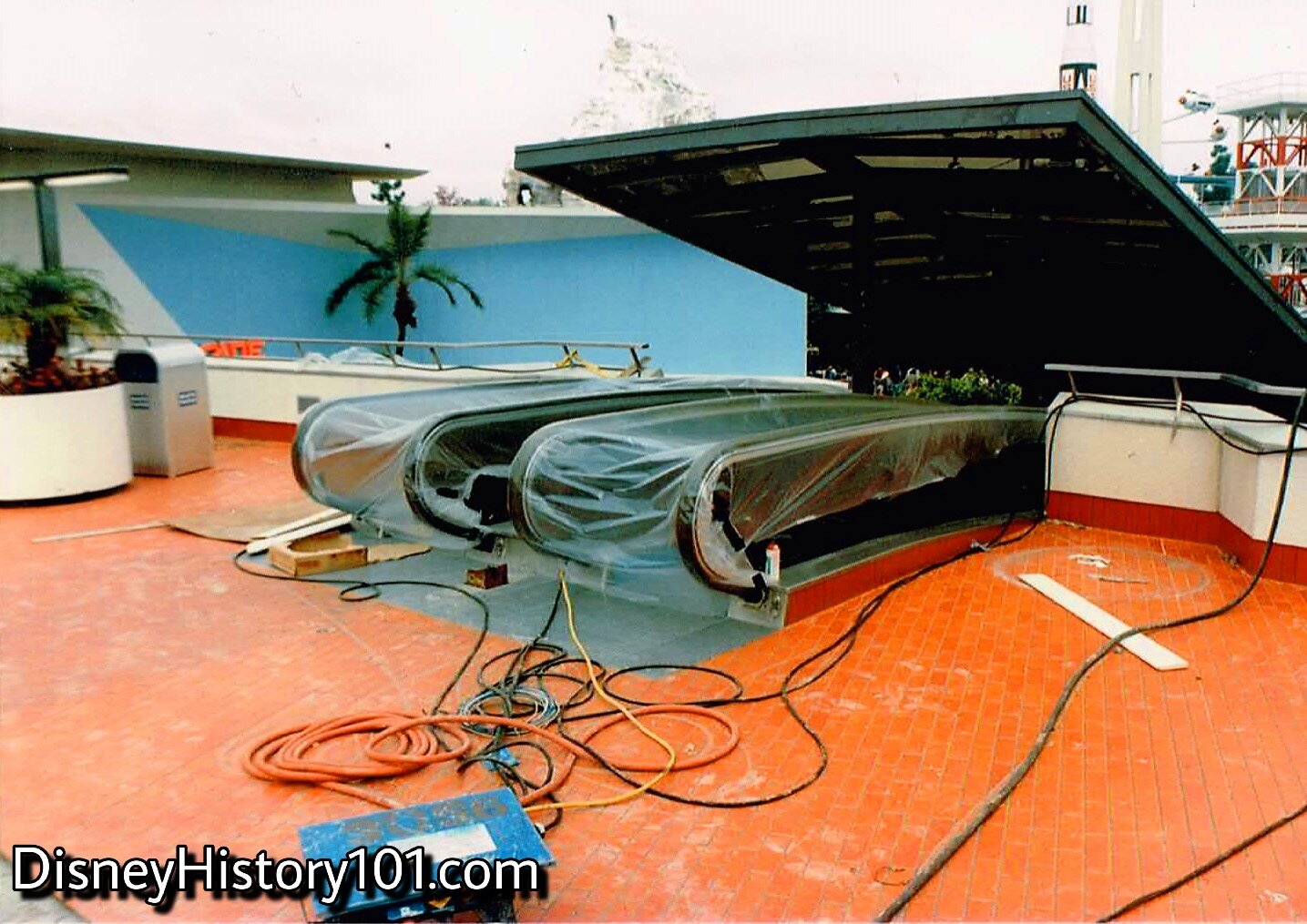
Space Mountain Concourse and Goodyear Speed Ramp Construction
In 1981, the “I-Have-An-Idea” Program yielded new Starcade and Space Mountain Speed Ramp handrails, courtesy of Phil Hilde, Larry Johnson, and Virgil Stroud of the Disneyland Mechanical Department. Under the older system the handrails were wearing out and being replaced every three weeks. Under the new Guest Control queue area routing system, the handrails only needed to be replaced every four or five months.
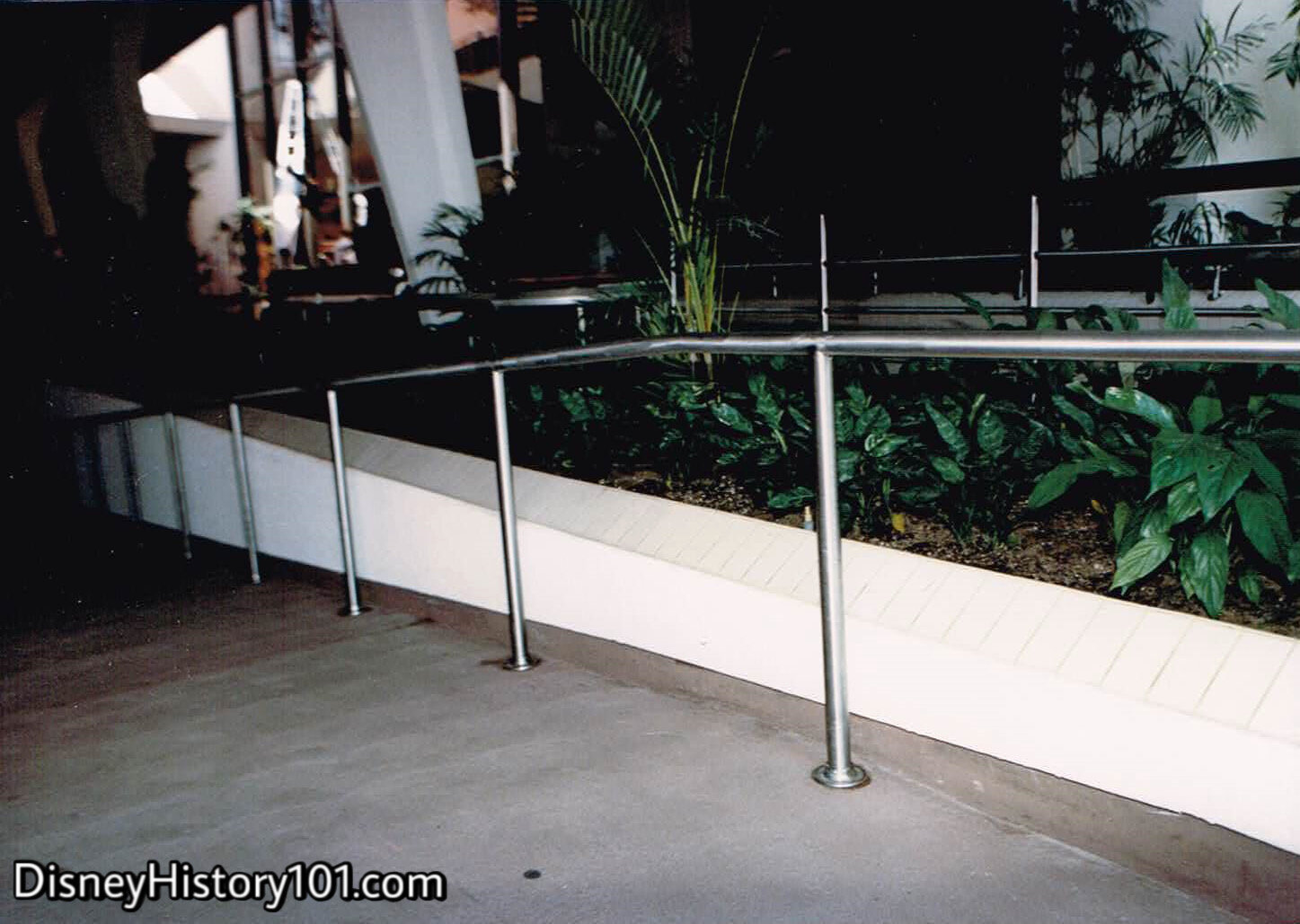
Space Mountain Complex Overhaul Construction
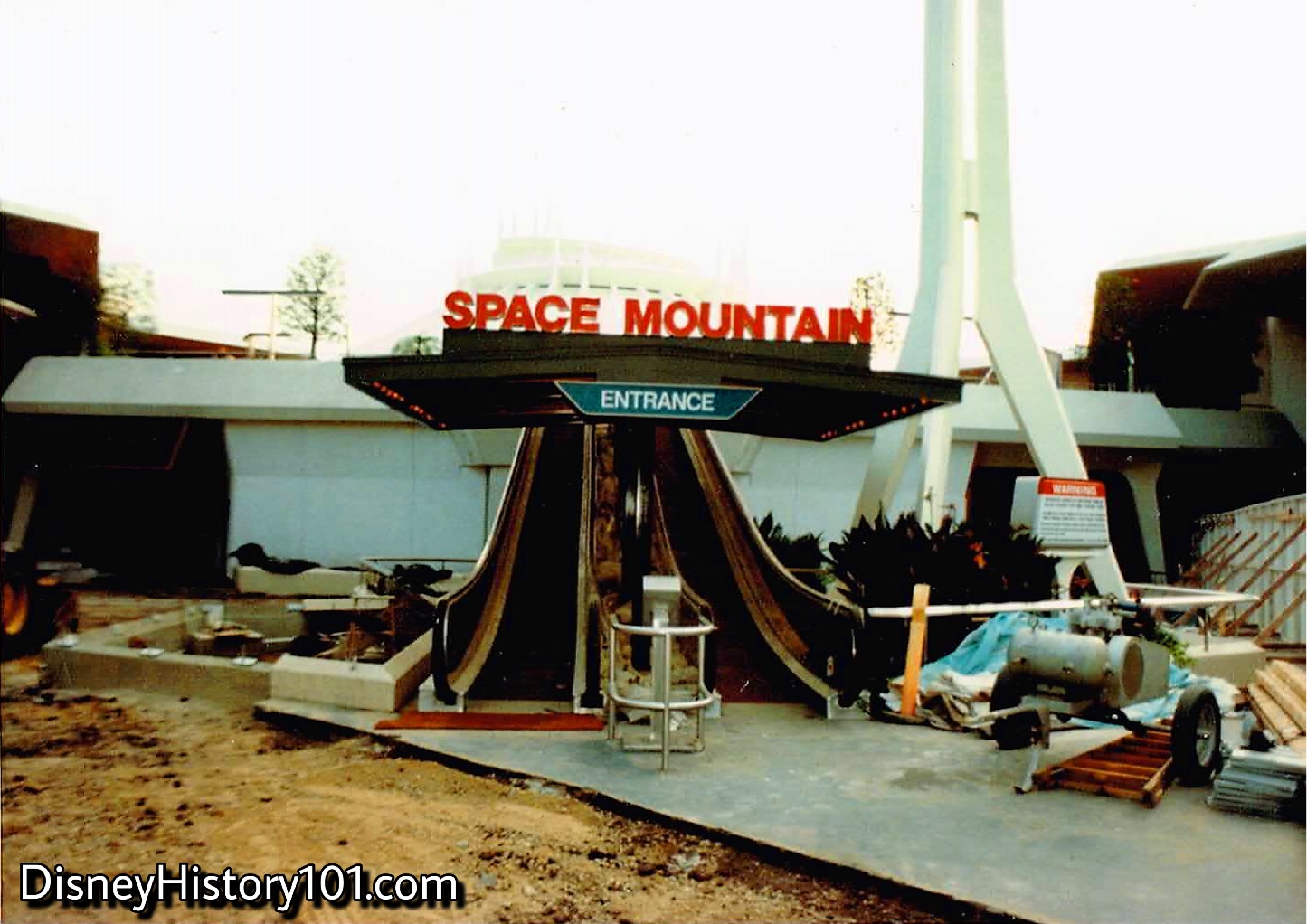
Goodyear Speed Ramp Installation
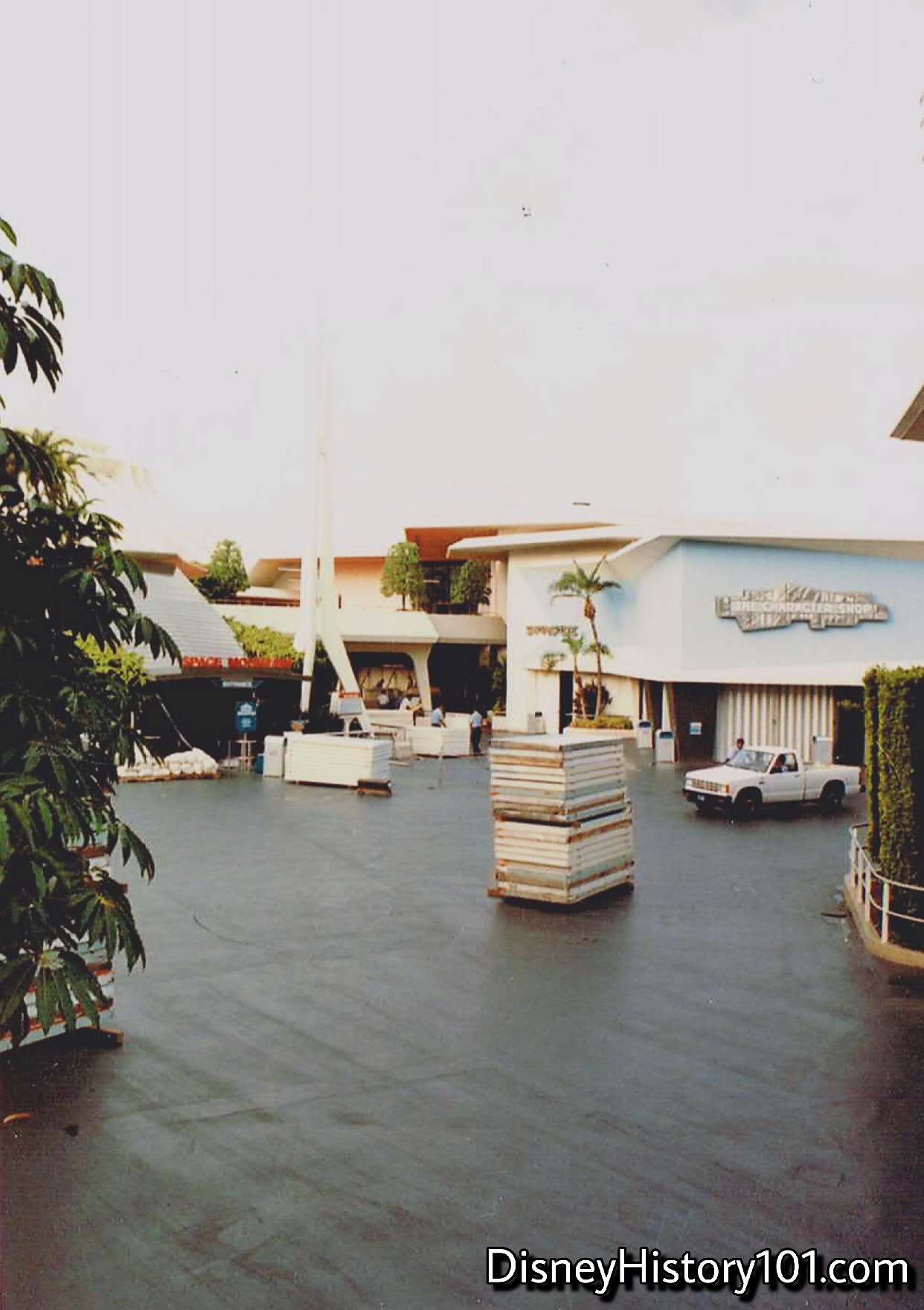
Slurry Completed After Space Mountain Complex Overhaul
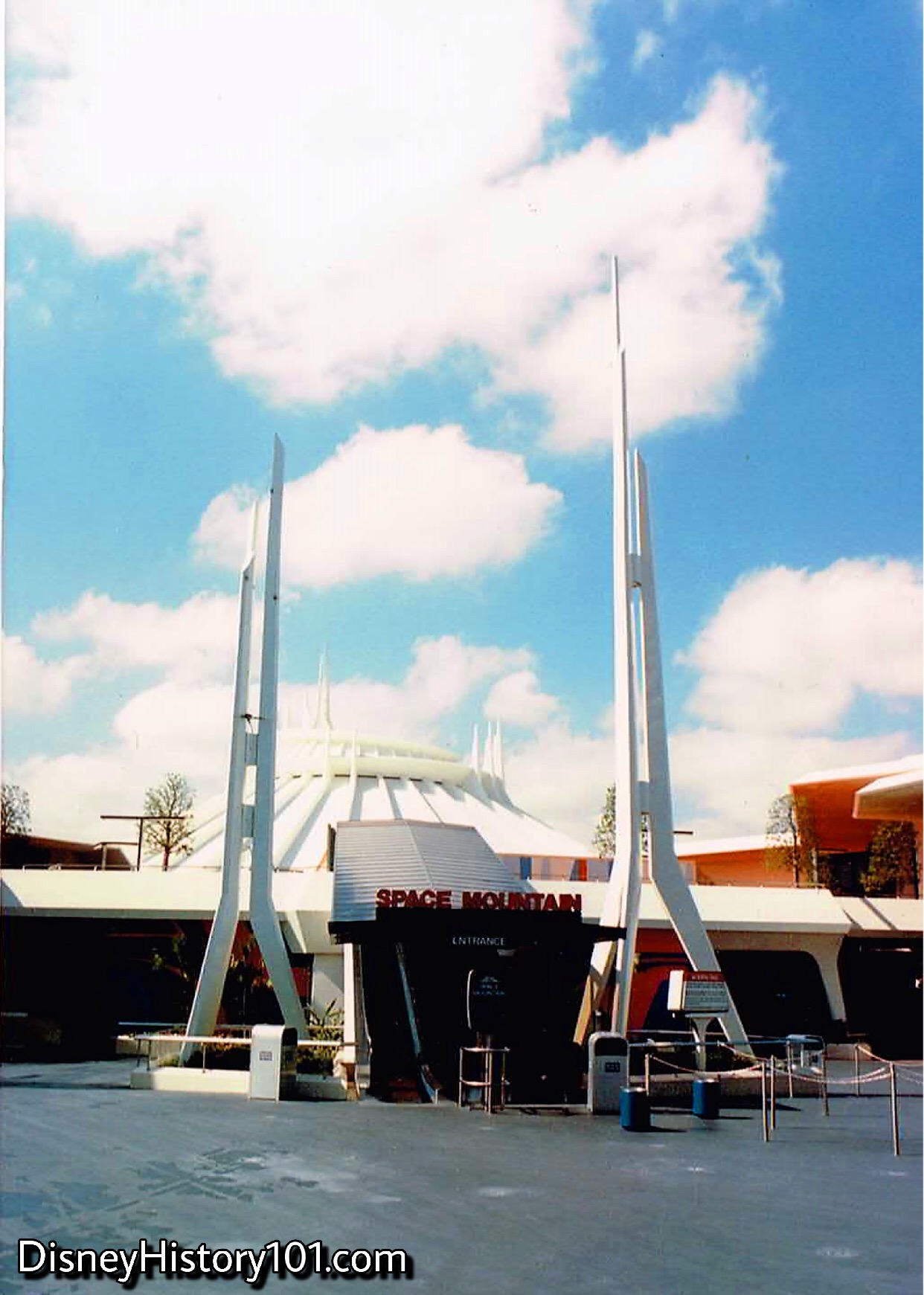
Overhaul (both installation and completion) of Space Mountain and its efficient Goodyear Speed Ramp.
Two coats of an Elastomeric Coating are applied (over a span of weeks) to the 100,000 square feet of peaks that comprise the surface of the Space Mountain complex. The resulting finish will last up to five years according to Disneyland LINE (June 29, 1978).
Due to the ongoing construction in the Backstage Area, the Hills Bros. Gate was not used during the Easter Parade of April 10, 1977 (at 2:00 pm). The route would run from the Fire Station Gate to the Small World East Gate.
After 12 years of planning and two years of construction, Space Mountain was completed during May of 1977. Press Release packets divulged the following “operational data” about Space Mountain.
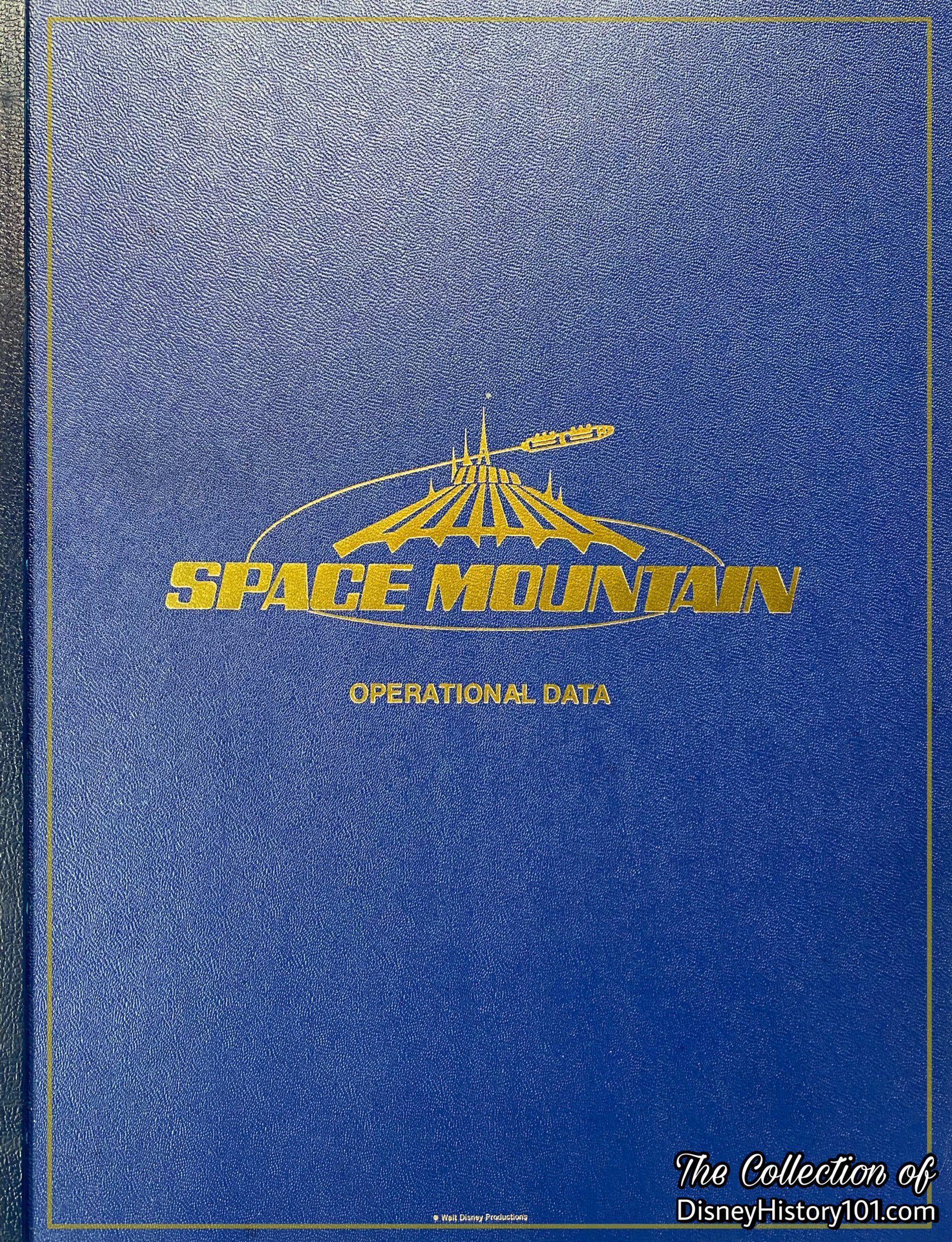
Operating Guide/OG
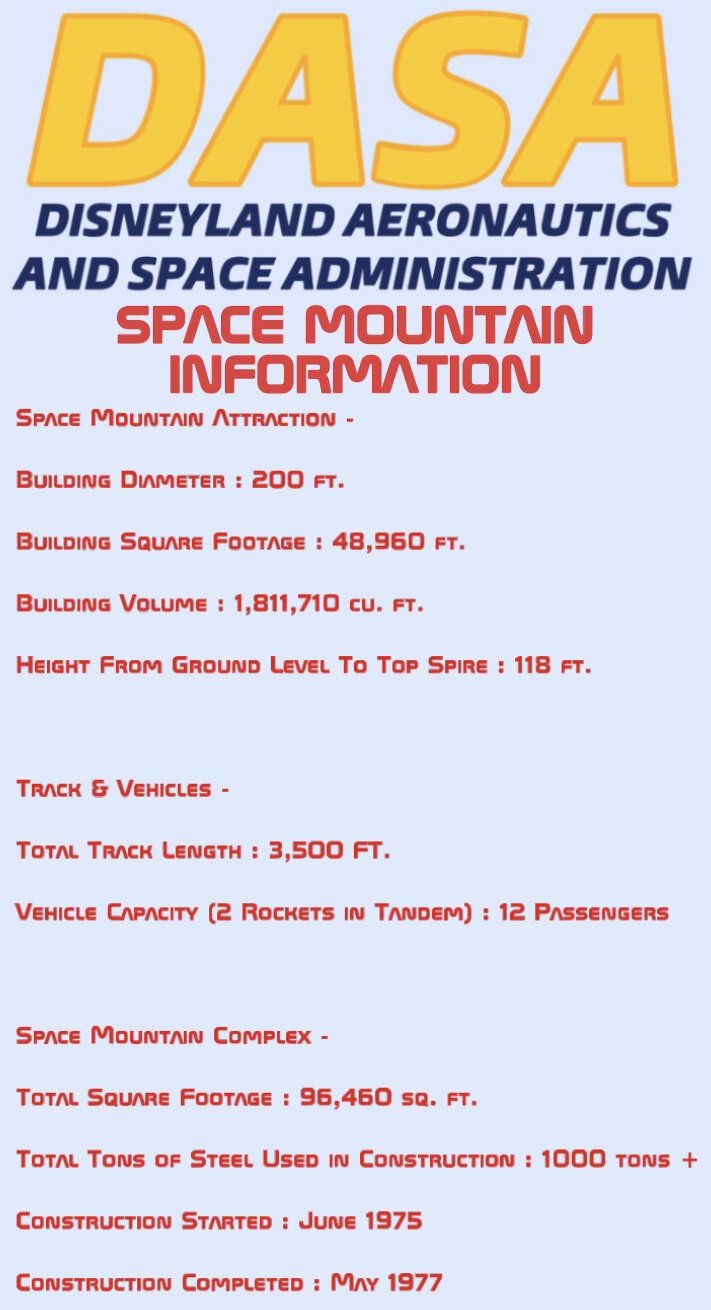
Disneyland Publicity Writers of the Marketing Division (Bob Roth, Frank Whiteley, and Al Flores) were very busy brainstorming Press campaigns related to the big grand opening! Meanwhile, quite a few Disneyland Cast Members recall becoming “test pilots.”
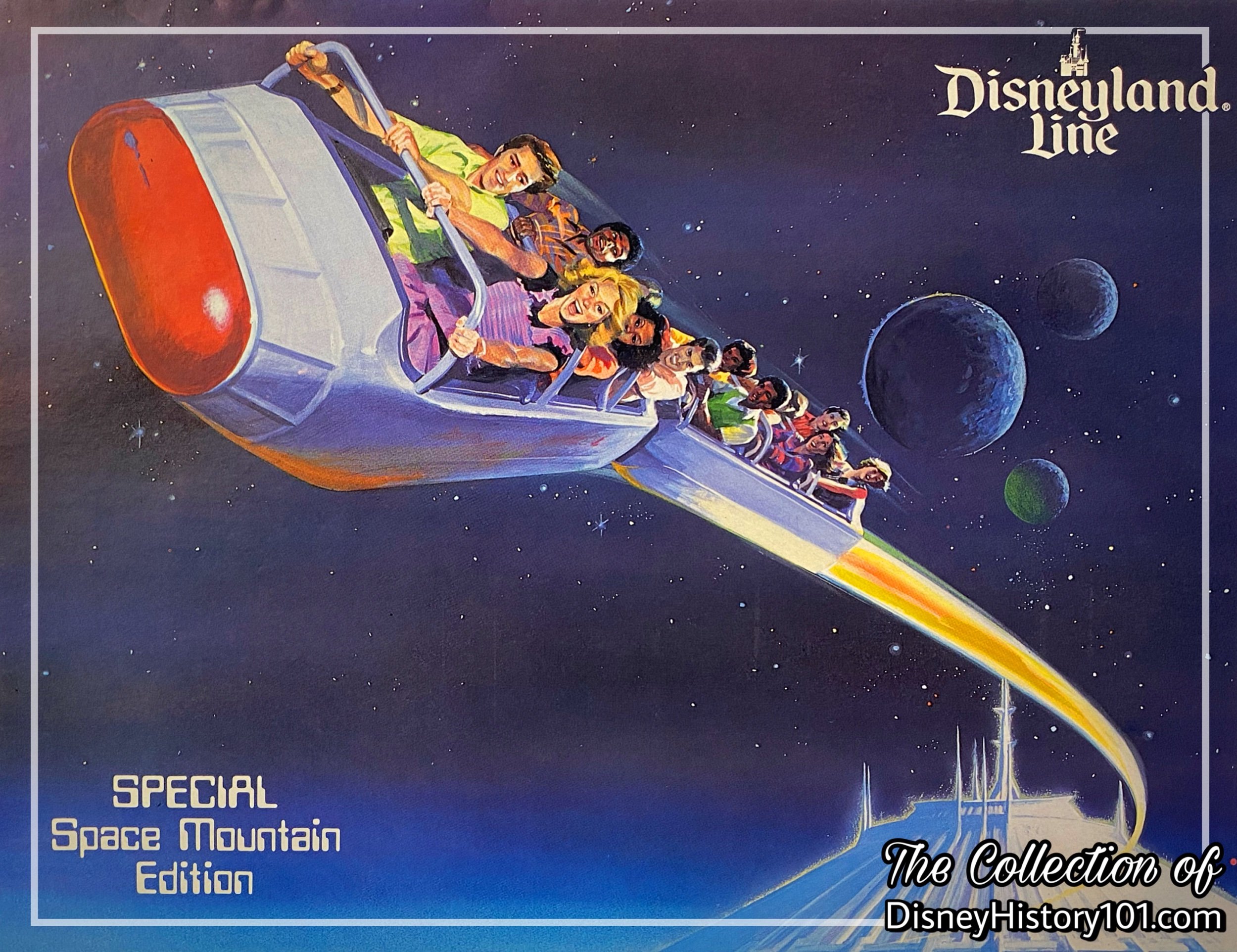
According to writer Donia Ruescher:
“Space Mountain captures the essence of Superspace. The expectant ‘space voyager’ is transported through the space station launch portal, and through the vast man-made ‘solar field.’ He then orbits the glowing ‘satellite,’ become engulfed in spectacular nebulae and plunges past myriads of strange stars and unknown galaxies to begin reentry.”
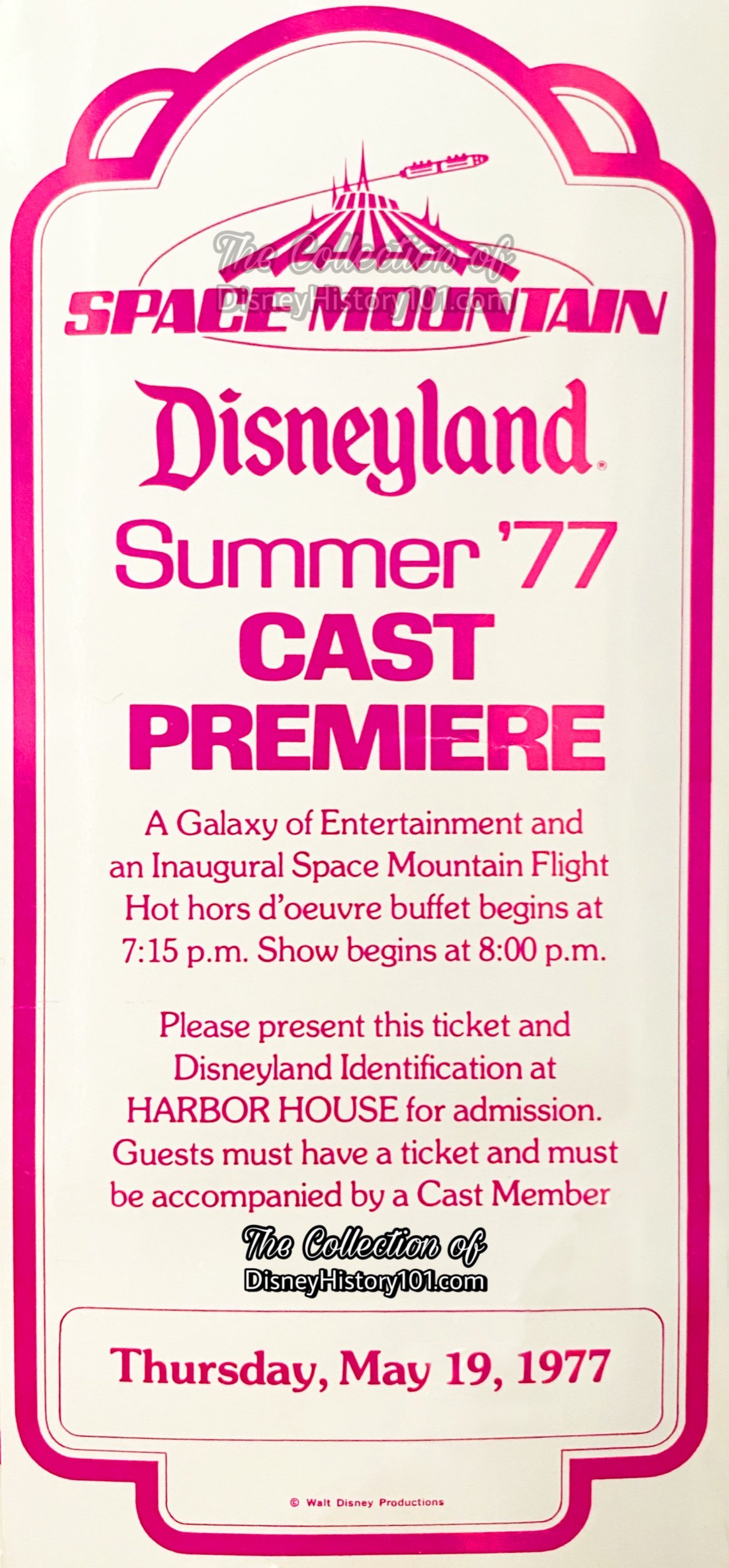
Space Mountain - Disneyland Summer '77 Cast Premier Ticket, (May 19, 1977)
While a few fortunate Disneyland Cast Members recalled test piloting Space Mountain well before the official Disneyland Cast Premier, most of the Cast attended the Disneyland Cast Premier to be accounted among the Inaugural Flight Crew. These lucky astronauts were given these mementos of their journey!
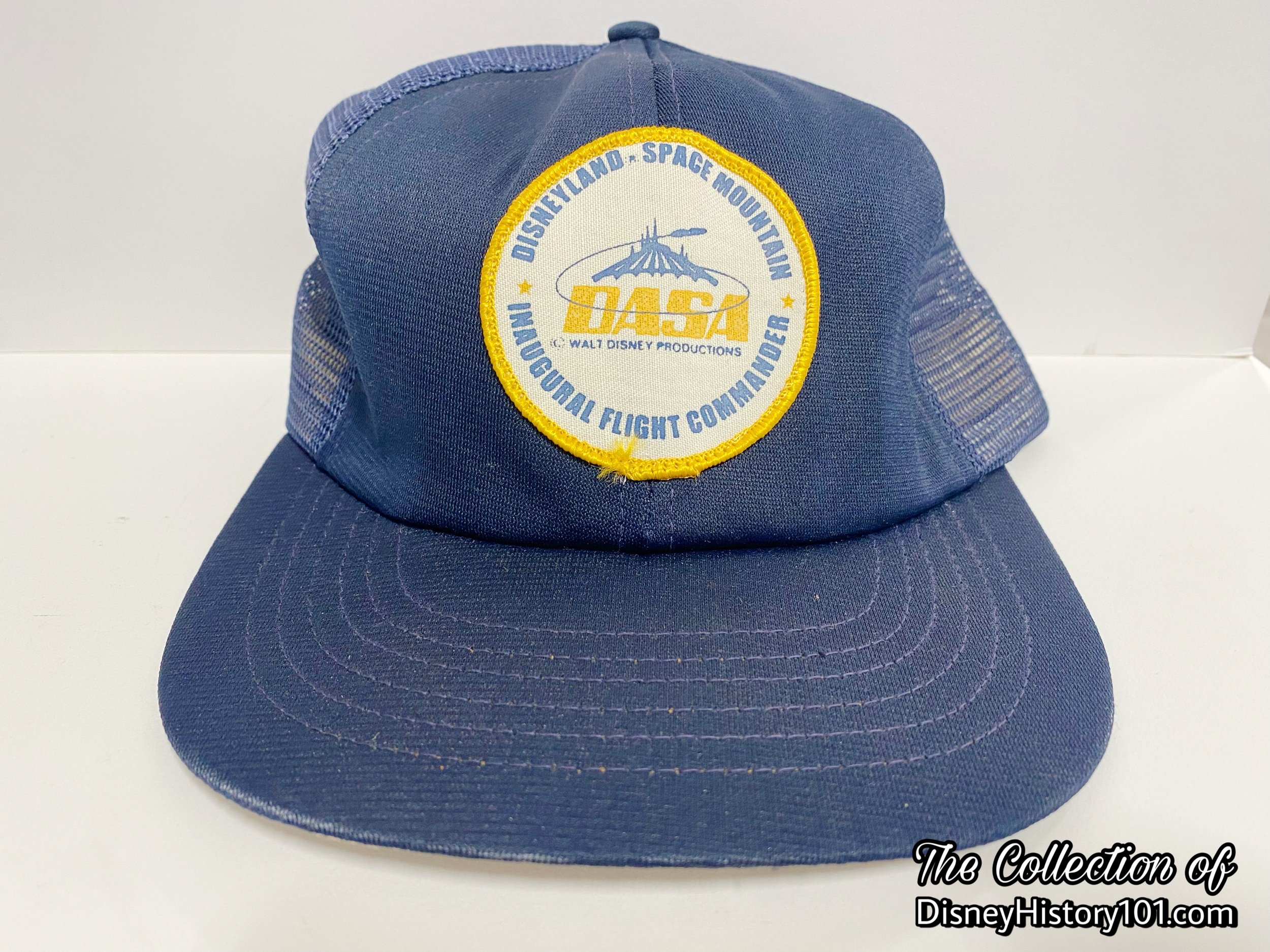
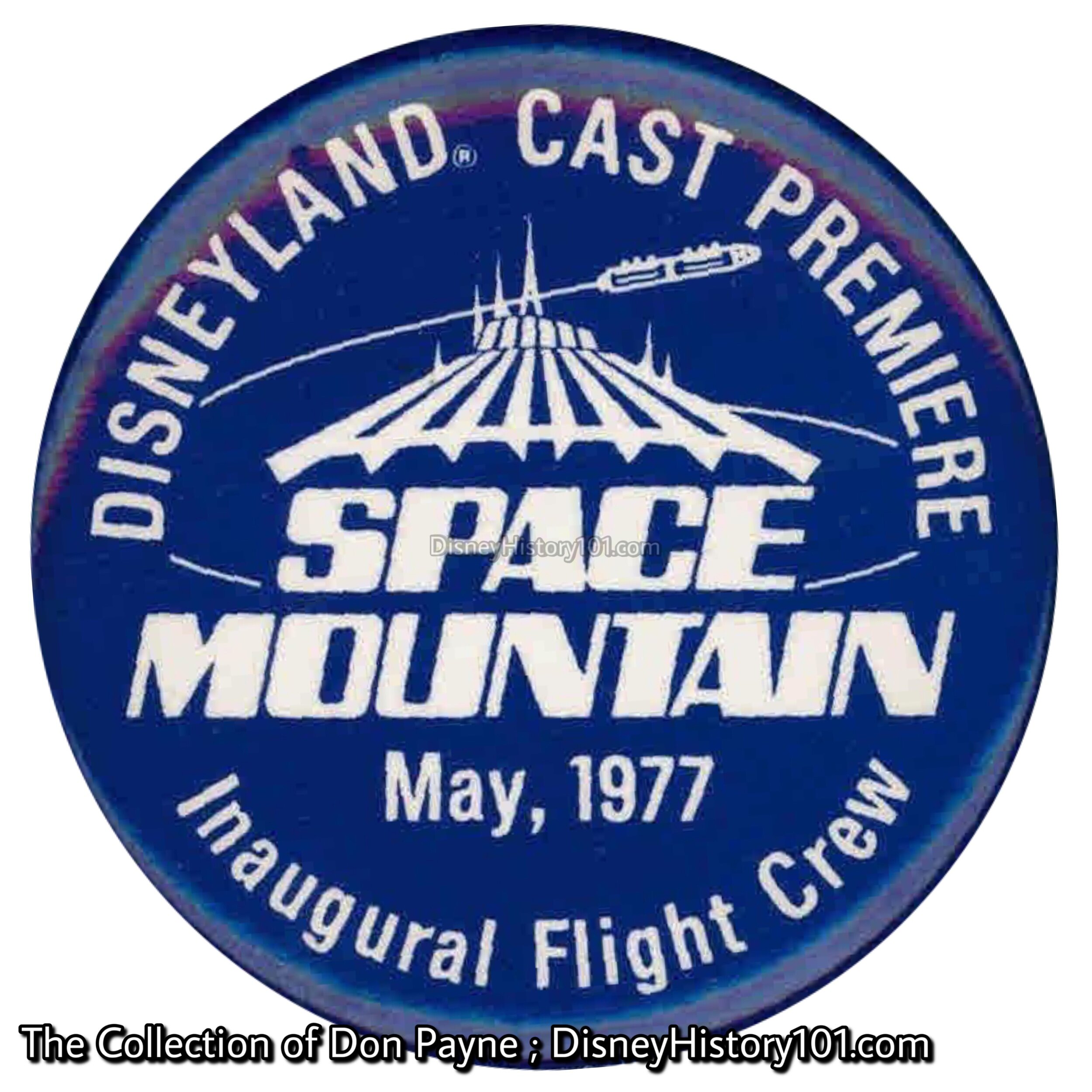
Disneyland Cast Premier Inaugural Flight Crew Button
“More than 6,000 Disneyland Cast Members and their guests enjoyed Space Mountain Cast Premiere ceremonies over five nights during the last two weeks in preparation for the Grand Opening of our new Tomorrowland addition this Friday, May 27.” [Disneyland Line, May 26. 1977]
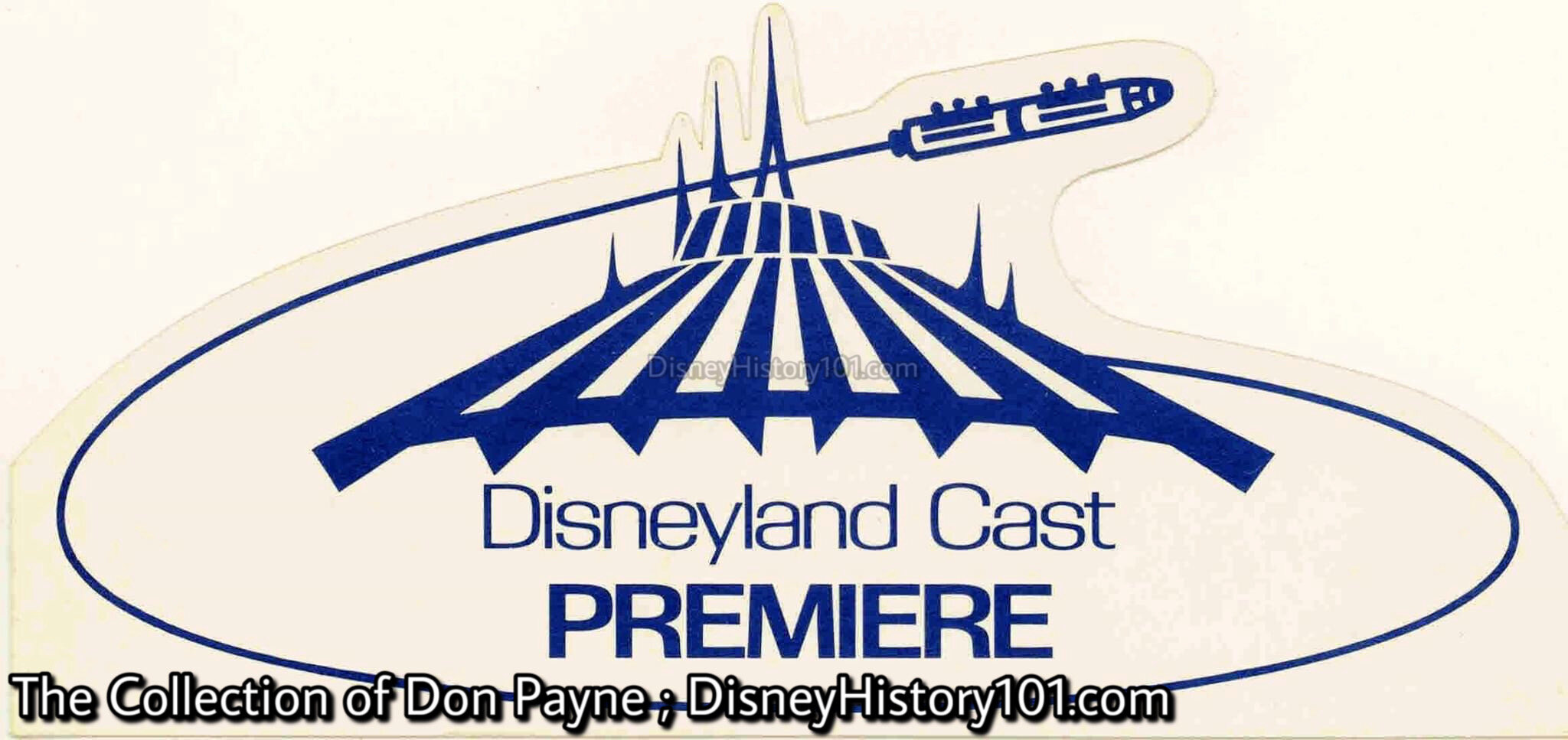
Disneyland Cast Premier Sticker
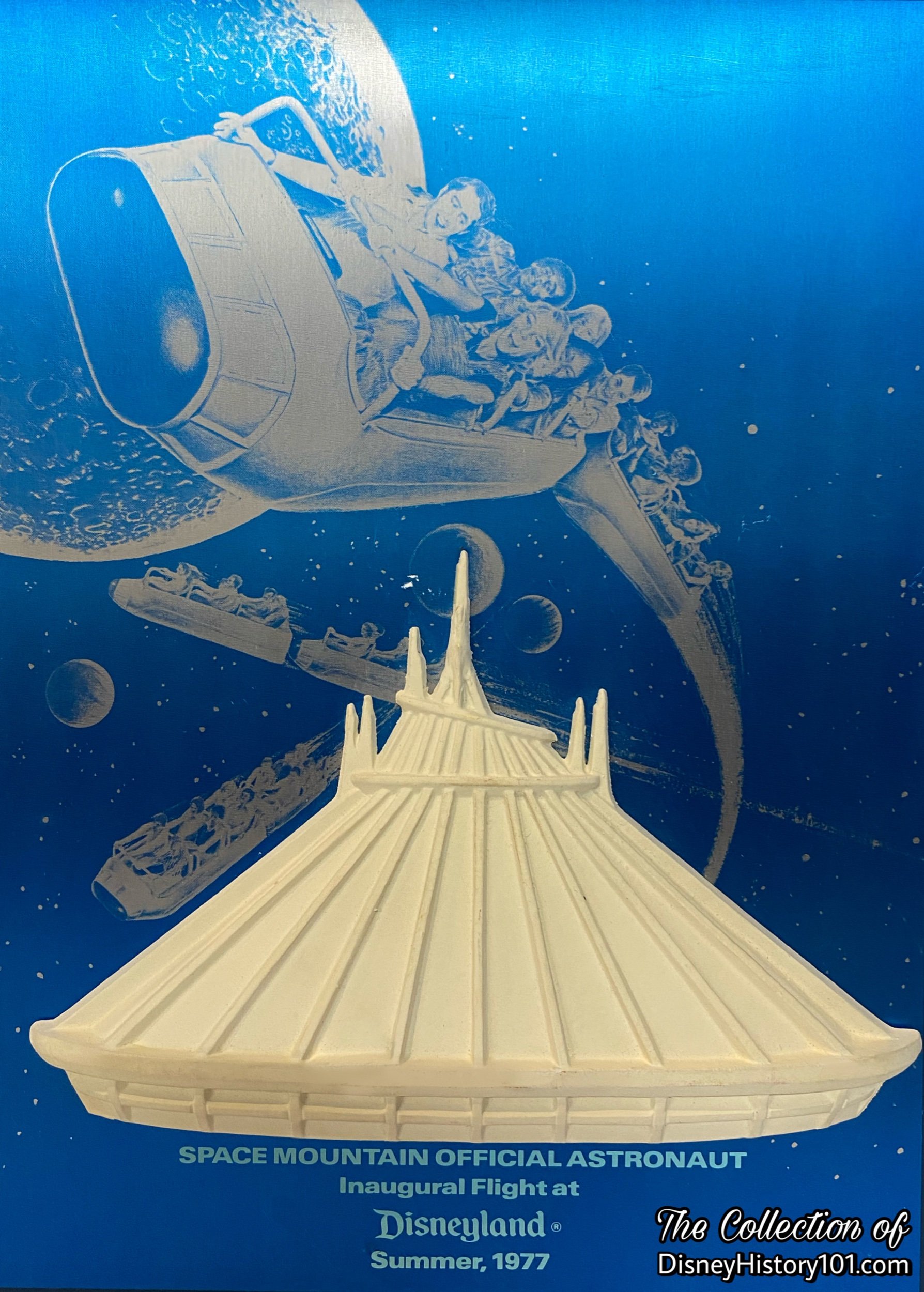

Space Mountain Day at Disneyland for WED & MAPO Ticket, (May 22, 1977)
On May 27, 1977, “space travelers” led by true-life Mercury astronauts (Alan Shepard Jr., Walter Schirra Jr., Virgil Grissom, Colonel L. Gordon Cooper, Donald Slayton, Commander M. Scott Carpenter, and William Douglas) were gathered after eighteen years, and welcomed to Futuristic Station - a massive spaceport! Some of these astronauts had been involved with other flights (Mercury 7, Mercury 8, Mercury, 9, Gemini 5, Gemini 6, Apollo 7, Apollo 14, and the Apollo-Soyuz Test Project). Their 18-year reunion was officiated by Disneyland Ambassador Susan Donald, and would span three days (May 27 - 29, 1977). These were joined by John Glenn Jr. (of Mercury 6) for a tour on the Saturday following the Grand Opening. For now (May 27th, 1977), these astronauts entered the attraction queue, and stepped aboard futuristic Speedramps (in service from 1977 to 1997), to help move comfortably from the ground floor to the upper level of Tomorrowland. Transmissions from Mission Control and Flight Dispatch echo through the Space Port, as the Mission Status Board charts current Space Flights. Guests make their way past windows where rockets streak by with flashes of light (as stars glitter in the distance). After passing below the hovering Intergalactic Probe (which “warms its engines for an explorative venture into the unknown”), guests boarded one (of twelve) sleek rockets bound for the “vast dark void of outer space”. Moving slowly along an ascent, the rockets prepare for “blast-off”. Their ascent takes them through meteor showers, “passing through the apparent infinity of a Solar Energizer, where chasms of light seem to stretch forever”. Circling a glowing geodesic satellite, the rockets approach a colorful gaseous nebula, shooting stars falling to each side. Suddenly the rockets reach the apogee of their ascent and quickly plunge into the realm of ‘Superspace’, where time is non-existent and distances are spanned at infinite speeds. Roaring past unexplored galaxies the rockets twist, turn and dip thier way home, finally bursting through a cosmic vapor curtain before slowing to landing speed at the Space Port”, according to the Disneyland Aeronautics and Space Administration’s “Space Mountain Rockets.”
Even after that event, a WED/MAPO Official Inaugural Flight event was held on June 2nd, 1977, with commemorative posters given to all those who participated.

Disneyland’s spectacular new $20 million voyage thru outer space (or, journey along 3,450 feet of track, at maximum speeds of 30 to 32 miles per hour) - Space Mountain - was “the most incredible attraction in 22 years,” according to Vacationland magazine, Summer, 1977). Eight years after the live broadcast of the Apollo Moon Landing was viewed (on this very location) and during the summer of 1977, thousands of Disneyland Guests waited in lines to board Space Mountain. These impressive lines (“kept on queue” by Audience Control Crews) wound all the way through the Tomorrowland Mall, and clear to the entrance of Tomorrowland (a picture of this can be viewed in “Backstage,” Summer of 1977). Just two years later (by 1979 - 1980), it was still just as “incredible,” as admission for a flight through Space Mountain was one “E” coupon, the same as passage down the icy slopes of the Matterhorn, stepping aboard Big Thunder Mountain Railroad, or admission to the Country Bear Jamboree. This was with good reason - Space Mountain was a realization of one of Walt’s “dreams”! At this point, we must recall the words of John Hench who once said, “We didn’t just build this because we needed another thrill attraction…Walt always intended this to be here and we never abandoned the idea.”
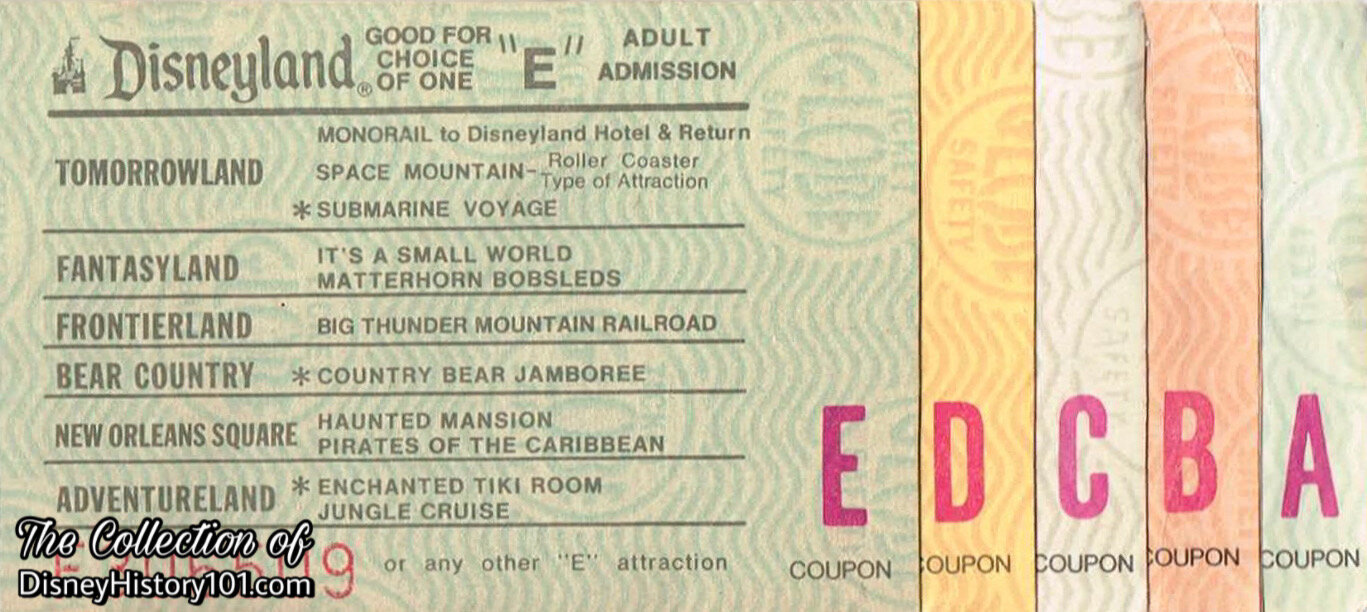
The Disneyland Planning Department prevented having too many attractions of the same ticket value down at the same time.
While five years of negotiations were underway for Tokyo Disneyland, it was decided to bring the smaller incarnation of Space Mountain (Disneyland, Anaheim, California) to Japanese guests! Space Mountain opened at Tokyo Disneyland, on April 15, 1983!
A new Space Mountain ride control system was installed in 1988, which simplified the role that Hosts and Hostesses performed.
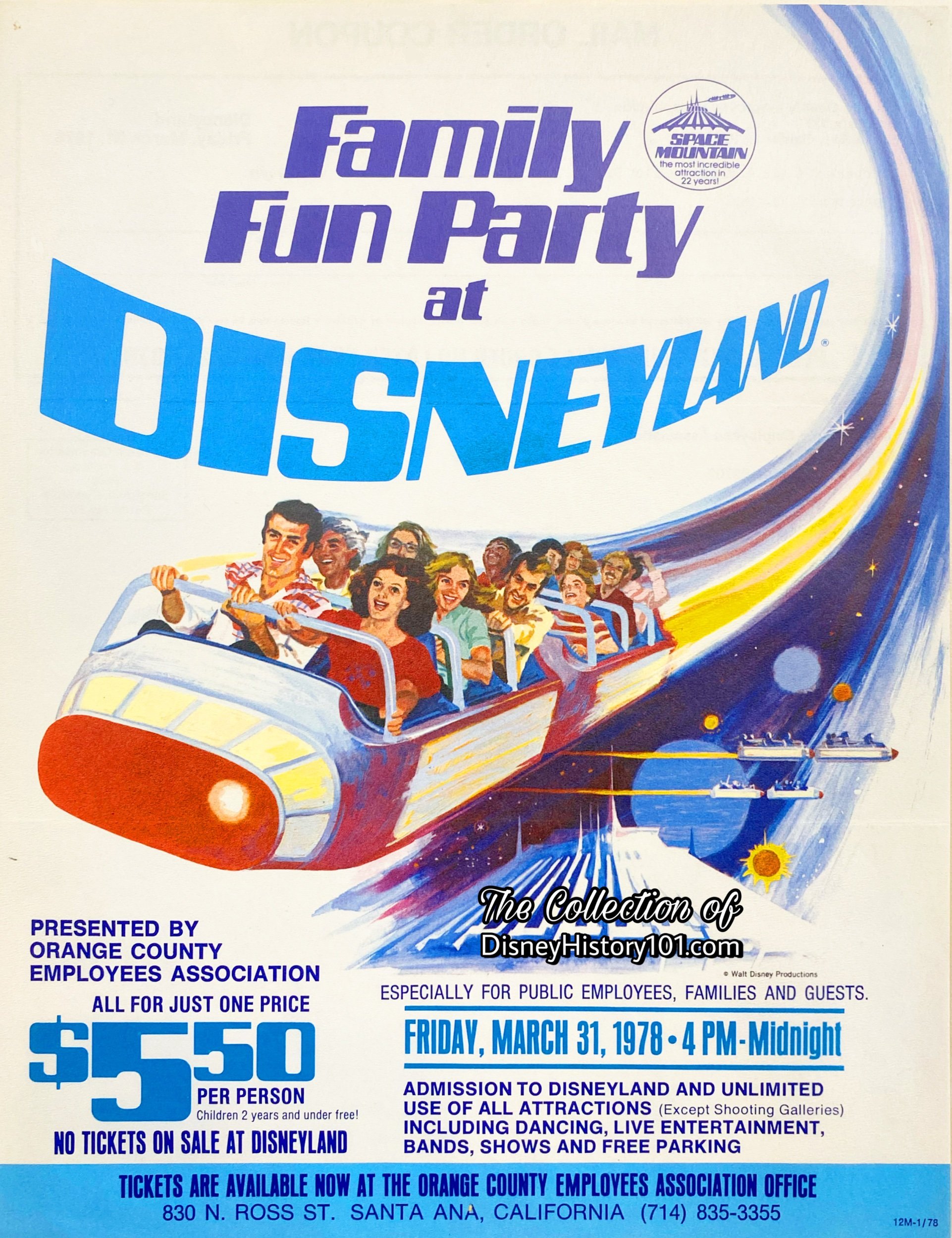
Family Fun Party at Disneyland flyer featuring Space Mountain.
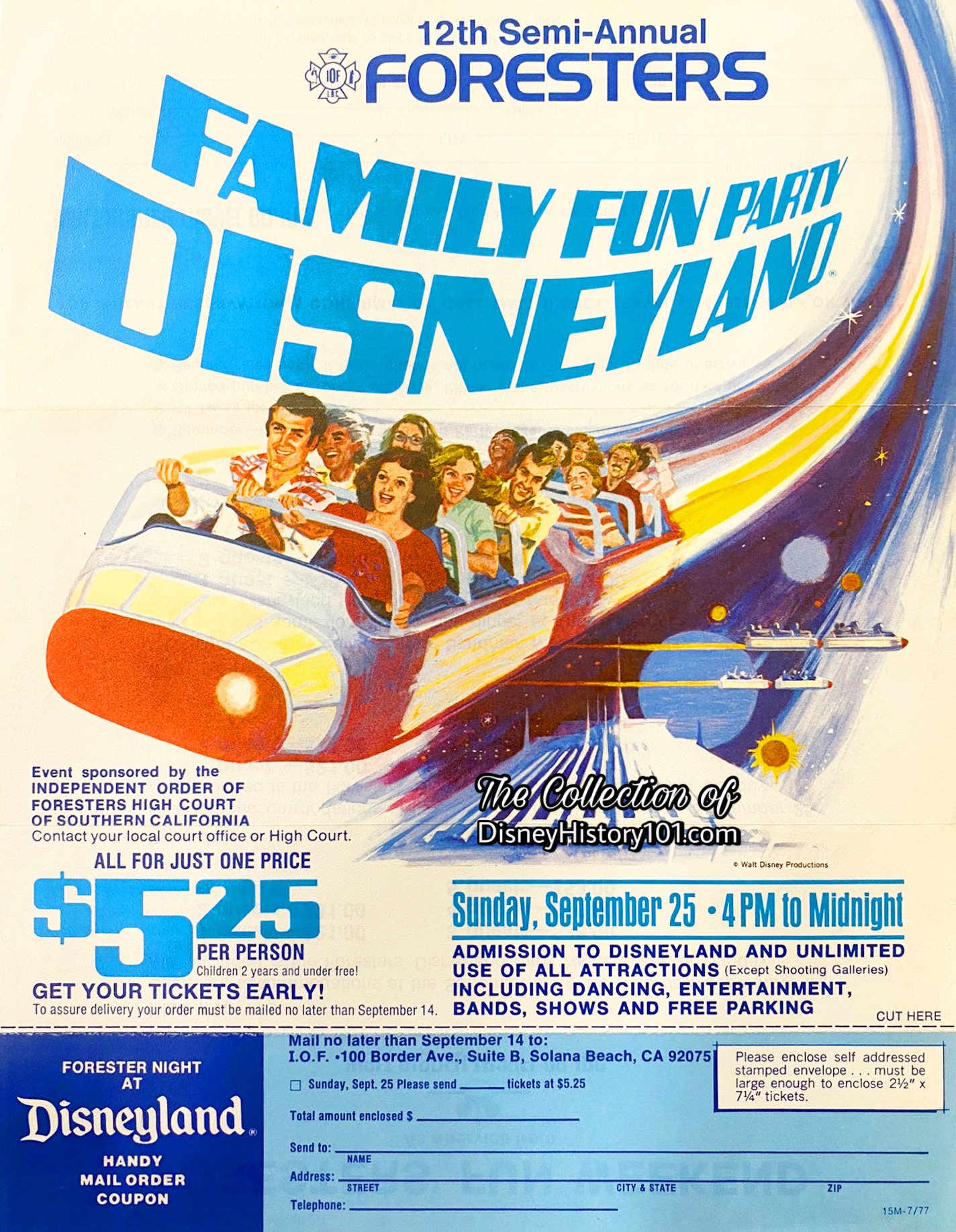
Family Fun Night at Disneyland flyer featuring Space Mountain.
Space Mountain still offered to opportunity to race through outer space to the far reaches of the universe.

A 1992 Euro Disney souvenir map featured the “attraction future.”
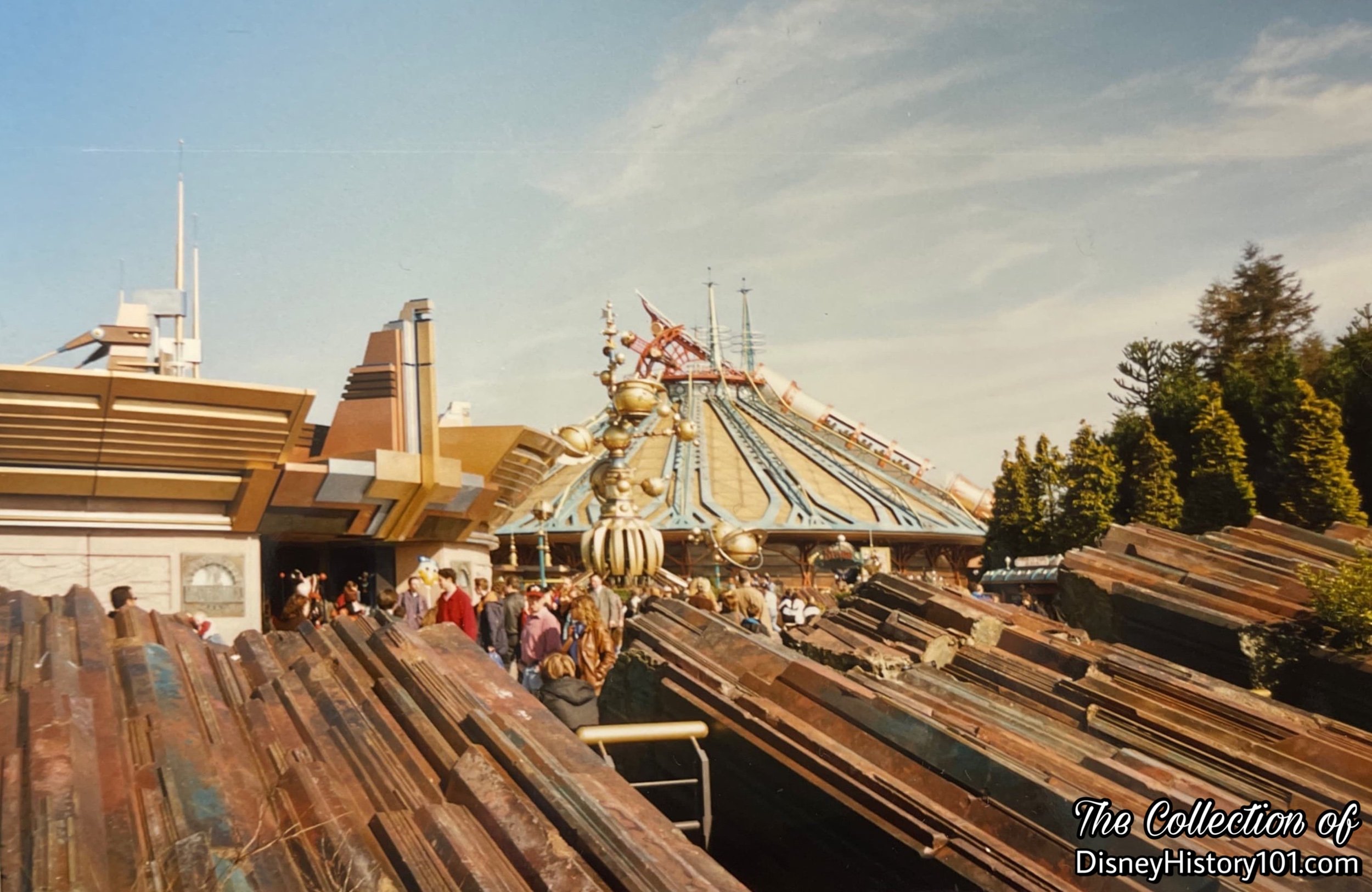
Euro Disney’s Space Mountain: Mission 2.
After Euro Disney’s Jules Verne-inspired version of Space Mountain opened (with its higher speed, first-ever loops in a Disney Park, and the first ever synced audio track to a roller coaster-type thrill ride), one of these elements would soon come to Disneyland (in Anaheim, California).

A pre-1997 Space Mountain Complex
For now, this (prior Vintage View) was the sight of Space Mountain.
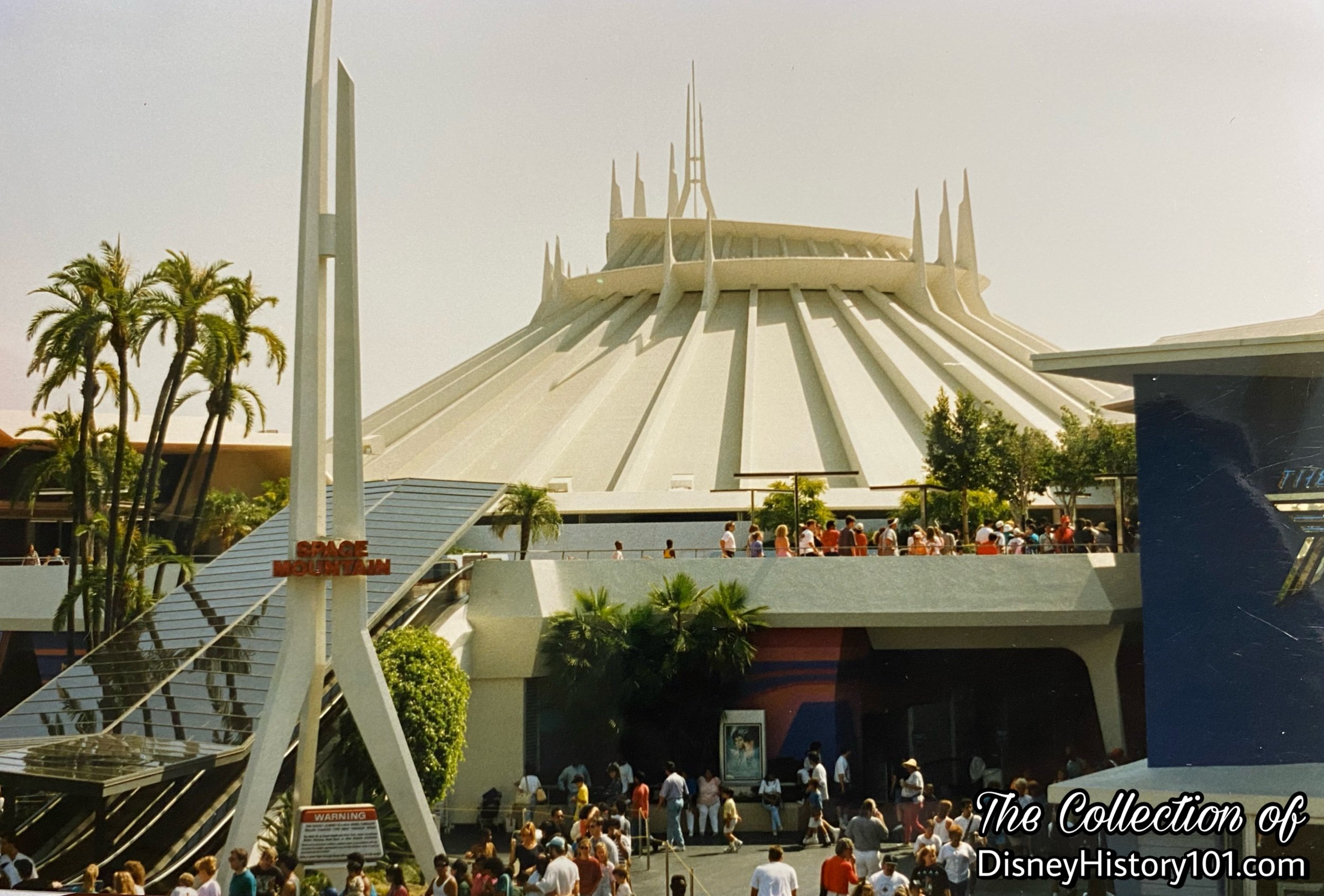

A pre-1997 Space Mountain Complex Warning Sign.
“Safety”
Safety is a major concern of the Park Operations Crew. Each day, the M-43 Machinist would make a standard opening inspection of all speed ramps in the area. M-43 would then notify M-41 of any further work to be done or parts needed prior to opening. The M-43 would go to the Space Mountain workshop, read Mechanical log book, and notify M-41 of any further work to be done or parts needed prior to opening.
During each day M-43 would, at least once, circulate to all attractions in T/L and discuss with each attraction lead any problems, defects, or any other feedback regarding the attraction. M-43 would then notify the Mechanical Dept. of anything regarding this department, and notify the M-1 of anything regarding other crafts.
Safety is also a major concern of Engineering. Every year they would make a complete test and inspection of all structural parts of Disneyland. And since Guests would look to Disneyland for their safety the department team was continuously designing new guest and personnel safety devices.
Guests also play a role in safety. This aforementioned sign served as a form of Guest Control, courteously reminding Guests (the elderly, expectant mothers, and those with under age children) to be consider any physical limitations which might be aggravated by the nature of the ride. Guests with any type of back or neck brace and children under three were not permitted to ride. Though signs were posted, the courteous Cast Member also took the responsibility to monitor for under age children and expectant mothers, directing wheelchair guests to the front of the attraction, and determining if a physical limitation might be aggravated by the nature of the ride.
Height restrictions on signs safeguarded guests long before Ride Switch, the process that allowed Guests with children who do not meet age and/or height requirements to enjoy an attraction.
“Federal Express & Pan Galactic News Network Pre Show“
In 1995, Federal Express (FedEx) became a Disneyland Participant as sponsor of Space Mountain. New “magical opportunities” were Imagineered, including improved lighting and effects. A new show entertained the guests leaving the attraction before exiting into the new Tomorrowland Light & Power Co. arcade.
But the biggest change was a brand new 15-minute out-of-this world show created by Eddie Sotto, produced by Doug Miller and Tom Fitzgerald (WED Senior Vice President of Theme Park Productions), and co-written by Seven Spiegel, that featured parody broadcasts and commercials. You may recall humorous clips from PNN (the Pan Galactic News Network), “My Favorite Earthling” (on the UFO Network), and the “Blast Off Channel” (“24 hours of lift-offs, launches and laughs), as viewed through “channel surfed” screens. [See WED Eye Openers, August 15, 1995] Of course, some of the most memorable spoofs parodied concurrent commercials of Space Mountain sponsor Federal Express.
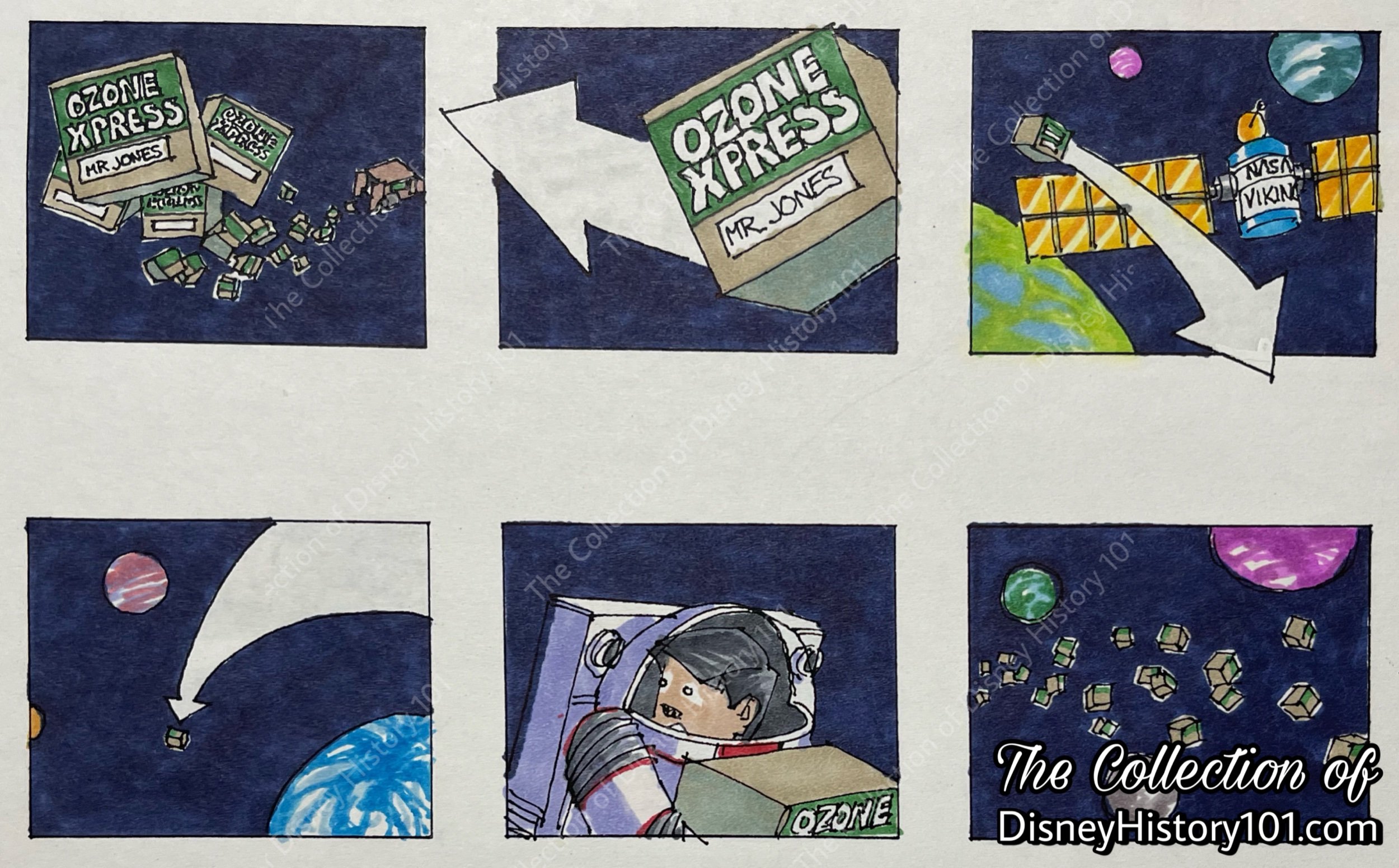
Walt Disney Imagineering Storyboard for a “Federal Express” commercial, c.1994
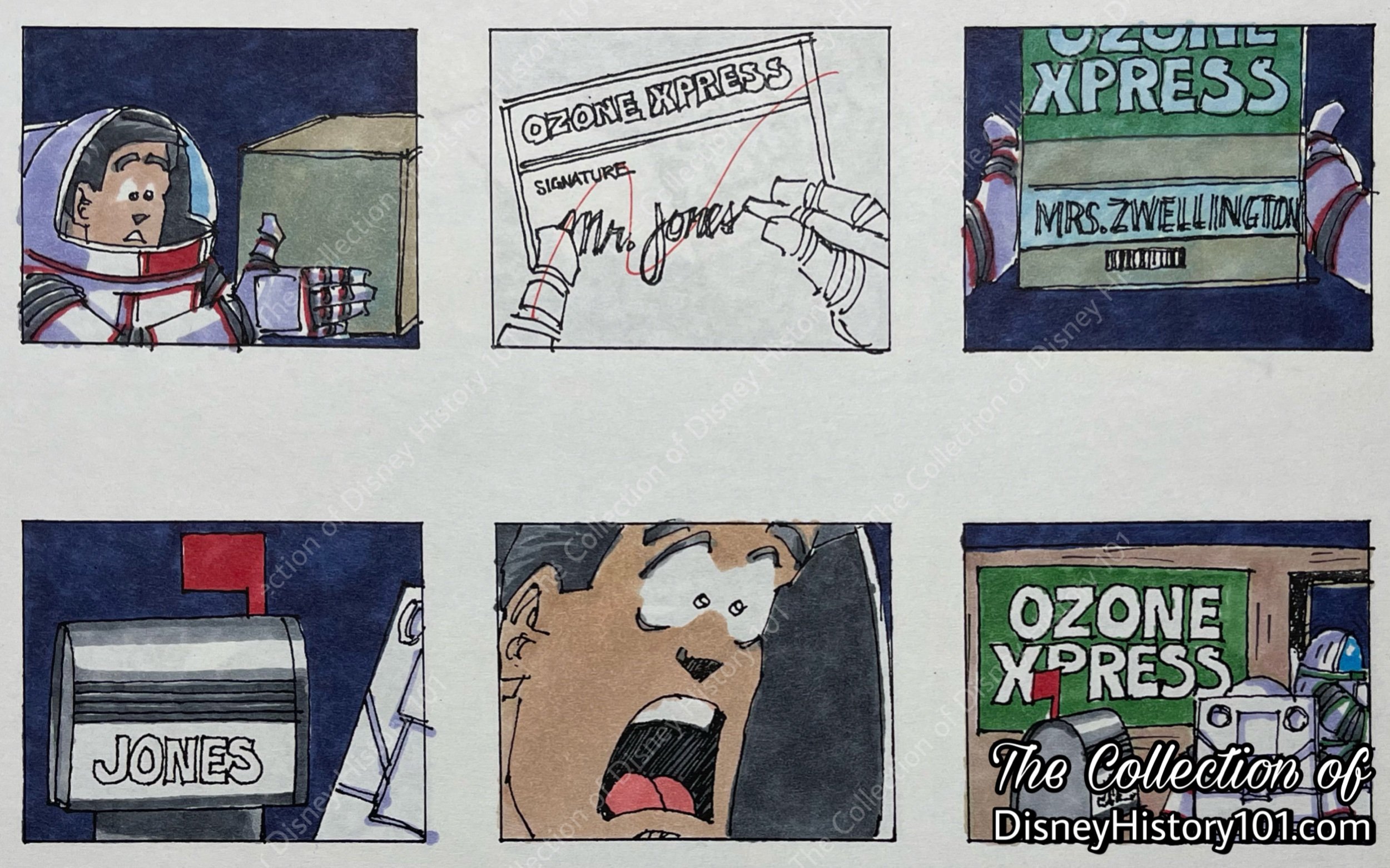
Walt Disney Imagineering Storyboard for a “Federal Express” commercial, c.1994
Here, an astronaut floats in deep space and desperately needs a package. The package is sent to the wrong address because the sender used “Ozone Express” instead of Federal Express.
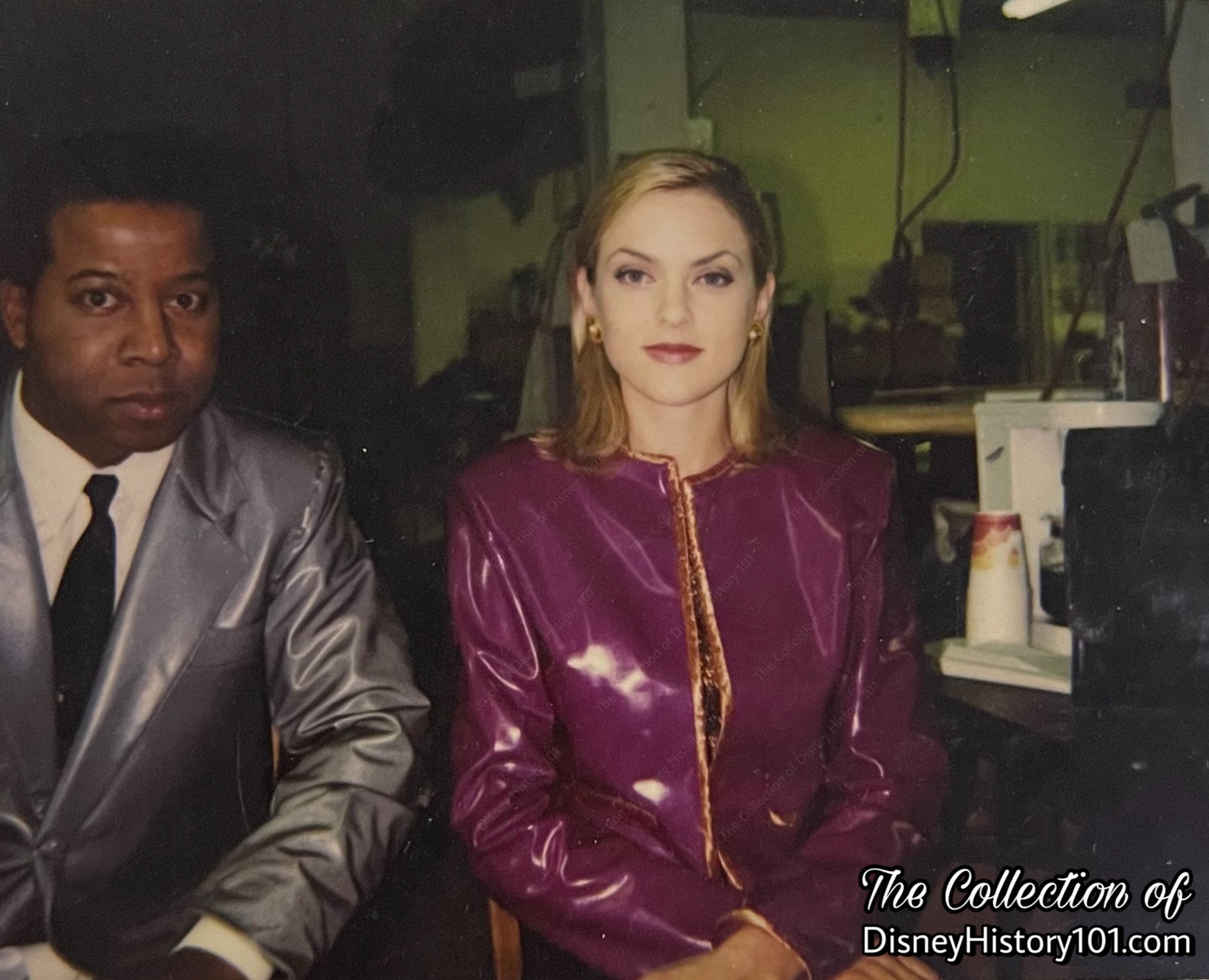
Space Mountain Pan-Galactic News Network Reporters Dirk Tachyon & Pam Pulsar, (1994)
A number of talented actors and actresses appeared contributed to the short films. Mario Lopez (of “Saved by the Bell”) was the channel-surfing host in Mission Control, comedian Charles Fleischer performed the role of used satellite salesman Crazy Larry, with Glenn Shadix as fashion designer Ray Cathode and Kelly Coffield (of “In Living Color”) was transformed into weather caster Wendy Beryllium. The preceding Vintage View preserves a Backstage moment for Michael Carrington and Elaine Hendrix (of “Get Smart”) who portray the SMTV News Broadcasters Pam Pulsar and Dirk Tachyon as News Anchors of PNN. They weren’t the only celebrities to make an appearance, as the futuristic broadcast also included a statement by President Garco (the robot featured alongside Walt Disney in the c.1954 Disneyland episode “Mars and Beyond”).
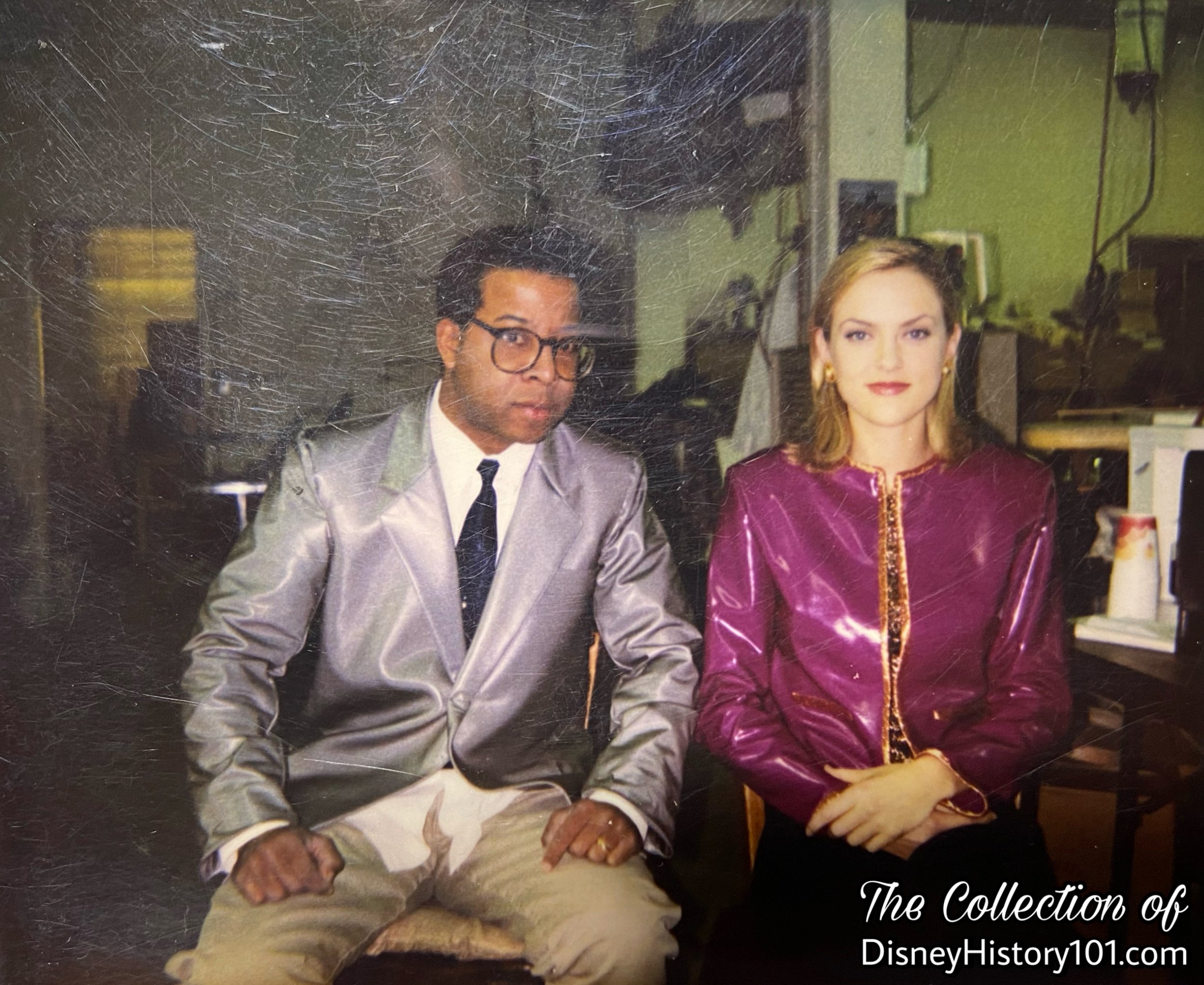
Space Mountain Pan-Galactic News Network Reporters Dirk Tachyon & Pam Pulsar, (1994)
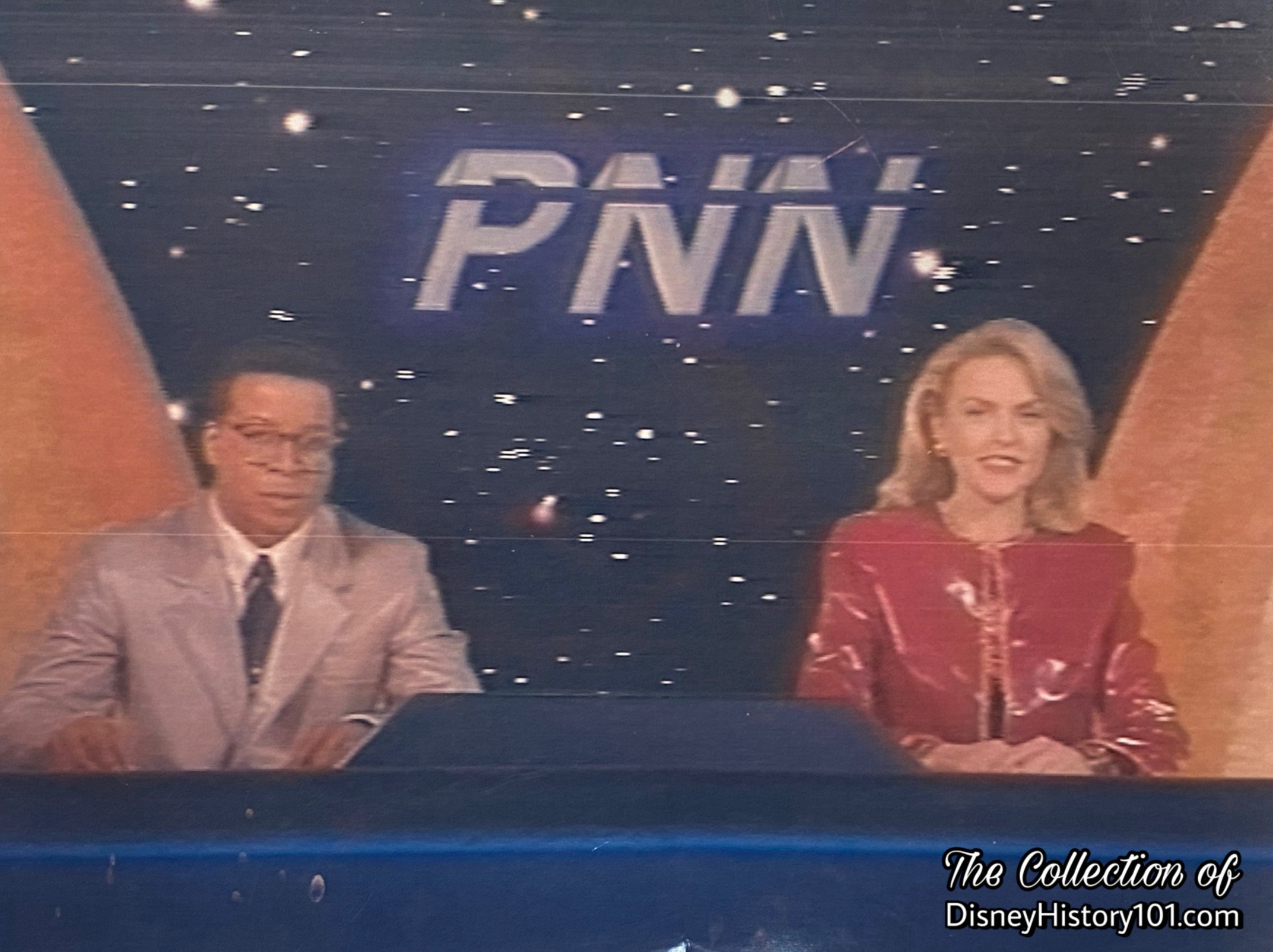
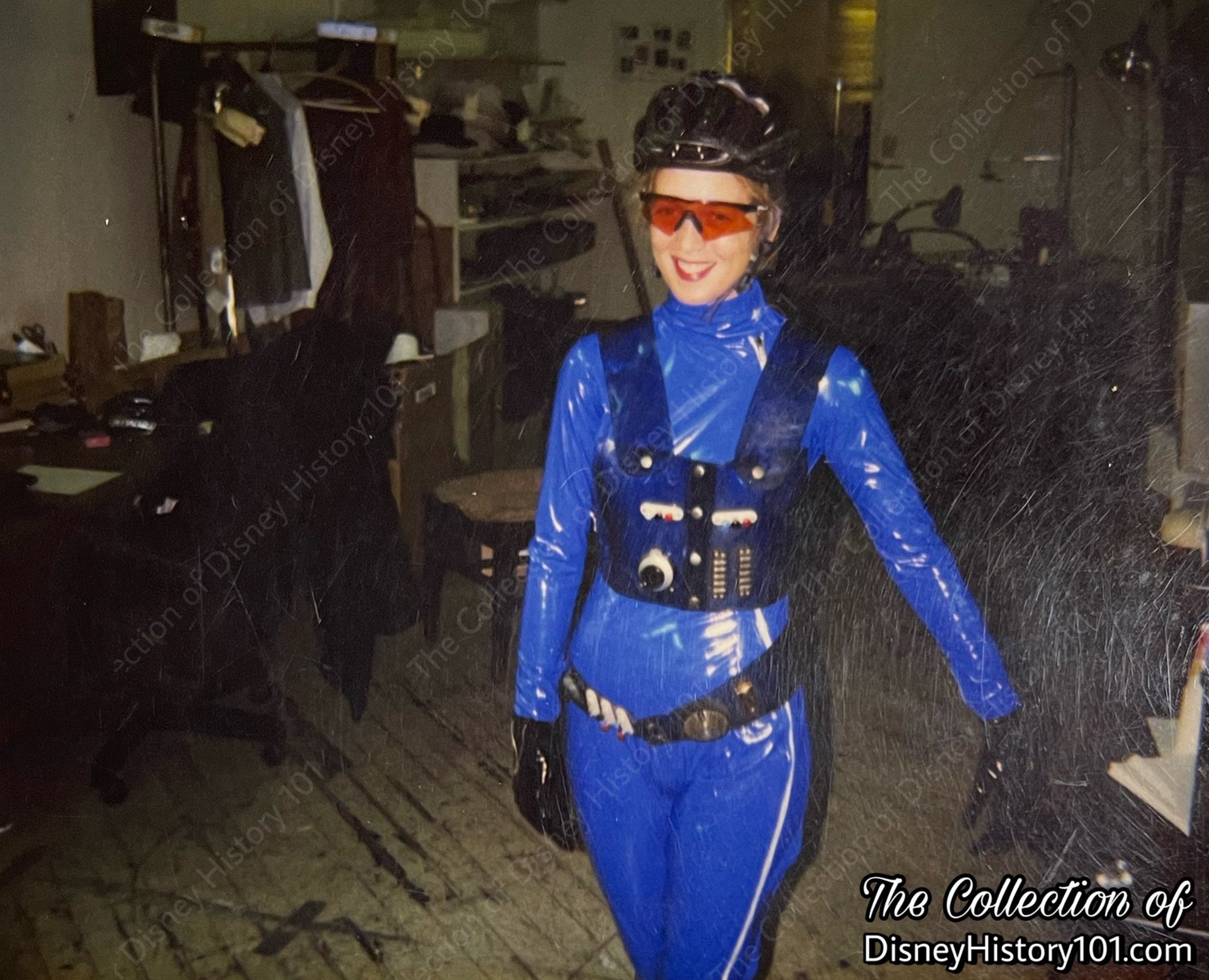
Alexandra Wentworth as Wendy Beryllium (PNN Master Meteorologist)
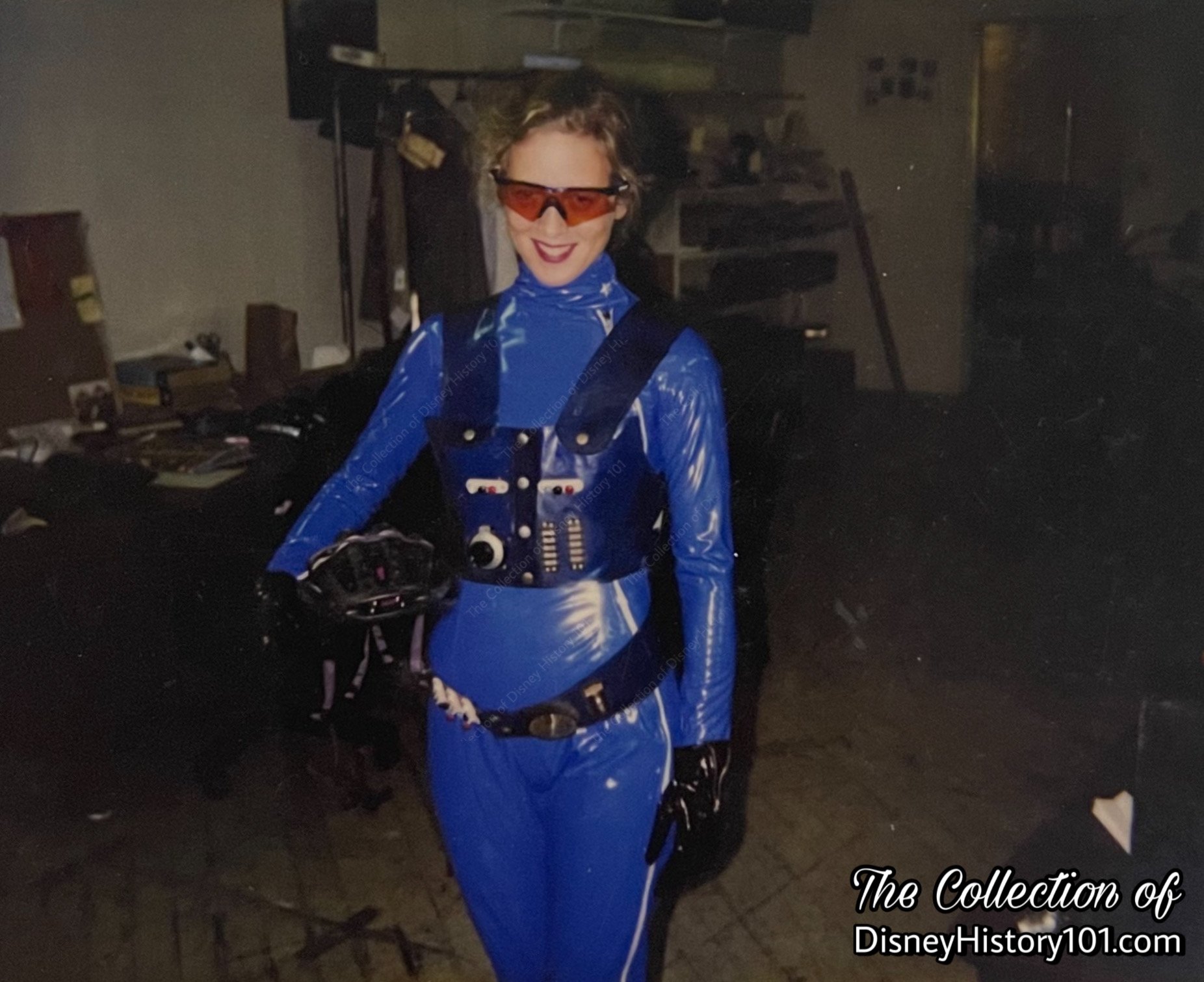
Alexandra Wentworth as Wendy Beryllium (PNN Master Meteorologist)
Costume Designer Colleen Atwood designed all the costumes for the SMTV video. This Vintage View preserves a costume fitting for actress Alexandra Wentworth (who had roles on Seinfeld and In Living Color) as Space Mountain Pan-Galactic News Network Reporter, Wendy Berrylium.
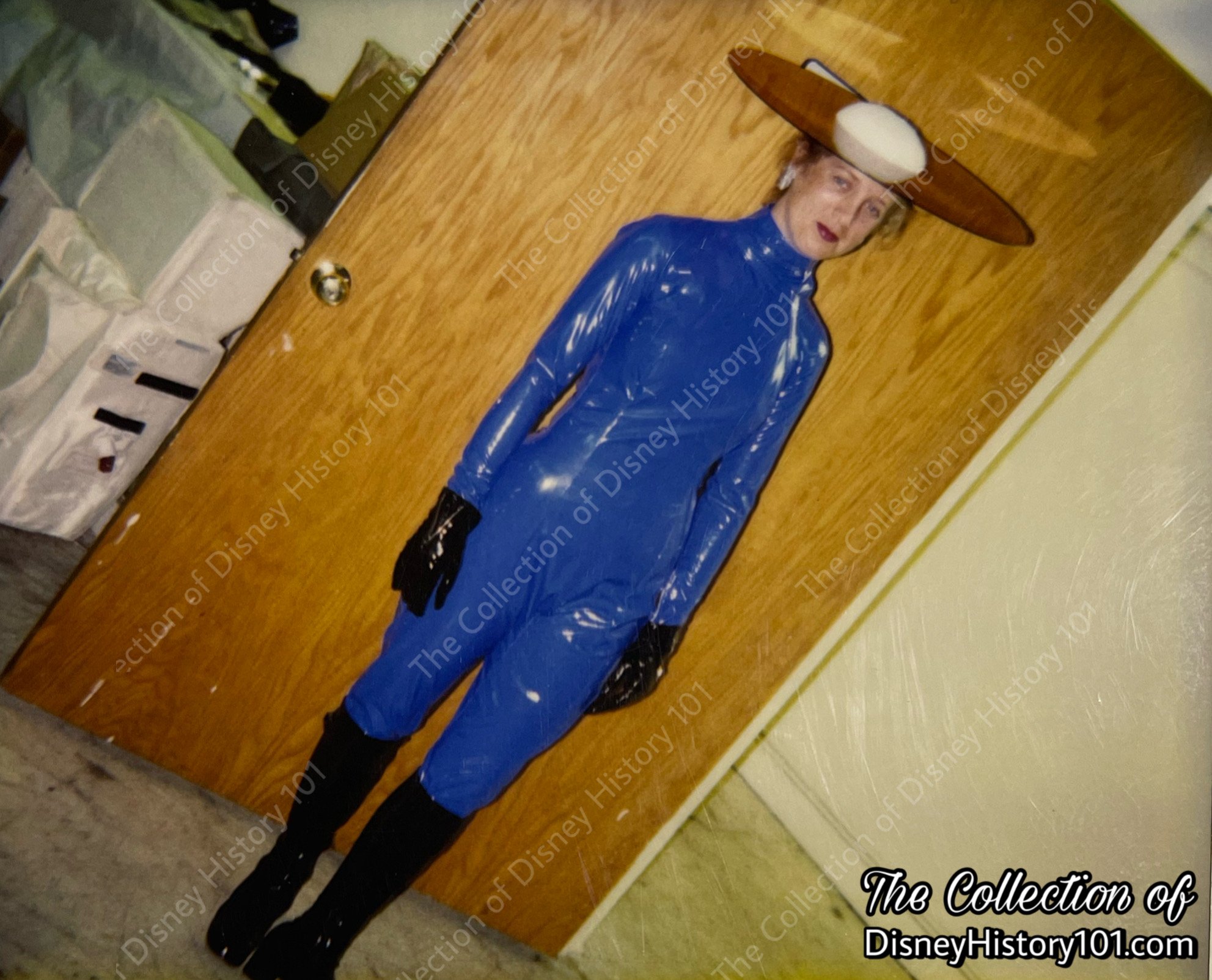
Alexandra Wentworth as Wendy Beryllium (PNN Master Meteorologist)
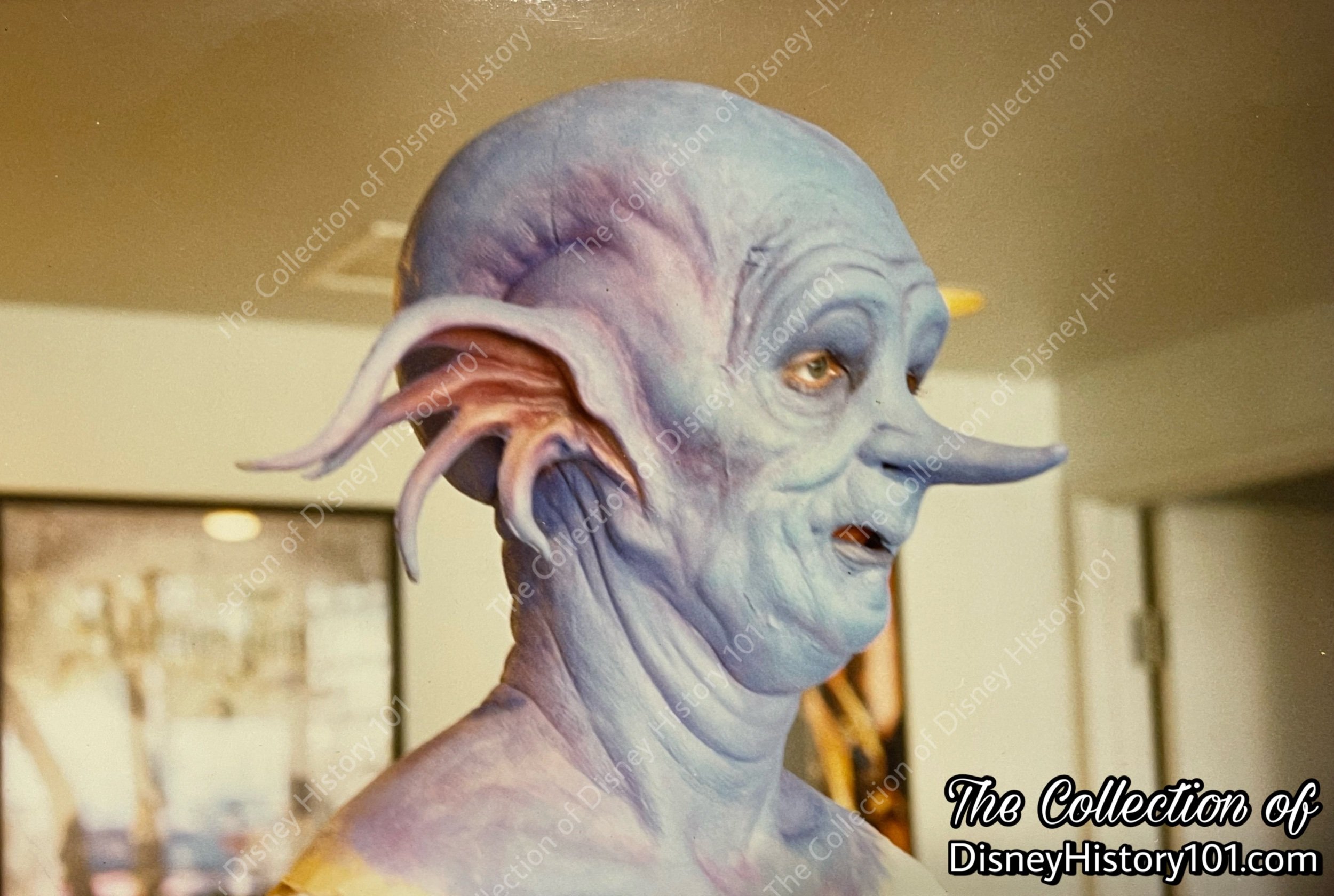
FedEx Commercial Alien
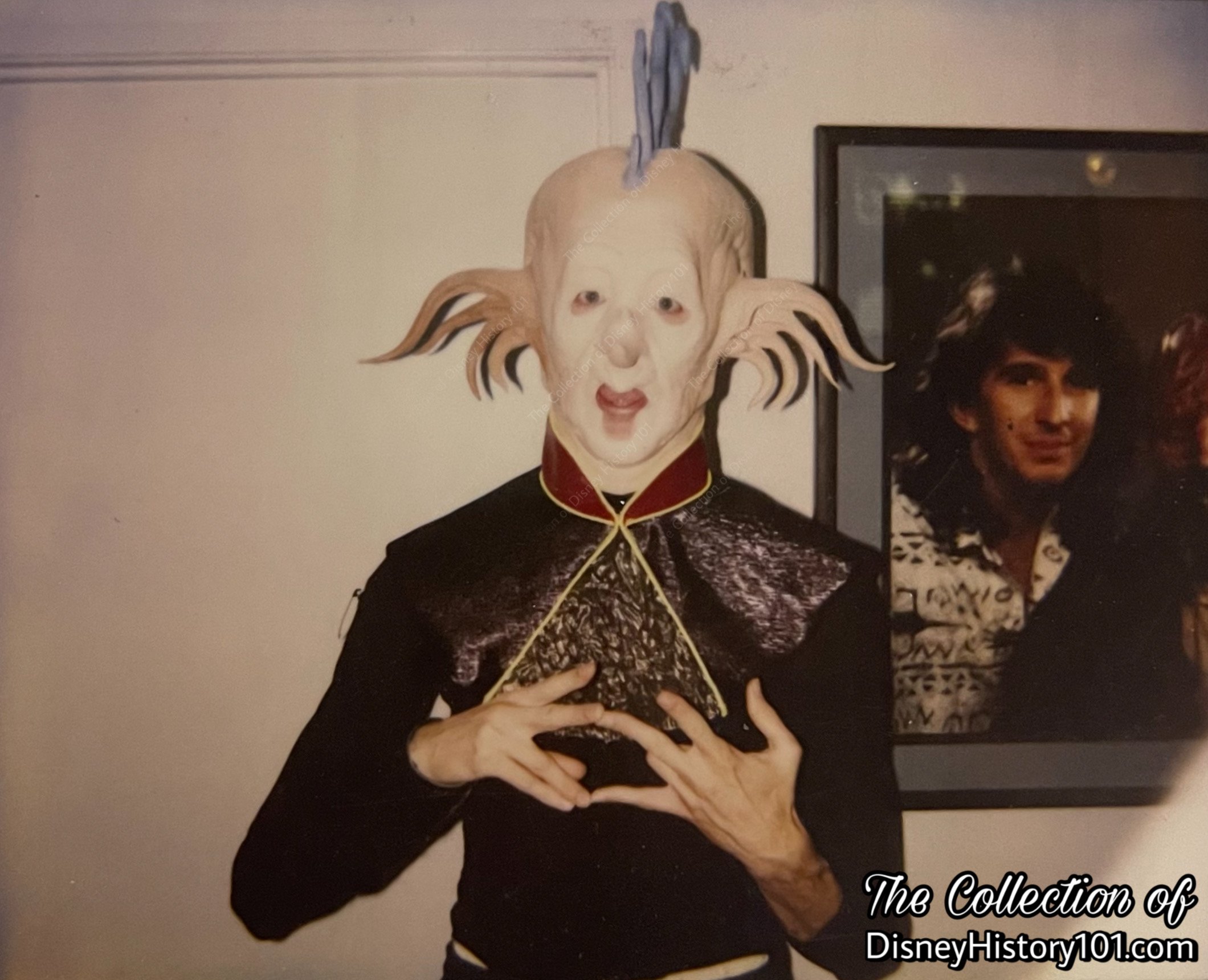
FedEx Commercial Alien
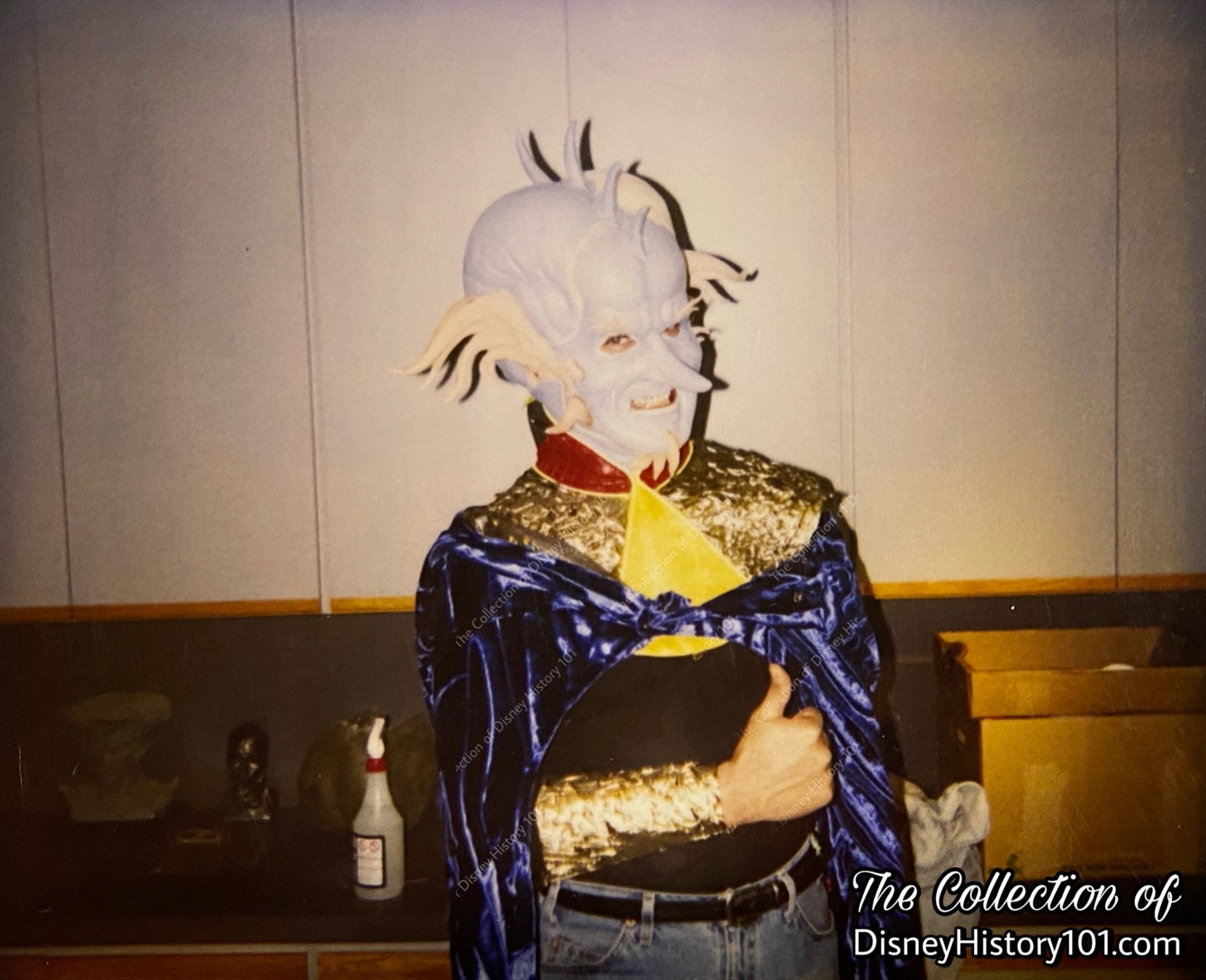
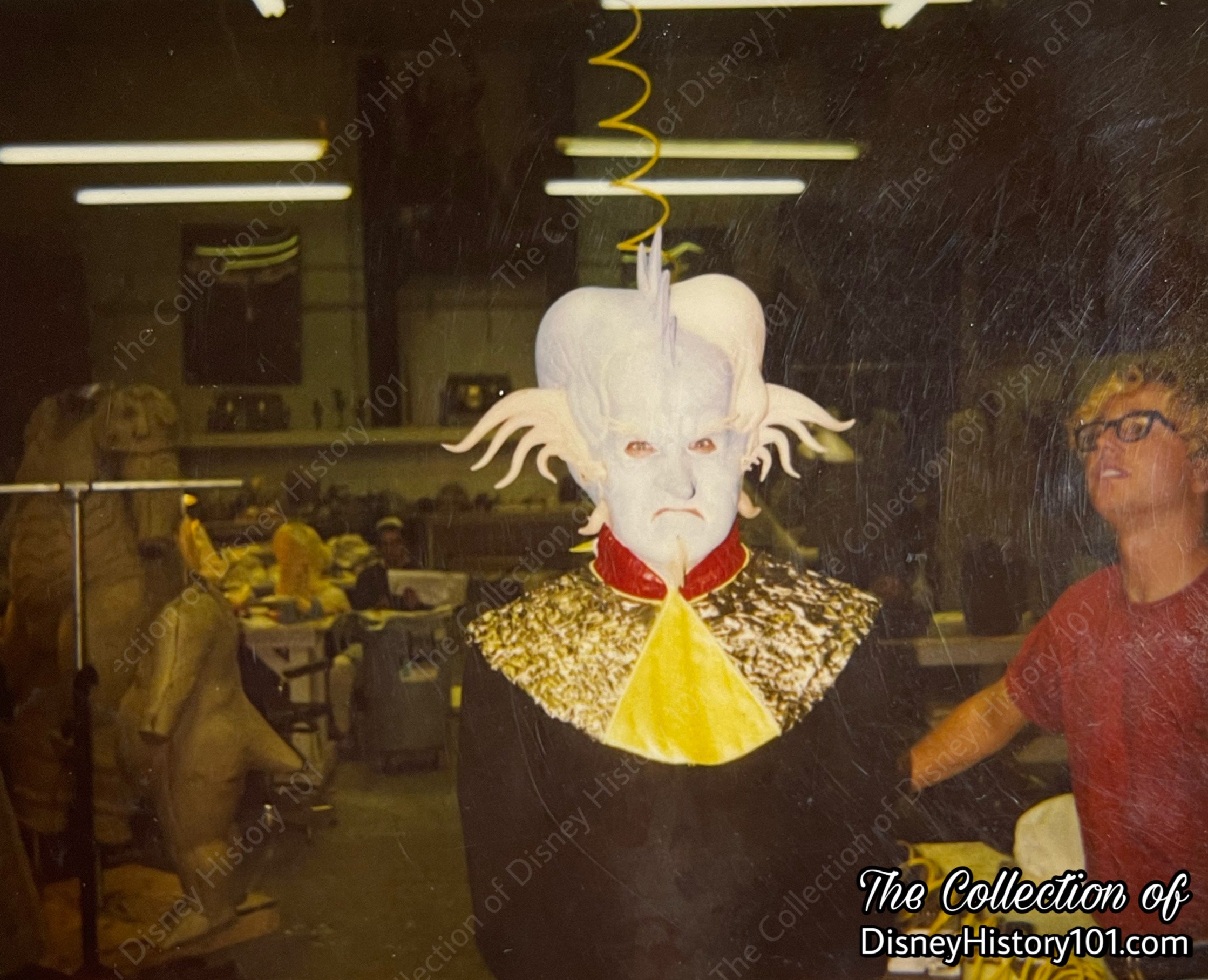
Costume designer Colleen Atwood provided the costumes for the characters like the Federation Overlord.
The “Wd Eye Openers” column (published August 15, 1995) gave a wonderful, detailed summary of production.
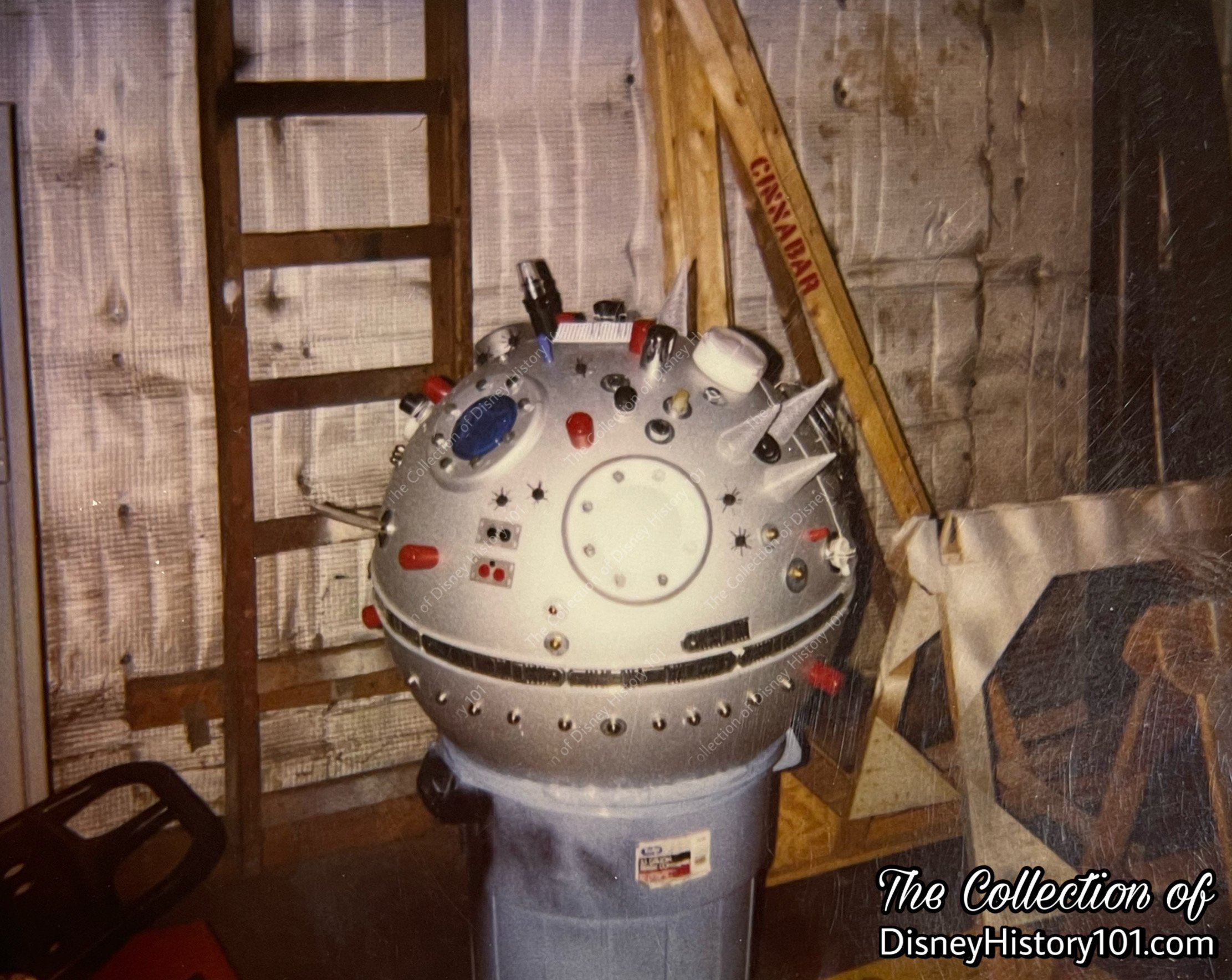
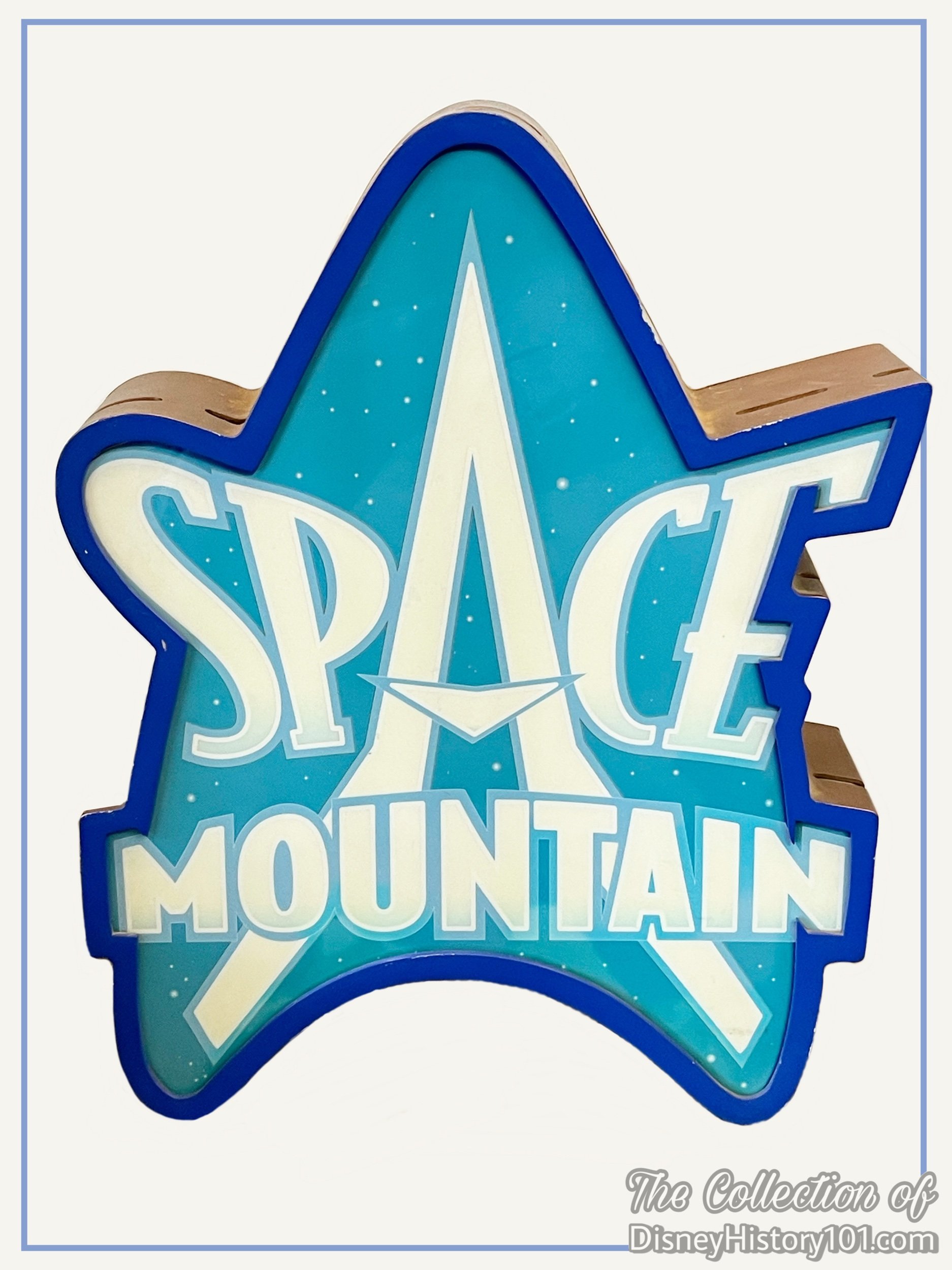
Space Mountain Fastpass Sign, c.2000s; Signage that was looking pretty worn and stressed was replaced.
Beyond these years, both 1996 and 1997 were momentous for Space Mountain at Disneyland! In 1996, Dick Dale’s surfer sound descended upon the warp-speed roller coaster ride.
The following year (1997), many aesthetic changes occurred, altering the Show Quality of the building. Notably, a third ring was added to the roof of the Space Mountain Complex, and the Speed Ramp was removed during a massive Tomorrowland overhaul.
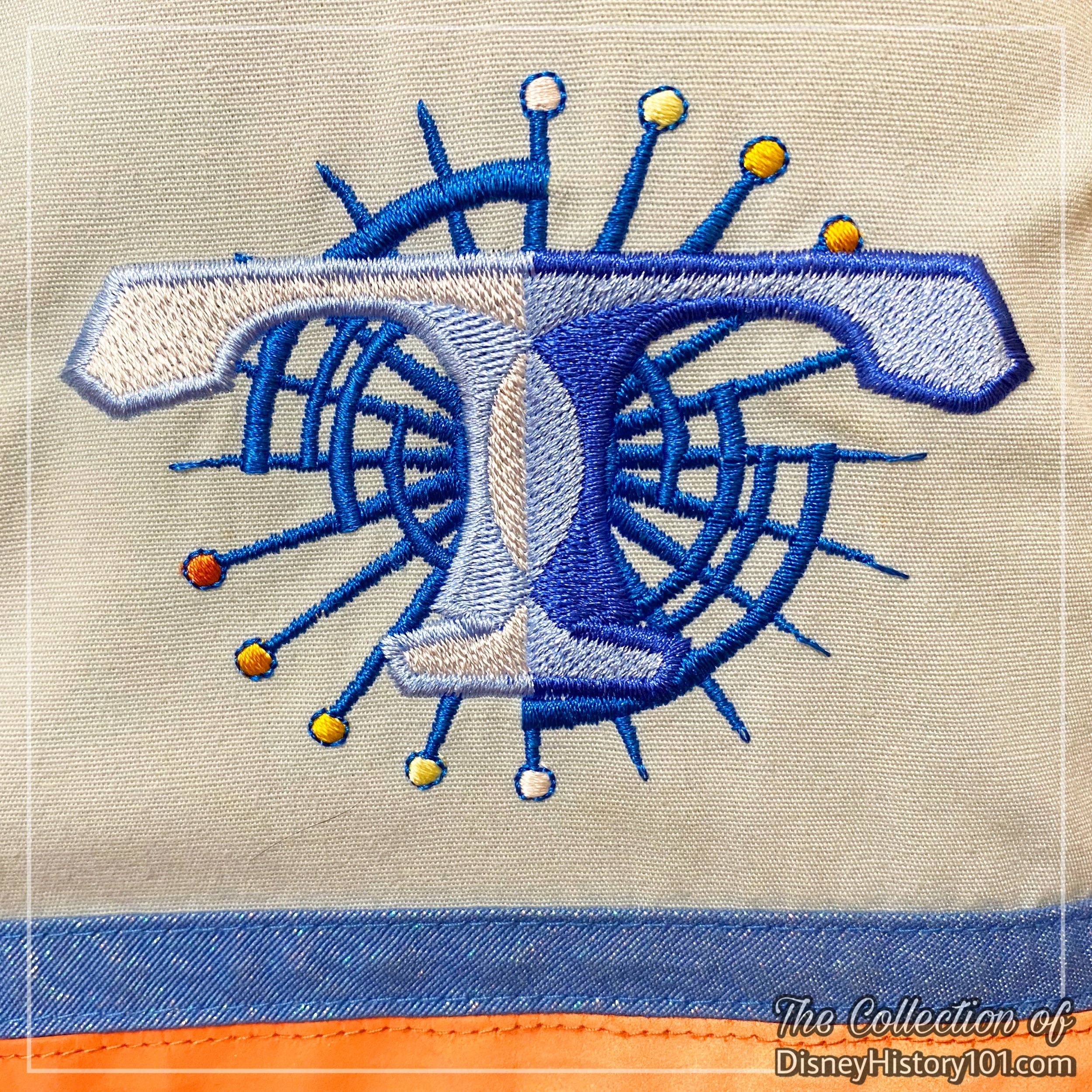
The embroidered Tomorrowland logo once worn by Space Mountain Hosts and Hostesses.
Ten years after FedEx became a Disneyland Participant (and after some renovation), Space Mountain would re-open (on July 15, 2005), with a “refurbished” brand-new track, new pre-Show scenes, an updated score (by Michael Giacchino) and a special ceremony attended by former astronaut Neil Armstrong.

A c. 1977 Space Mountain Attraction Vehicle at D23, Courtesy of Van Eaton Galleries
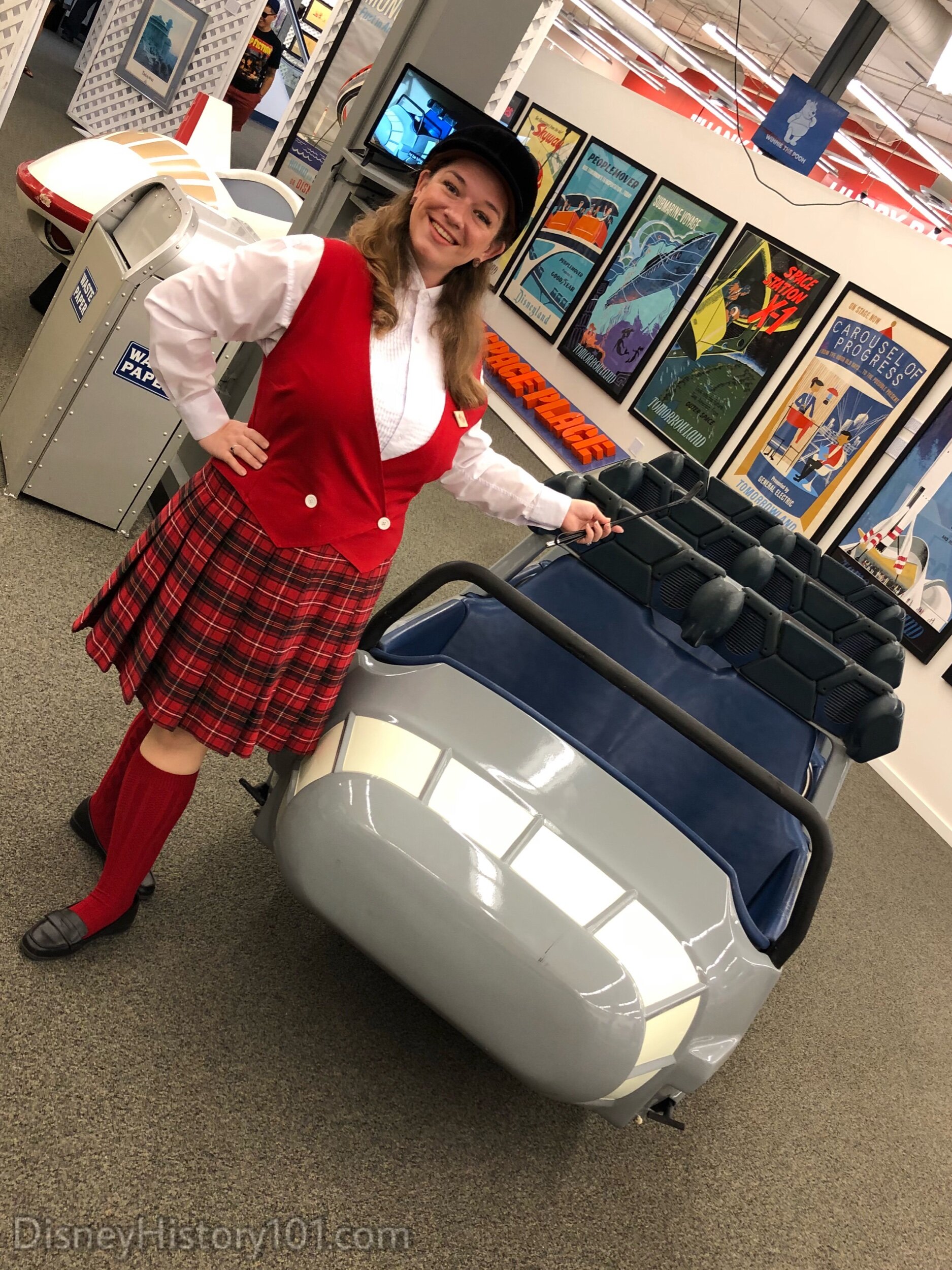
Another c. 1977 Space Mountain Attraction Vehicle, 2018
“Remove Vehicles” - In a historic (and frankly, never-to-be-repeated) auction, Van Eaton Galleries in conjunction with Richard Kraft offered the public a free show of rarely seen “Disneyana.” Among Richard Kraft’s former artifact collection at the “That’s From Disneyland” pre-auction museum show was one of the original twelve c.1977 Space Mountain Vehicles. Compared with those of the Walt Disney World Magic Kingdom, the new vehicles were streamlined and simplified, with a wider body, side-by-side seating for twelve passengers (as opposed to single-file seating for eight passengers). By 1984 a report revealed that a pair of Space Mountain tandem sleds weighed 2,300 lbs.
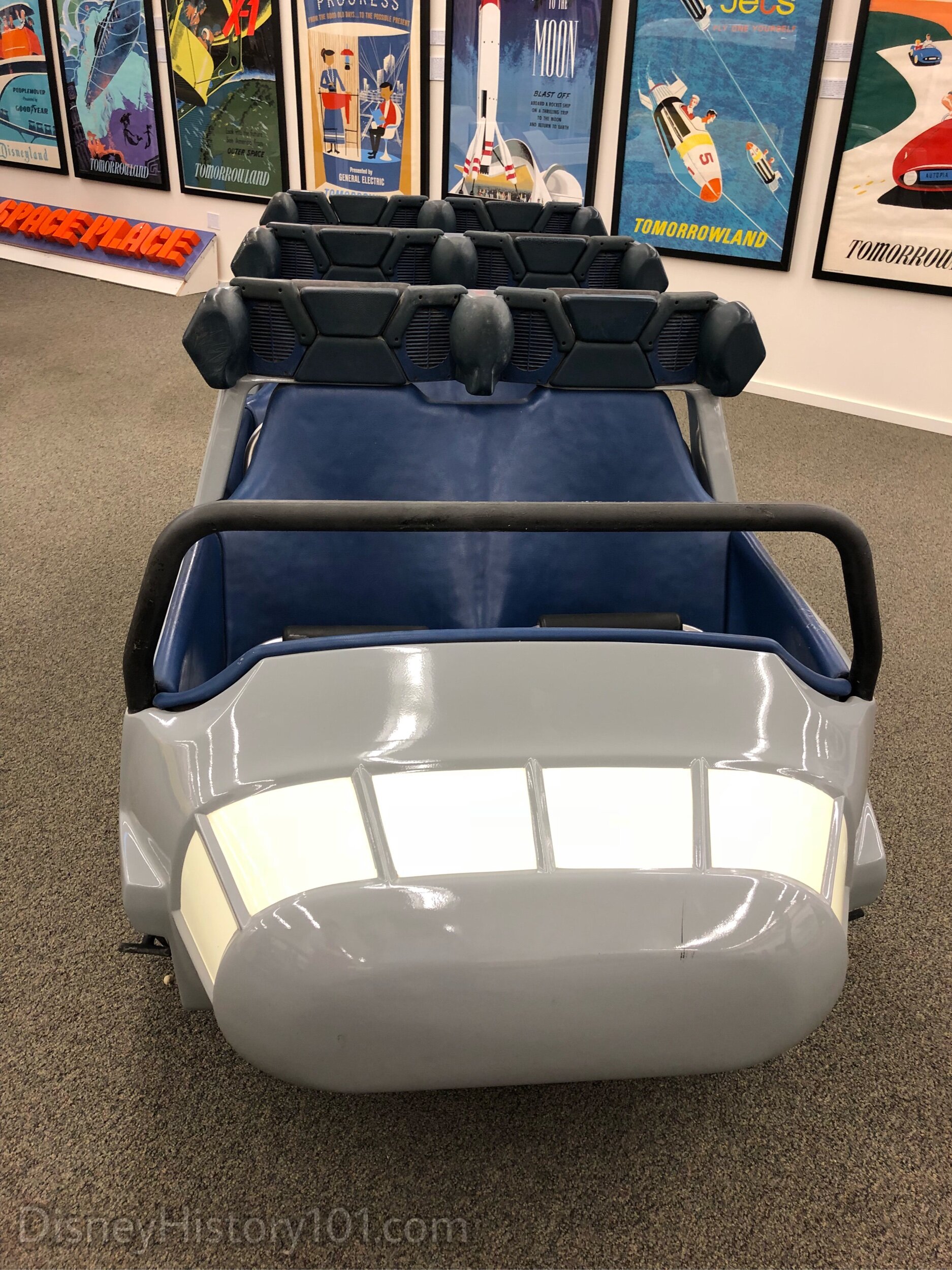
c. 1977 Space Mountain Attraction Vehicle, (2018)
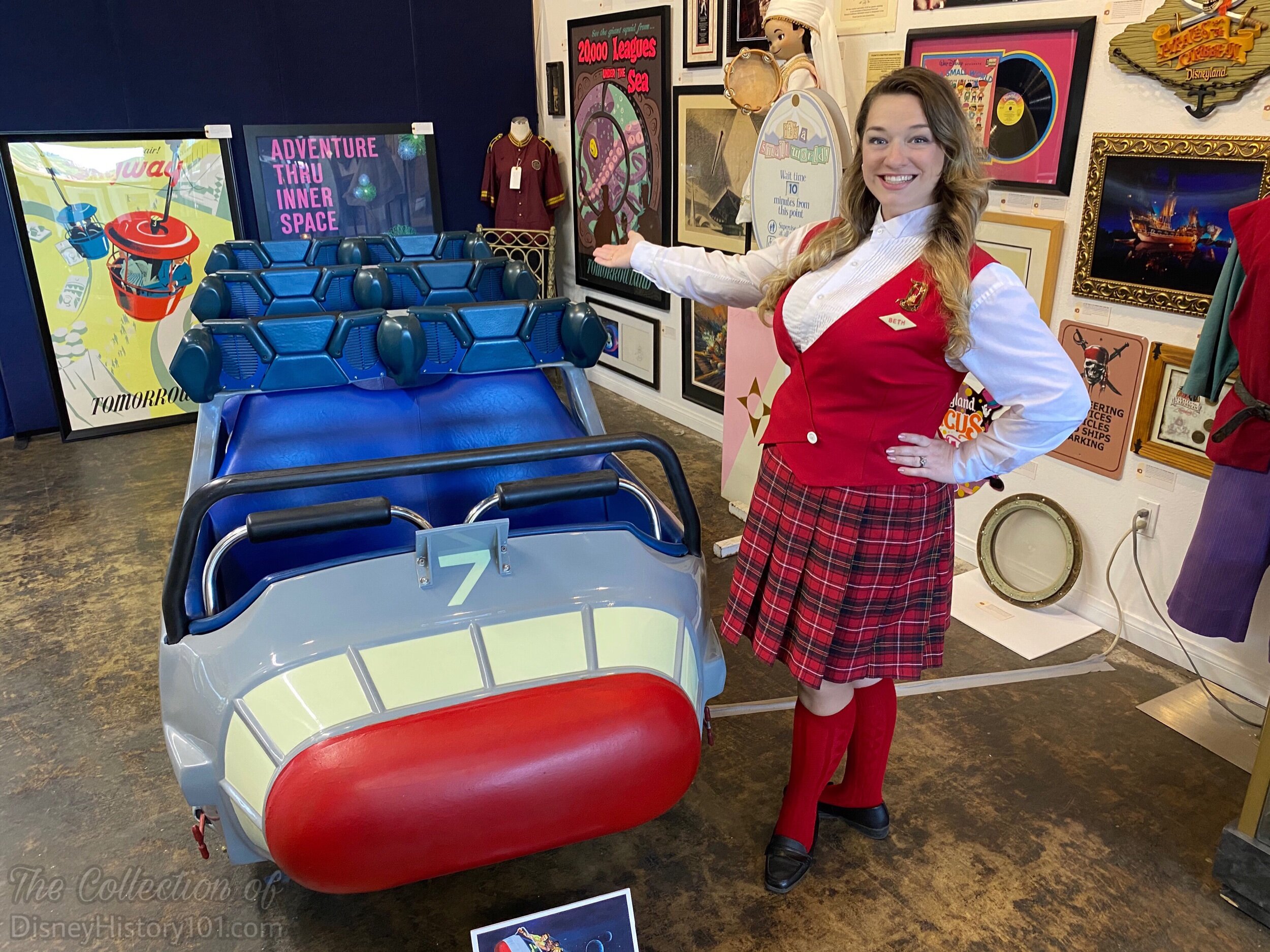
A 1970s Space Mountain Vehicle at Van Eaton Galleries, 2020.
This is yet another original Space Mountain Vehicle that once shuttled guests through the reaches of the cosmos at “hyperspeed”. During 1996, Boston Acoustic speakers were installed that would only enhance the attraction’s Show Quality experience with a new onboard soundtrack. In 2020, one of these vehicles (with speakers) was auctioned off through Van Eaton Galleries, and became the property of a proud new owner.
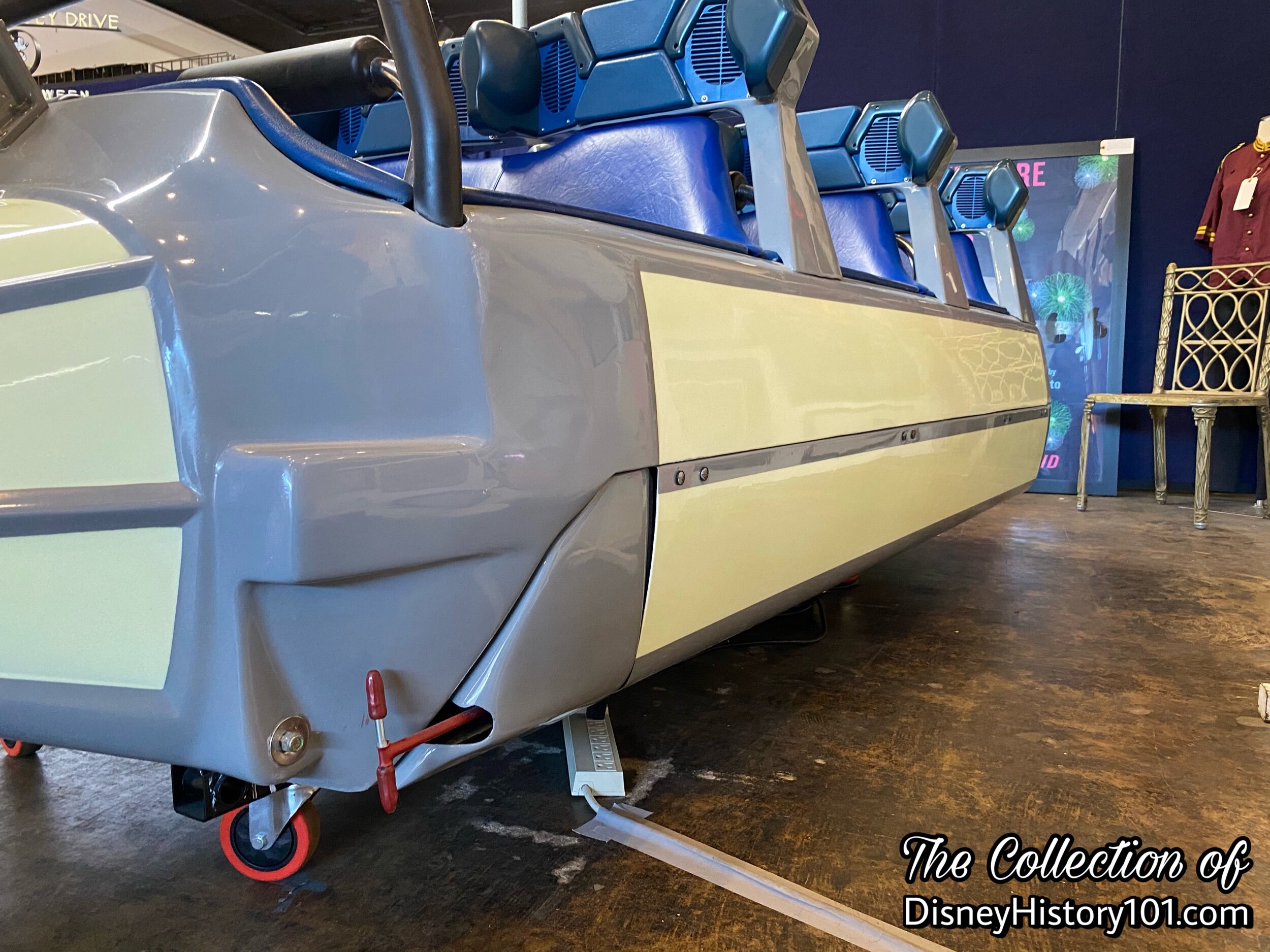
c. 1977 Space Mountain Attraction Vehicle at Van Eaton Galleries
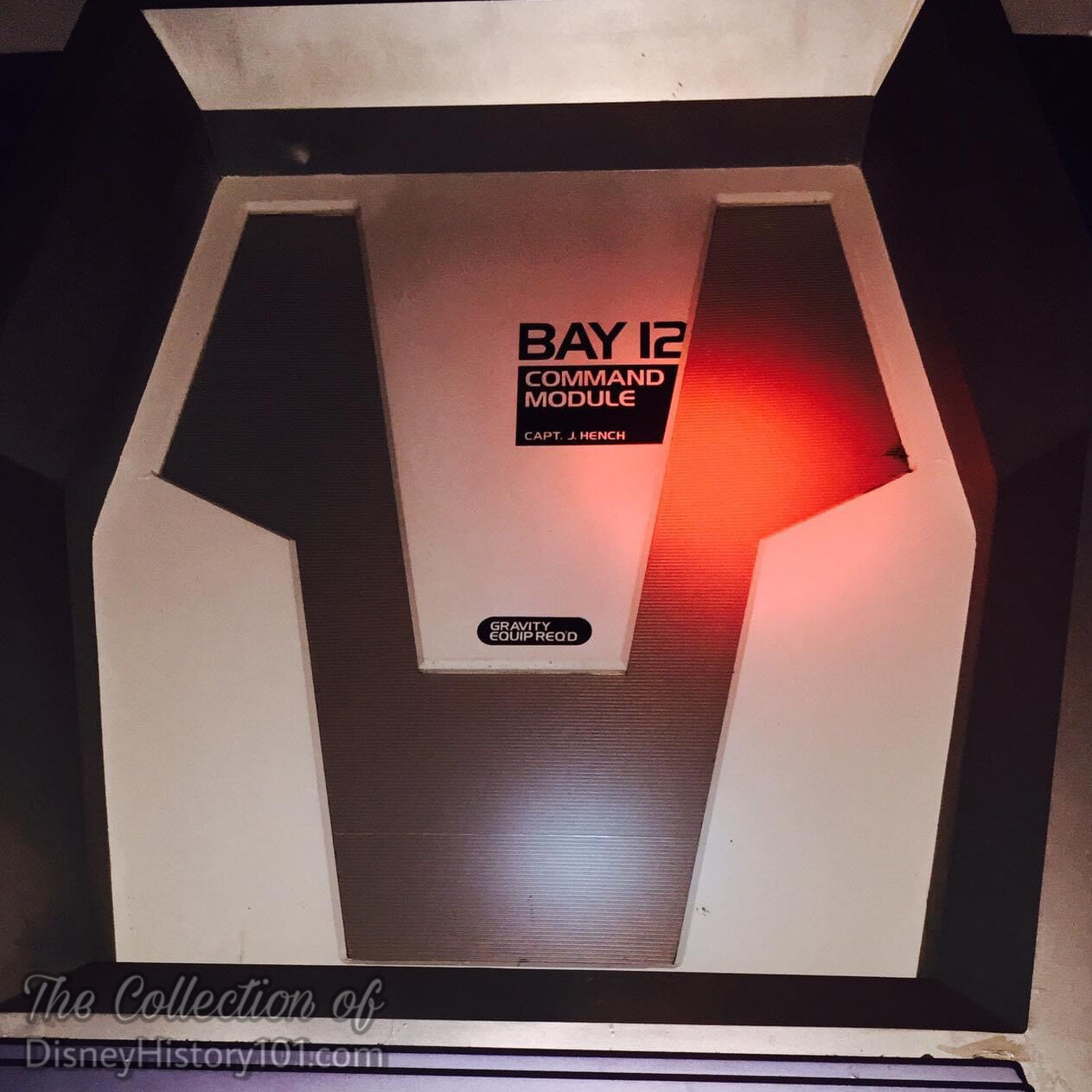
John Hench Tribute, (The Present)
Which brings us to our final “sidelight.” Inside Space Mountain (just above a Decompression Supplies Hatch, along the queue), is another hatch appropriately labelled, “Bay 12, Command Module, Captain John Hench.” This is appropriate, as John Hench (the longest-termed Disneyland employee, at 64 years with the company) first created concepts for Tomorrowland, and then assisted in re-designs of Tomorrowland (in 1967 and 1998). Two years after Space Mountain opened, John assumed the title of WED Enterprises Senior Vice President on September 17, 1979. John helped develop many shows and attractions for Disneyland, and was “instrumental in master-planning every Disney park world-wide, actively involving himself in show concepts, architecture, costumes, graphics and every other aspect of design.” But most important were his contributions toward the towering Space Mountain!
Marty remembered Hench as a “mentor”: “John Hench was the most articulate and well-read person that ive ever worked with and he encouraged me in so many ways.” It is of note to the credit of John’s humble character: “John Hench, an original Imagineer with WED, told Marty [Sklar], ‘When we get finished with a project, you or none of us can say, ‘I did that, I did this, because we all did it, so many hands touched it, changed it and made it better, that it's a we, it's never an I.’”
By 2003, the Space Mountain had a legacy in Tomorrowland at Honk Kong Disneyland. A prospectus describes: “A warp-speed adventure to the far reaches of the universe and back. Guests board 12-passenger ‘rockets’ that streak at white-knuckle speeds through a meteor shower. Each vehicle has an on-board sound system that synchronizes music and sound effects with the racing rocket.” The complex would also have a concourse, “a futuristic garden area between Space Mountain and Buzz Lightyear Astro Blasters that serves as a rest spot for weary intergalactic travelers in Tomorrowland. Shade trees, benches and unique water elements enhance the park-like environs.”
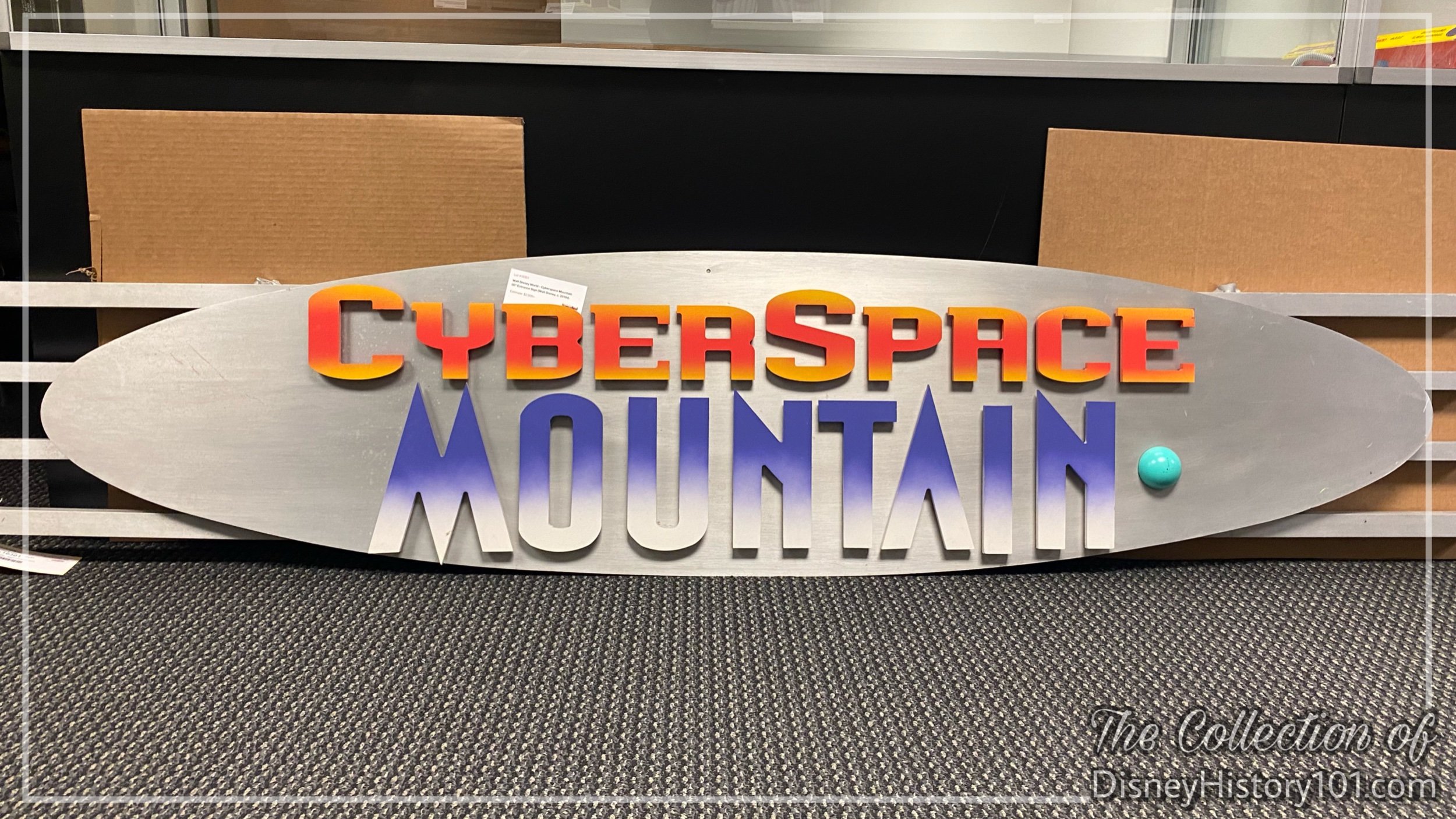
Then there was CyberSpace Mountain at DisneyQuest in Downtown Disney, allowing Guests to design their very own rollercoaster.
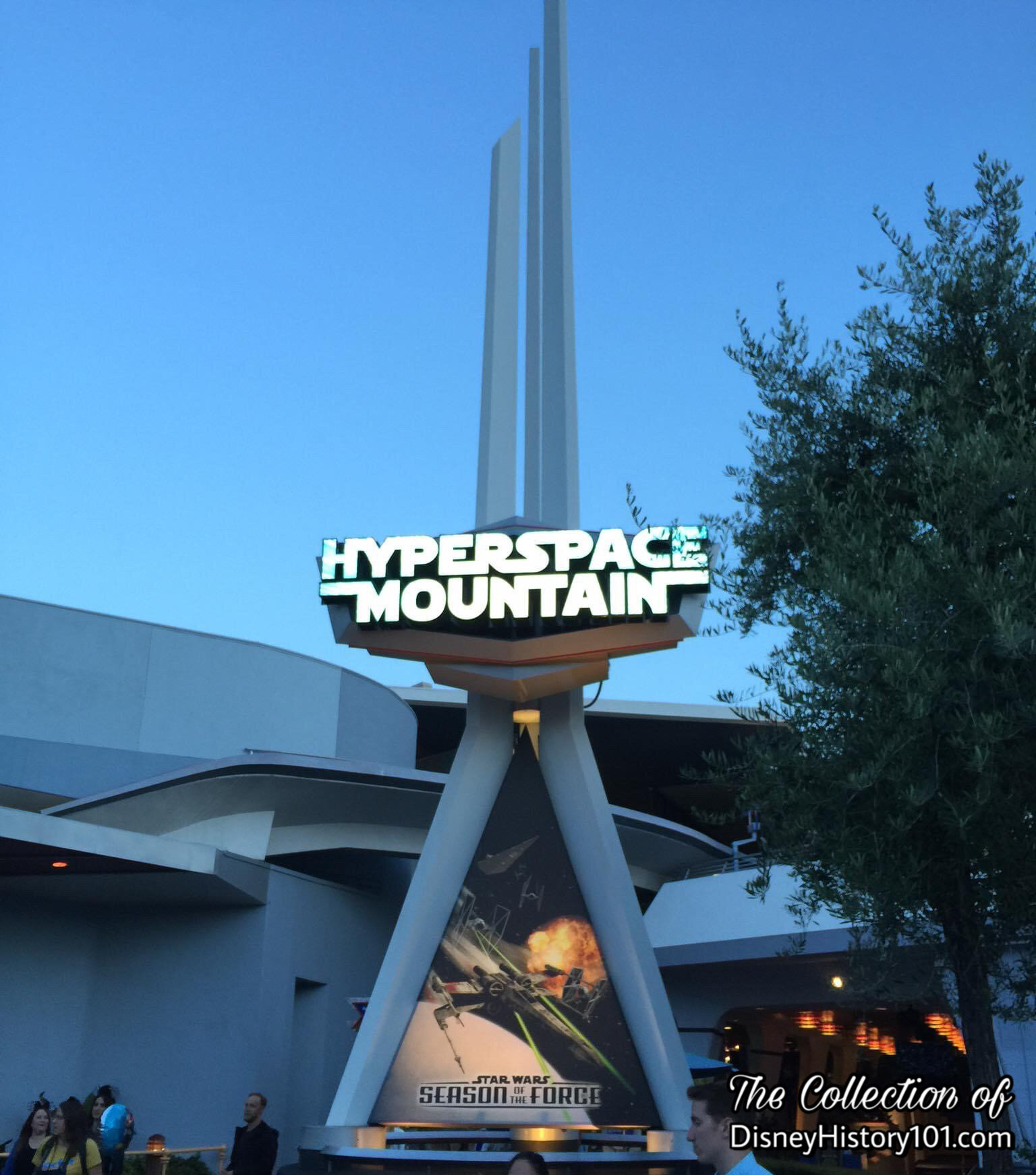
Hyperspace Mountain Marquee at twilight, 2016.
Since the beginning, the Four Keys of the DISNEYLAND Show (operating priorities in presenting the DISNEYLAND Show) have been present - Courtesy, Safety, Show, and Efficiency. Guided by these Four Keys, are Walt Disney Imagineers, who are always seeking out new magical opportunities to increase the efficiency, safety, and show quality of Disneyland adventures. This being the case, Walt Disney Imagineers are constantly seeking to improve upon the show of Tomorrowland and one of its most popular attractions - Space Mountain! During the 1990s, Tim Delaney (of Walt Disney Imagineering Creative Development) created concepts of a Star Wars inspired Death Star overlay for Space Mountain. In 2008, WDI master plans entertained the concept of an update to the Space Mountain Show Building, Forecourt and “HISTA” involving some sort of Global 3-D technology.
On July 15, 2005, Space Mountain was relaunched with a new generation of special effects, state-of-the-art show elements, new rocket vehicles, and an upgraded sound system, featuring an all-new audio track. The opening ceremony took place at 10AM and the attraction was open to guests at 11 AM.
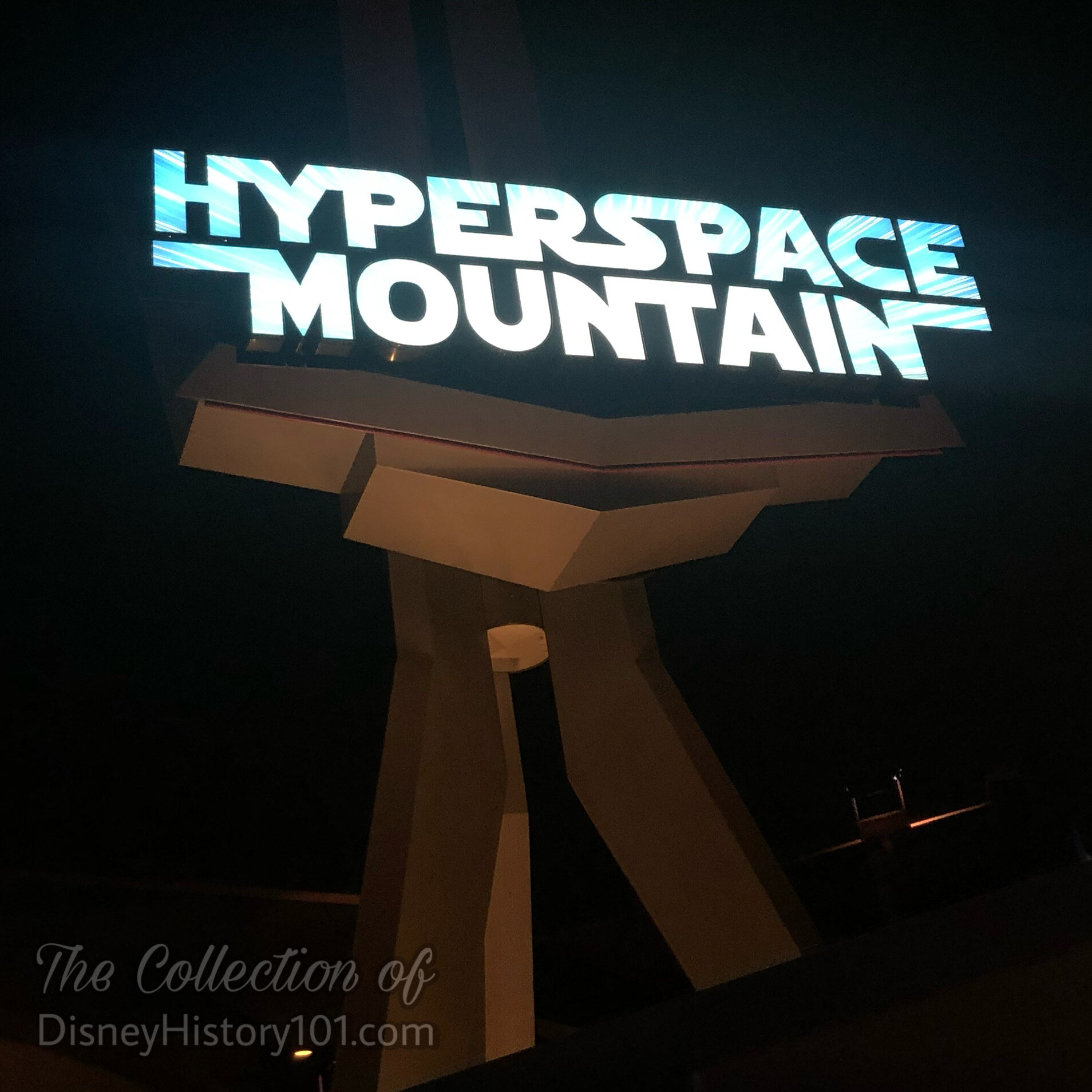
Hyperspace Mountain Marquee at night, 2016.
There have been many “Overlays” to Space Mountain over the years, like borrowing “Ghost Galaxy” from Hong Kong. A few years later, the Space Mountain Show was temporarily changed for the spring of 2016, when a new Star Wars inspired adventure started a tradition of temporary seasonal ride refurbishments! After being launched into hyperspace, shuttles jump right out of hyperspace travel, and into battle with several tie fighters and a star destroyer in Hyperspace Mountain! In 2017, Hong Kong Disneyland carried the Hyperspace Mountain tradition, as Guests dodge blaster fire and dash through a raging dogfight between Rebel X-wing Starfighters and Imperial TIE fighters.
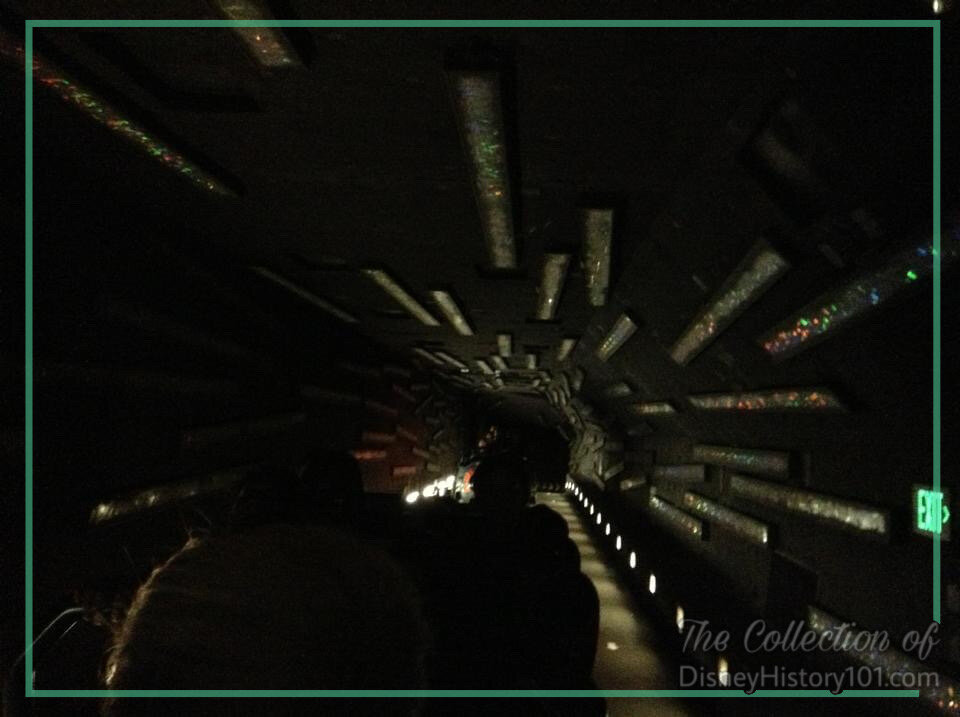
Some things seem to never change - some of our favorite climactic Show Effects are achieved through these reflective surfaces.
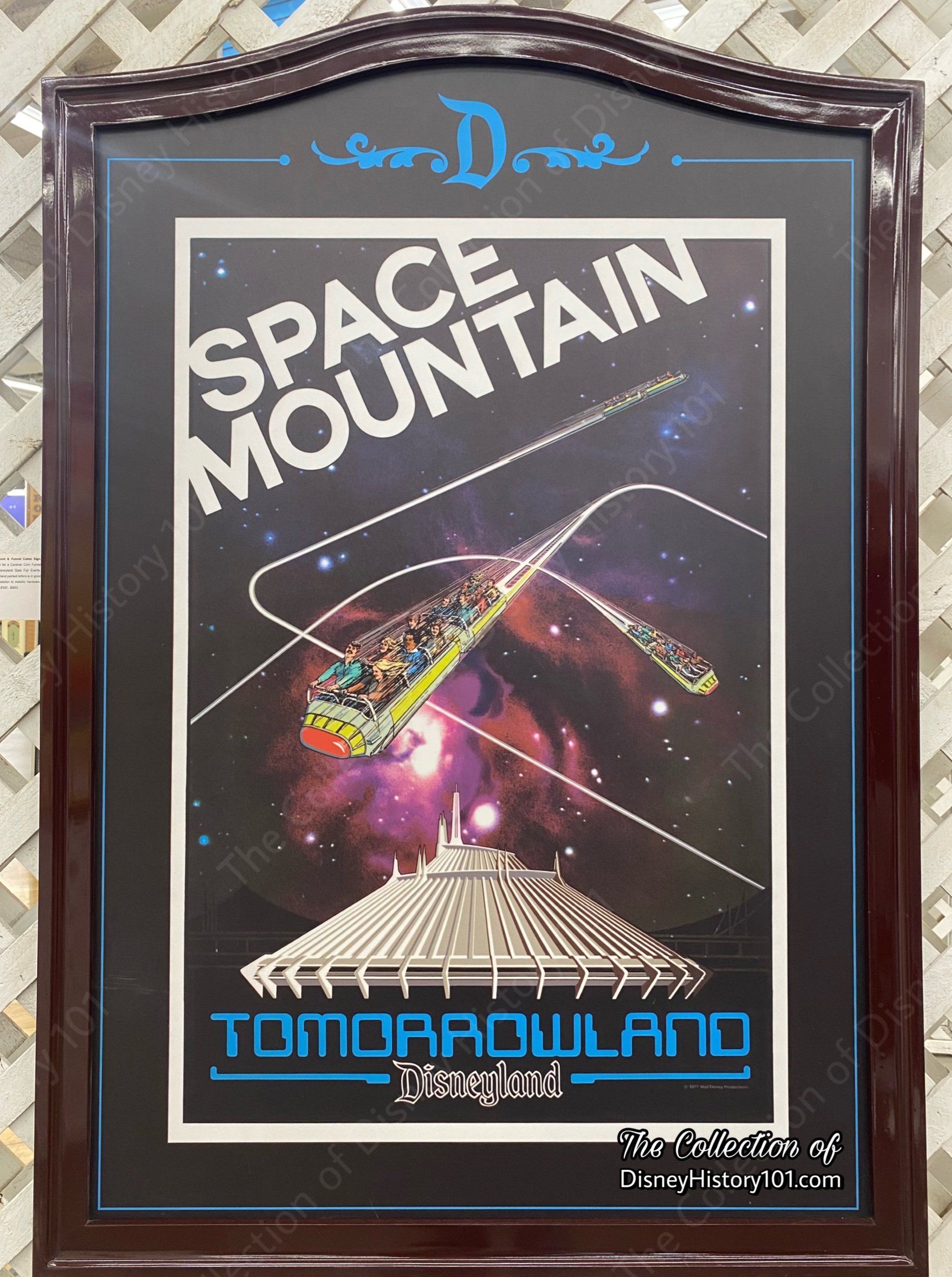
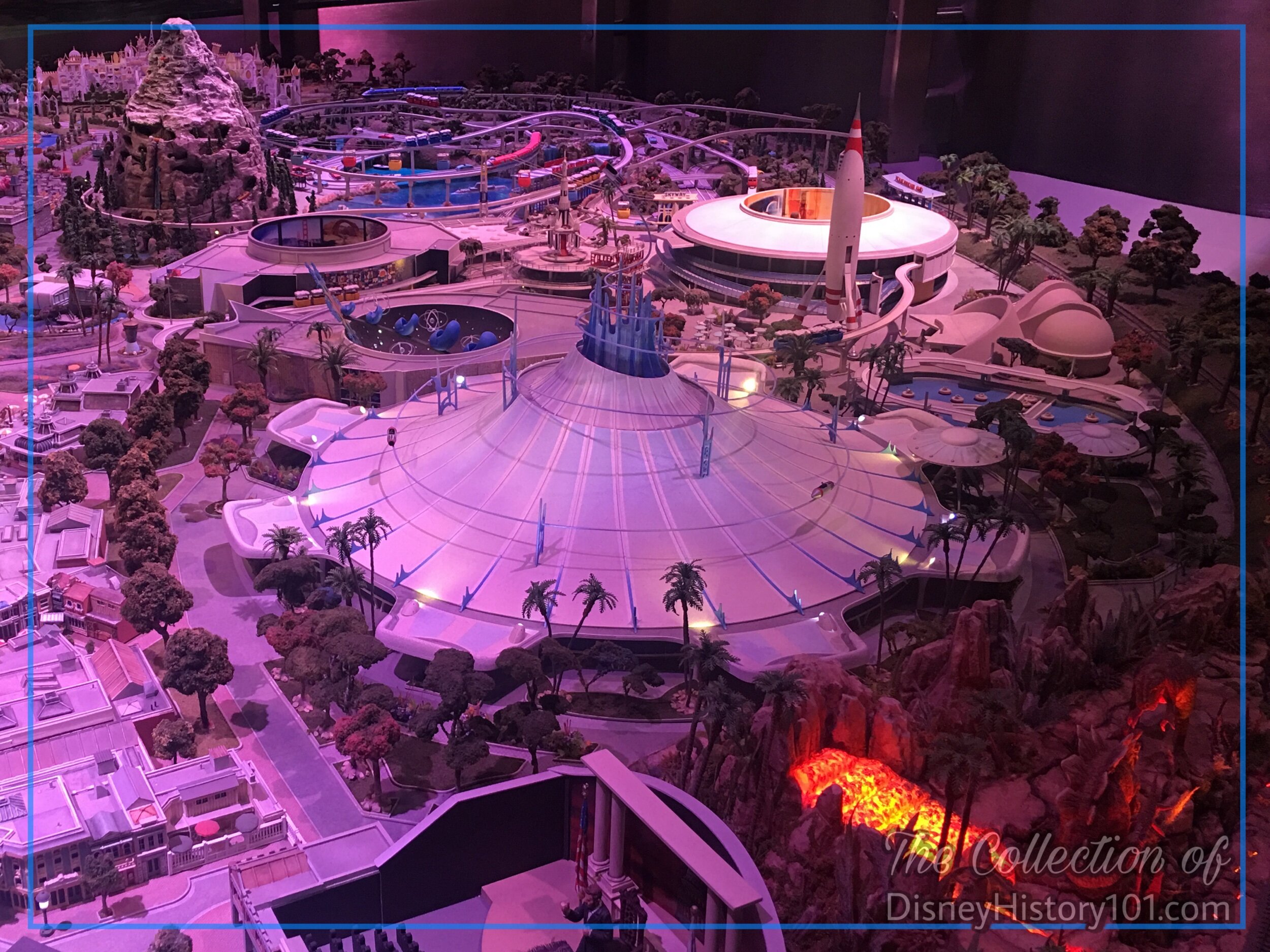
Space Mountain (of Walt’s imagination), Walt Disney Family Museum
While new “Overlays” add new dimensions of adventure to Space Mountain, there’s at least one location where guests can enjoy the Space Mountain of John Hench’s imagination (at least, in miniature form) - The Walt Disney Family Museum in San Francisco, California!
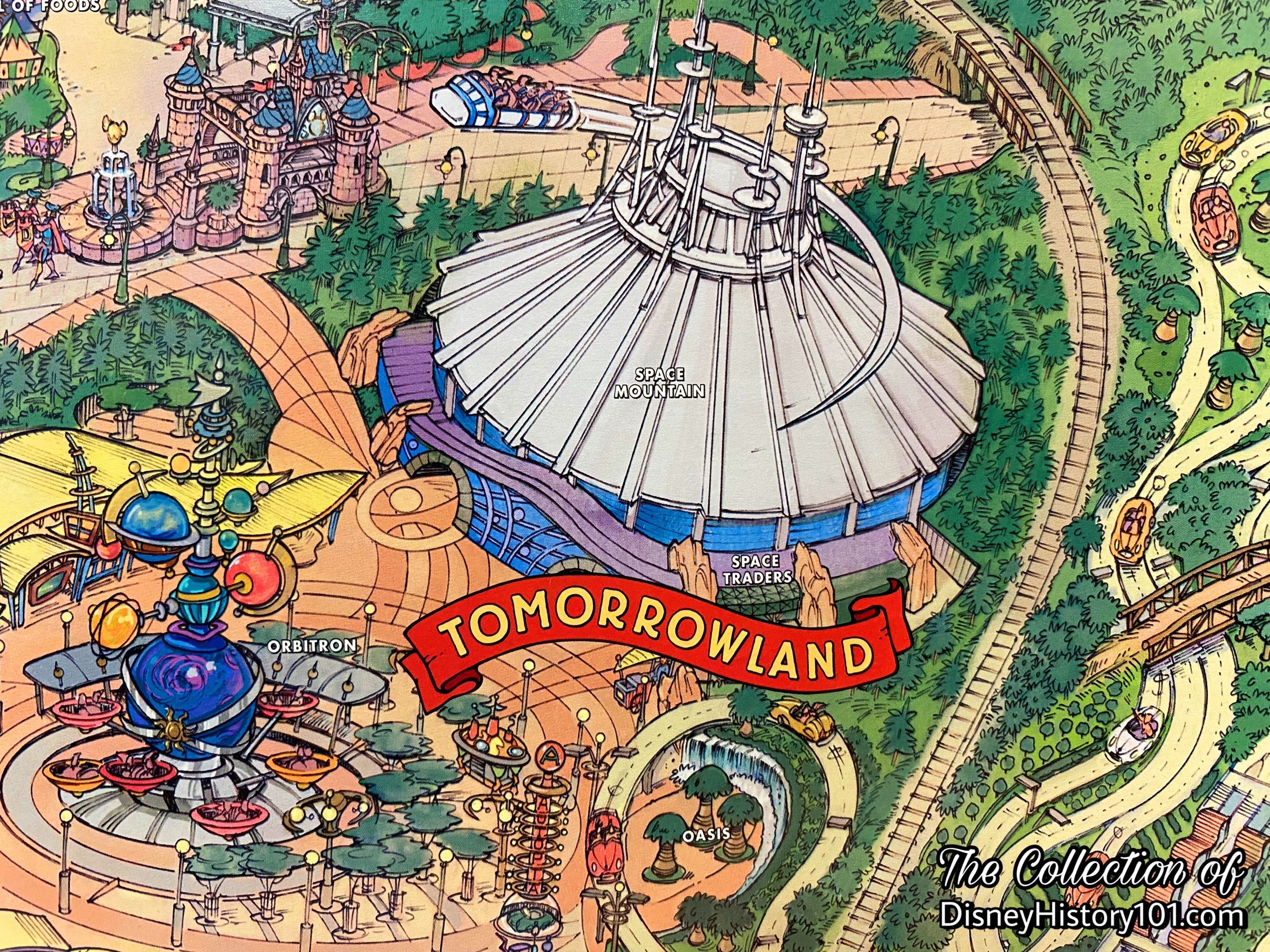
Space Mountain at Hong Kong Disneyland

